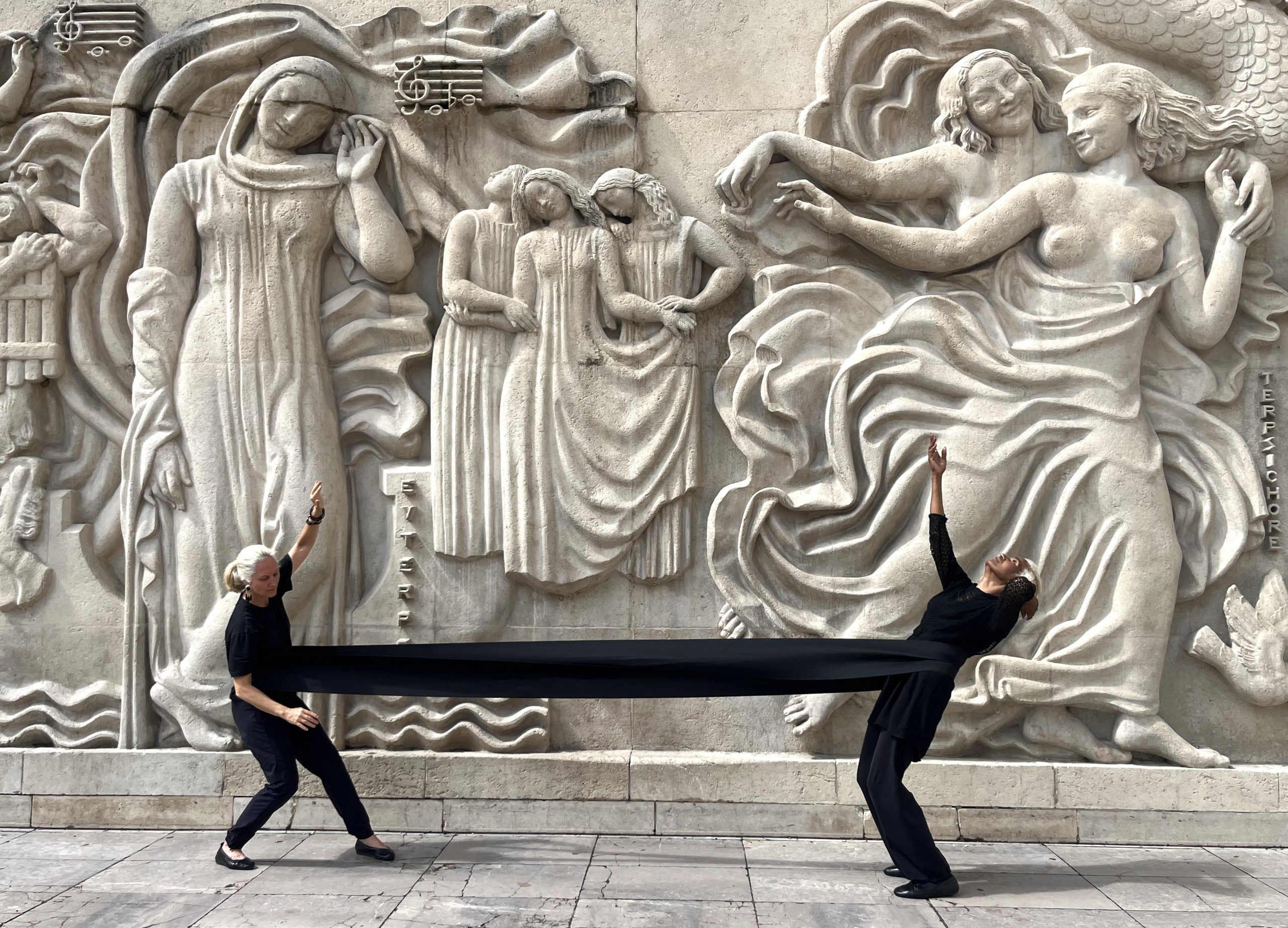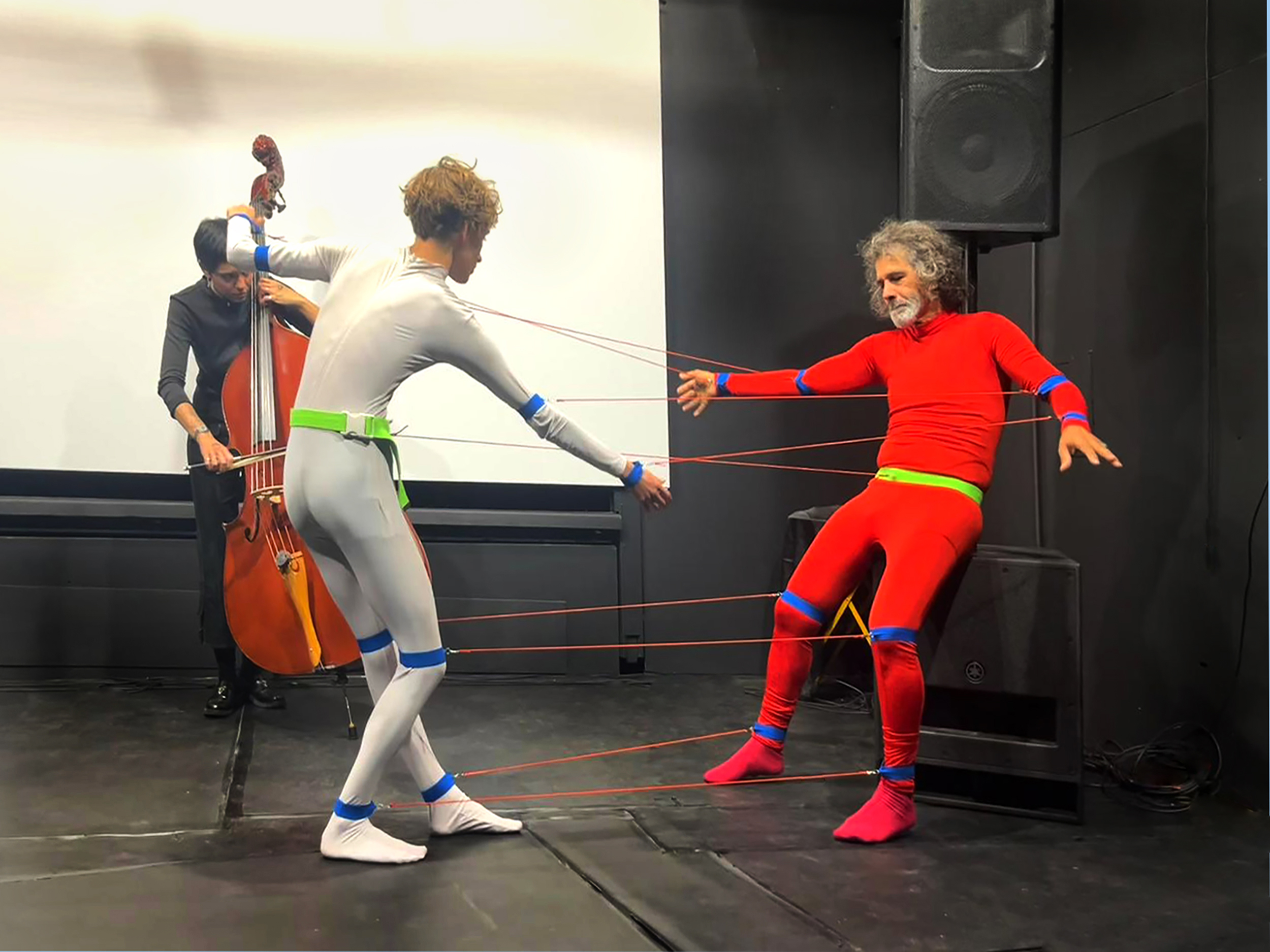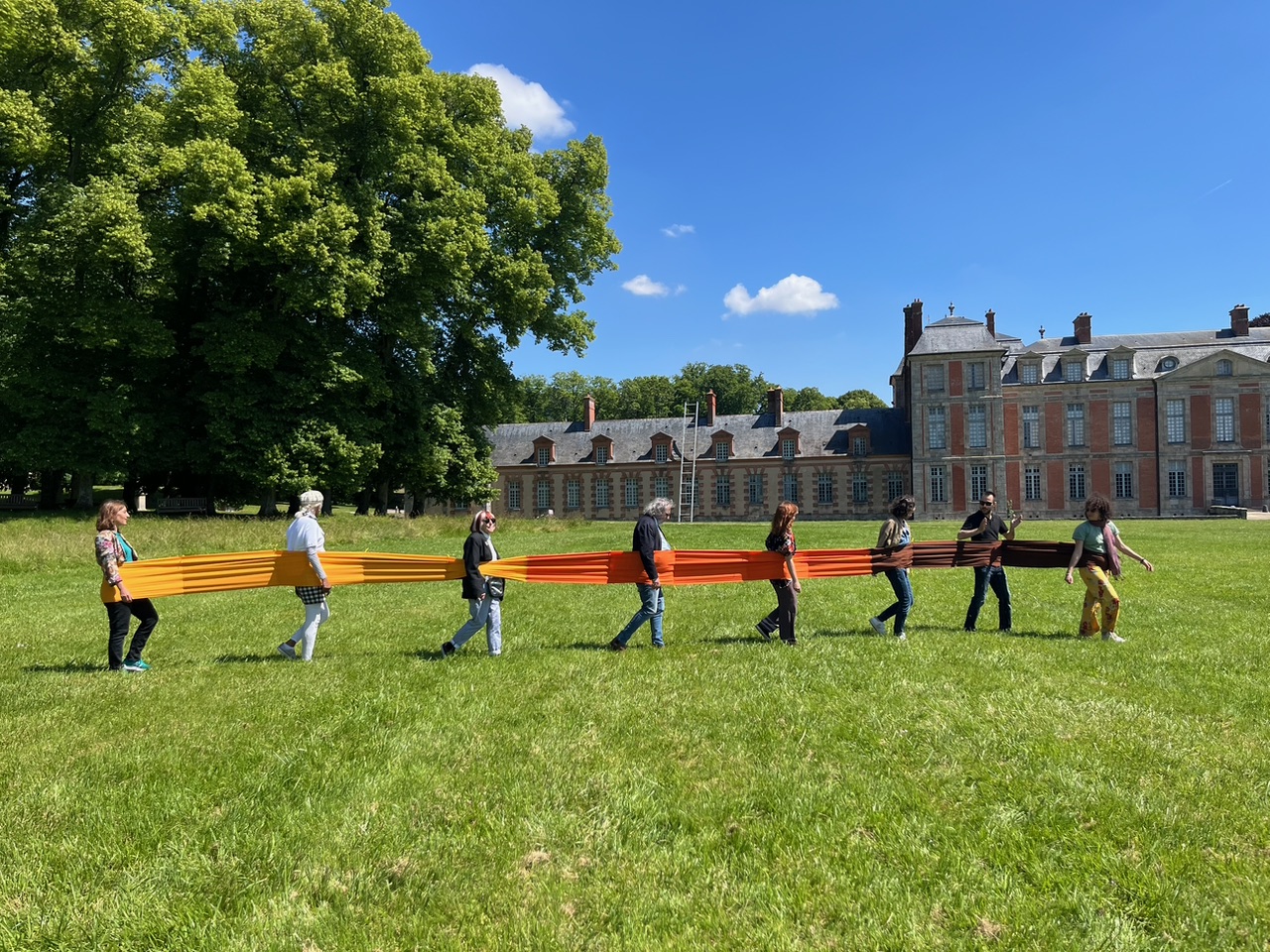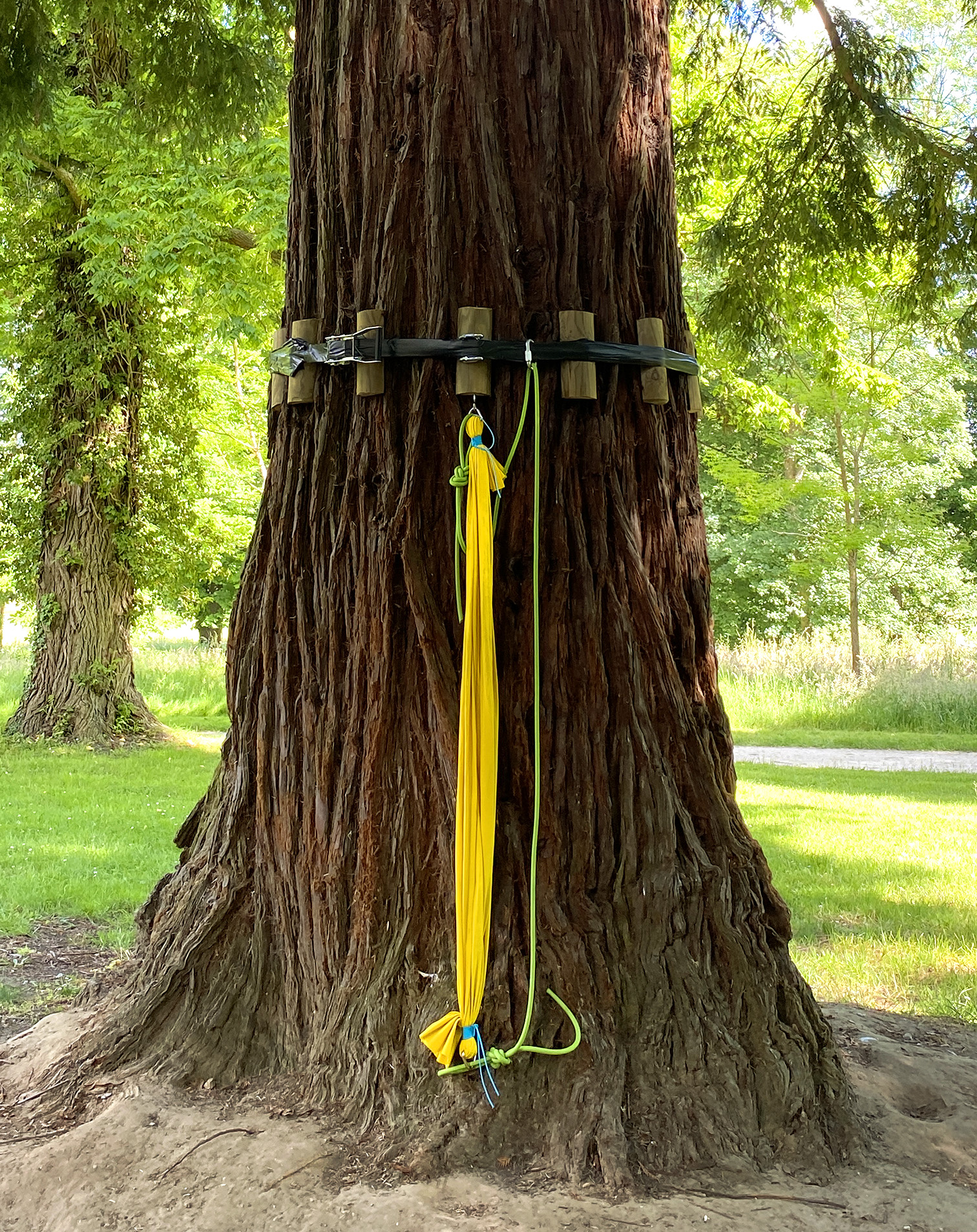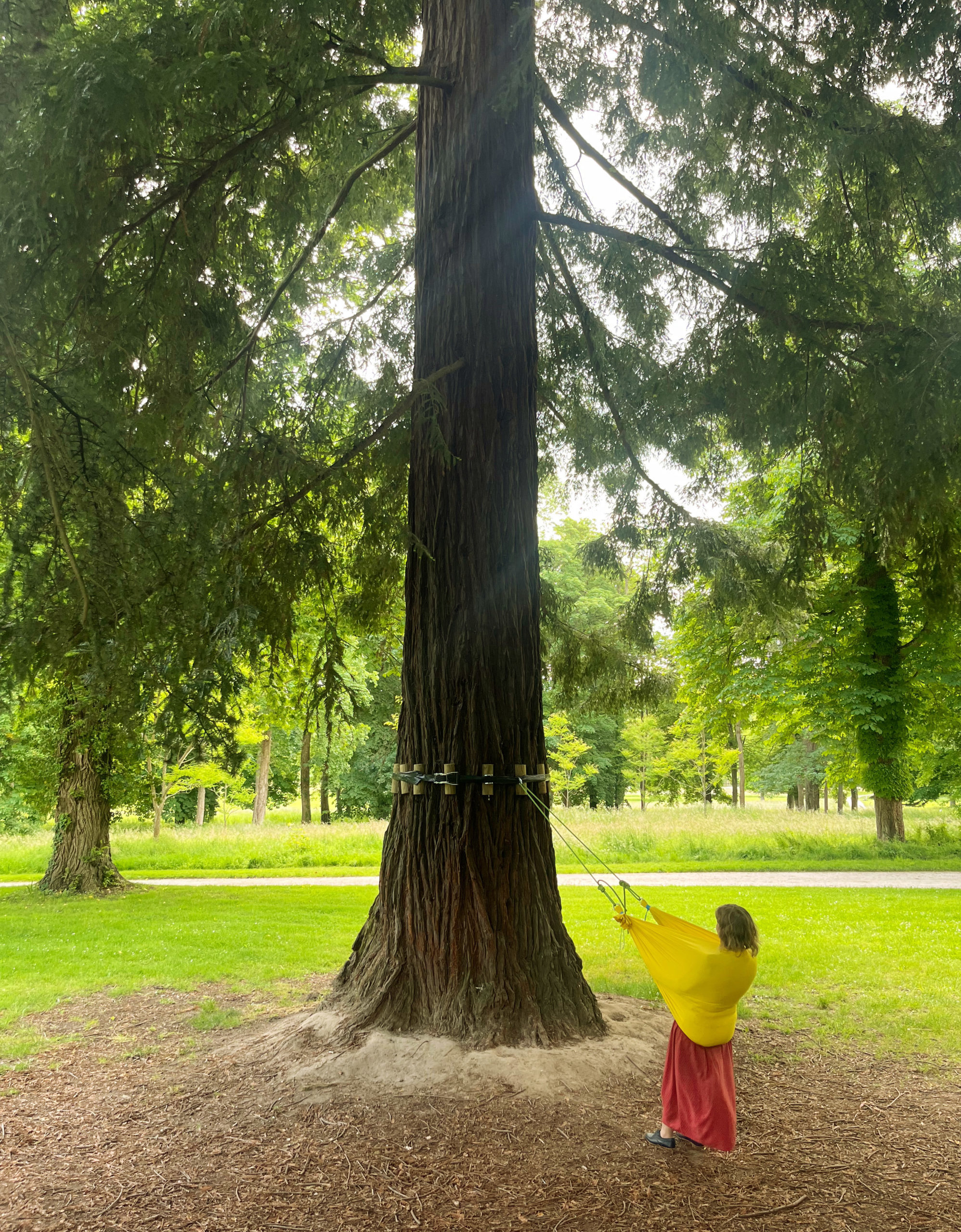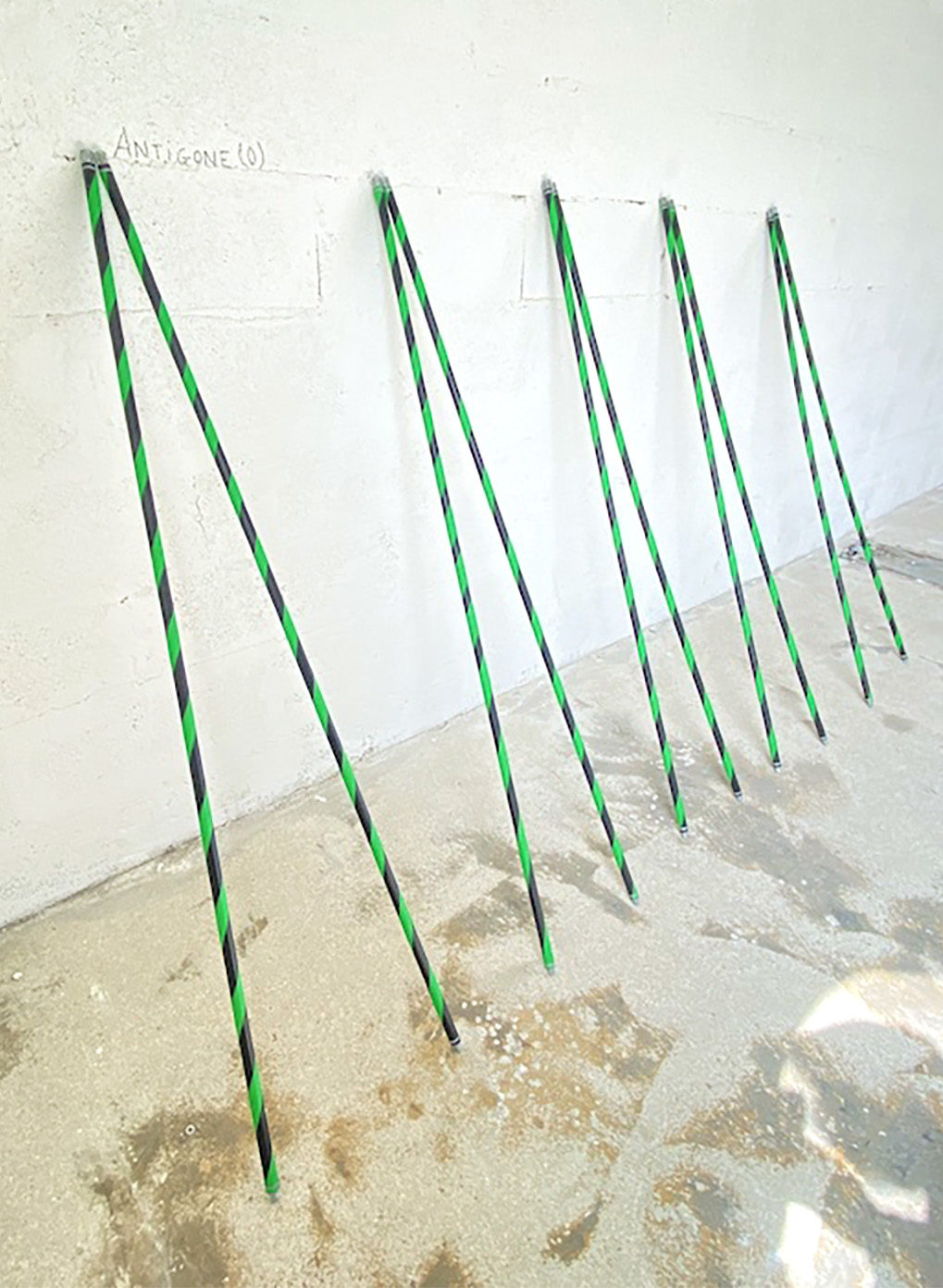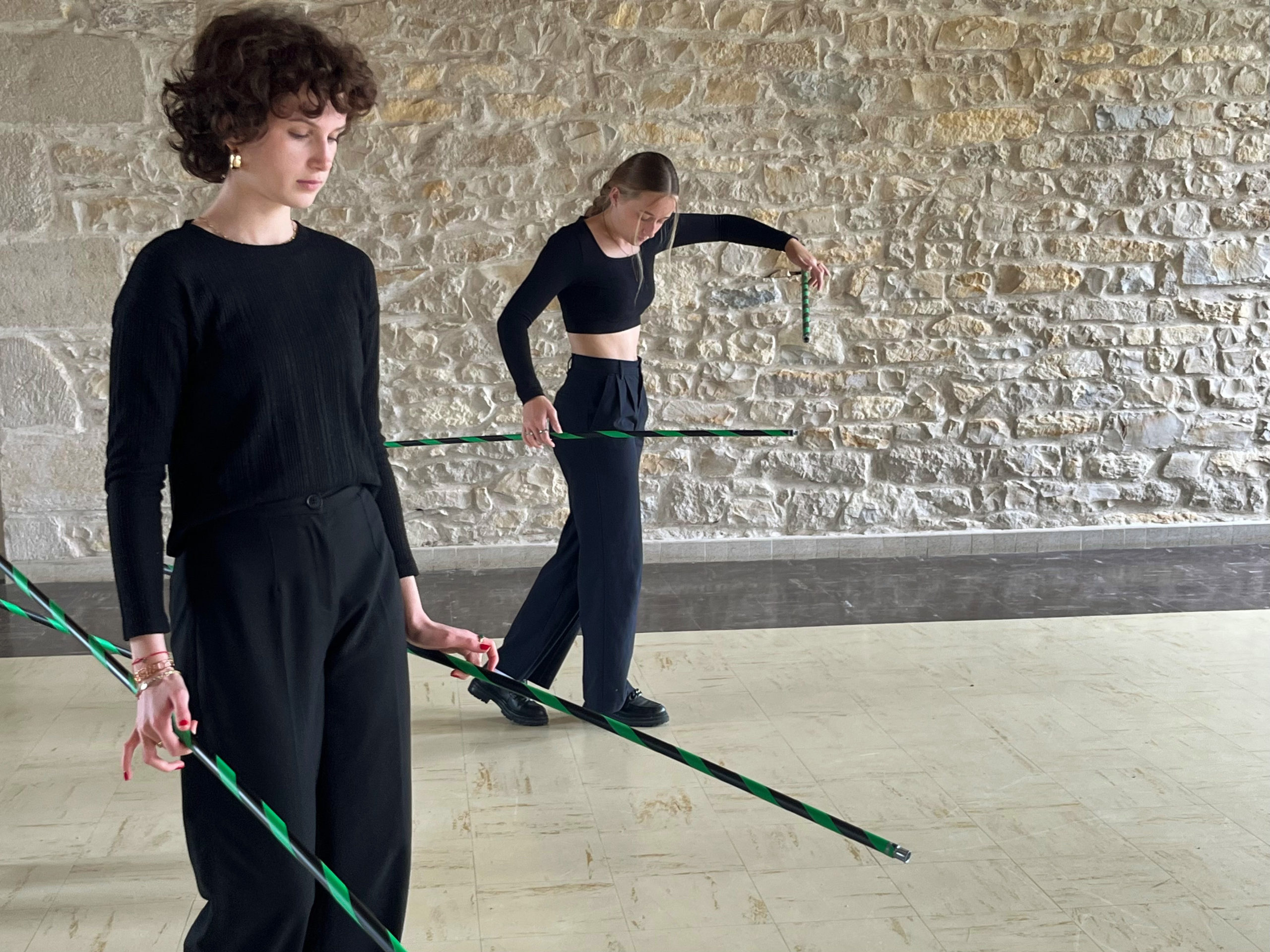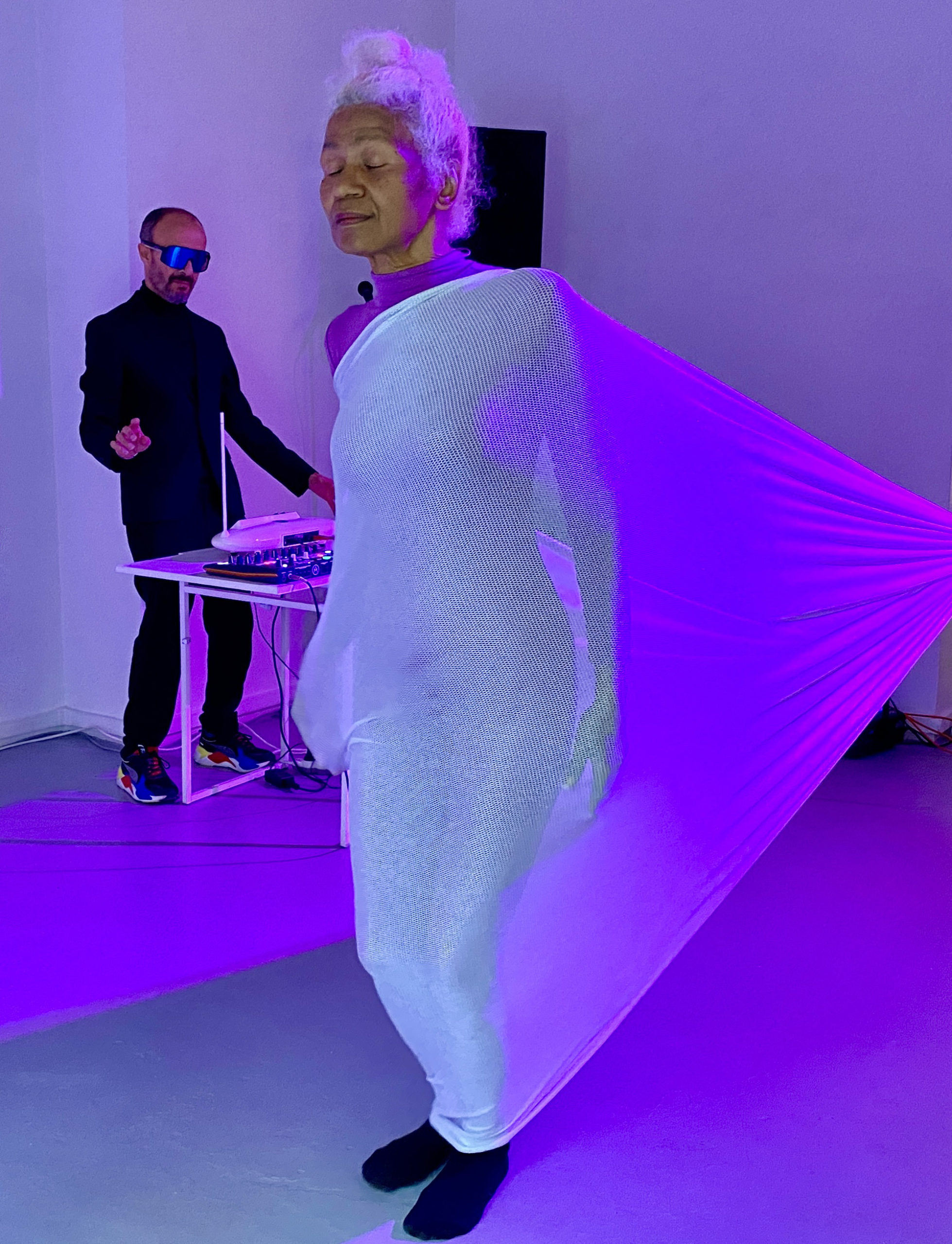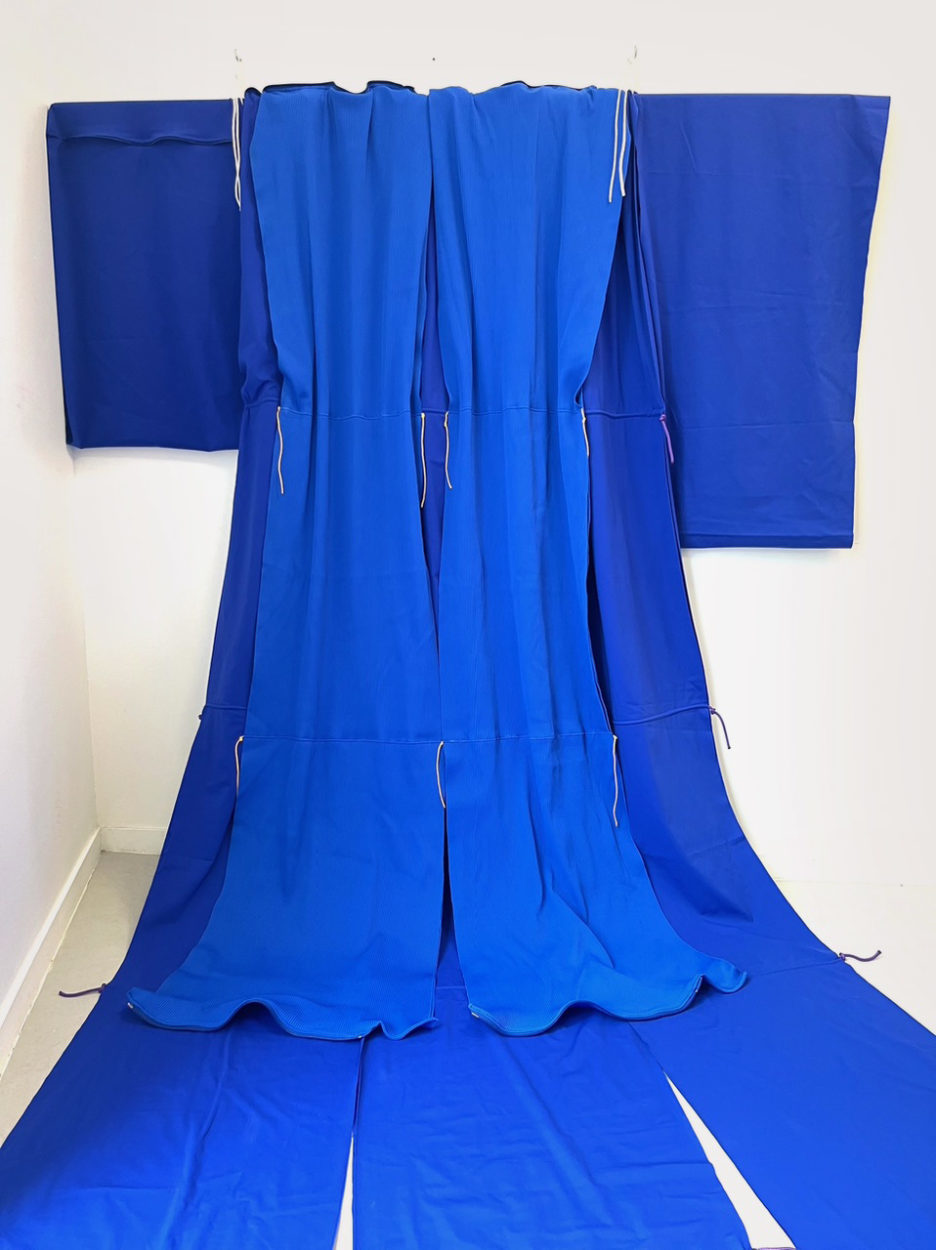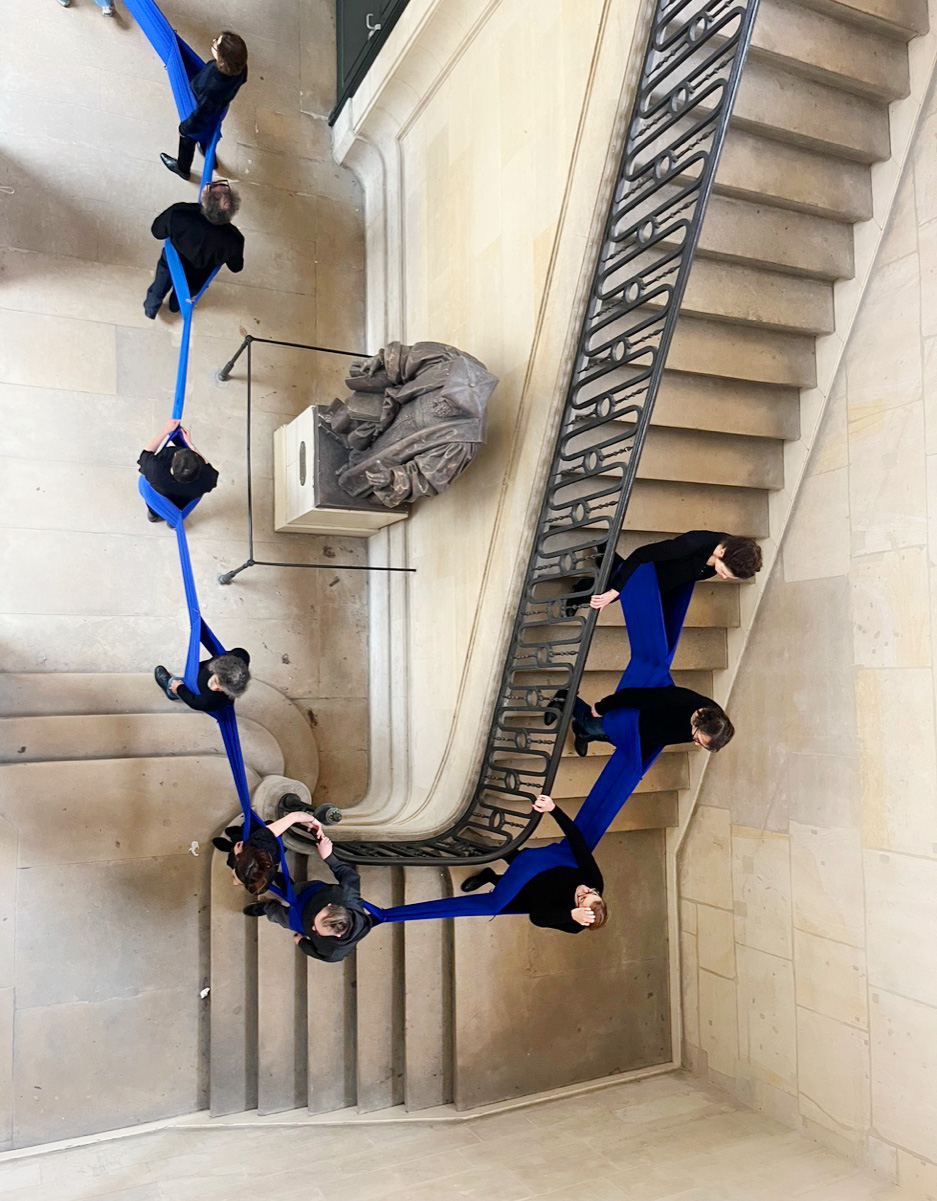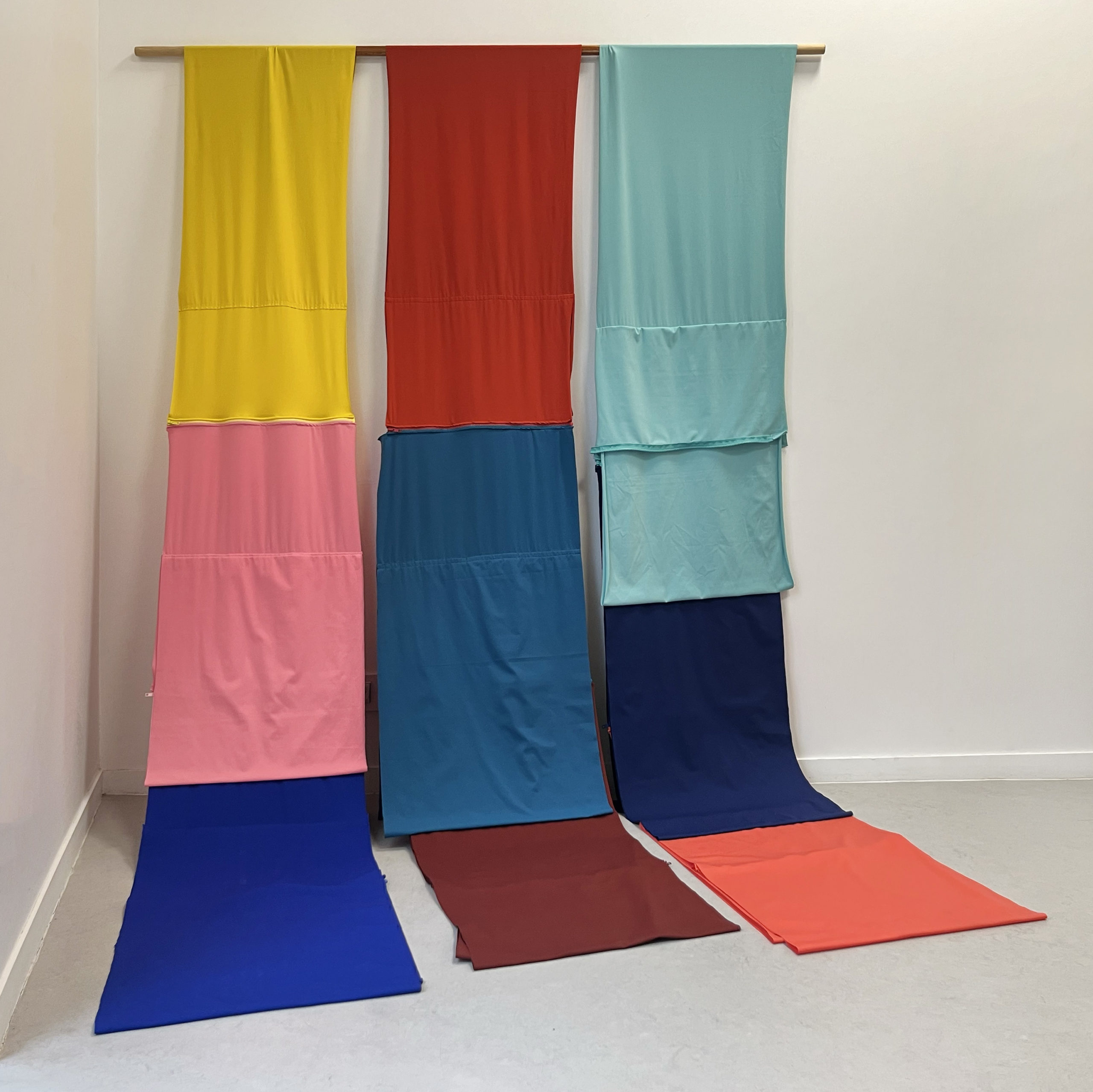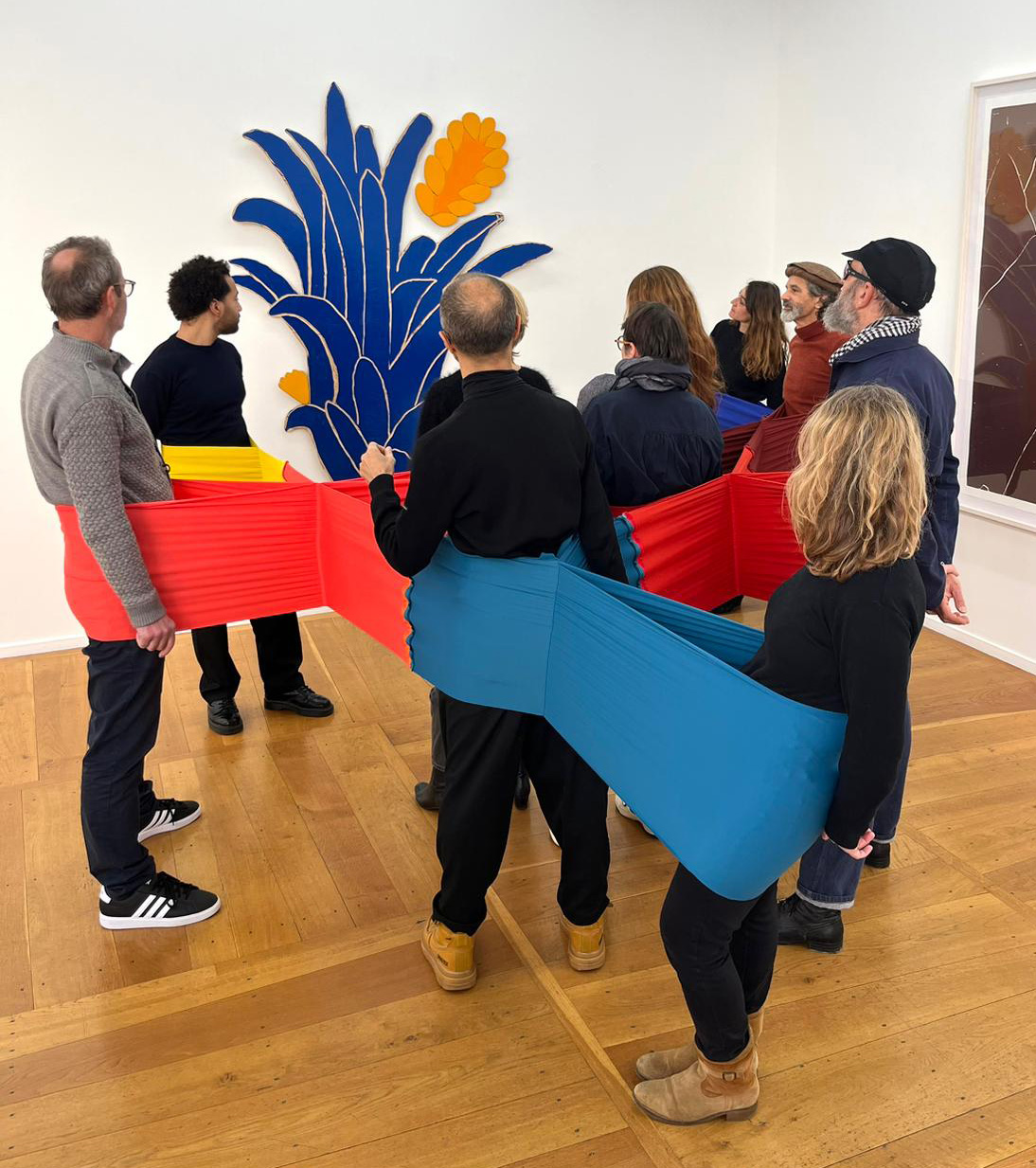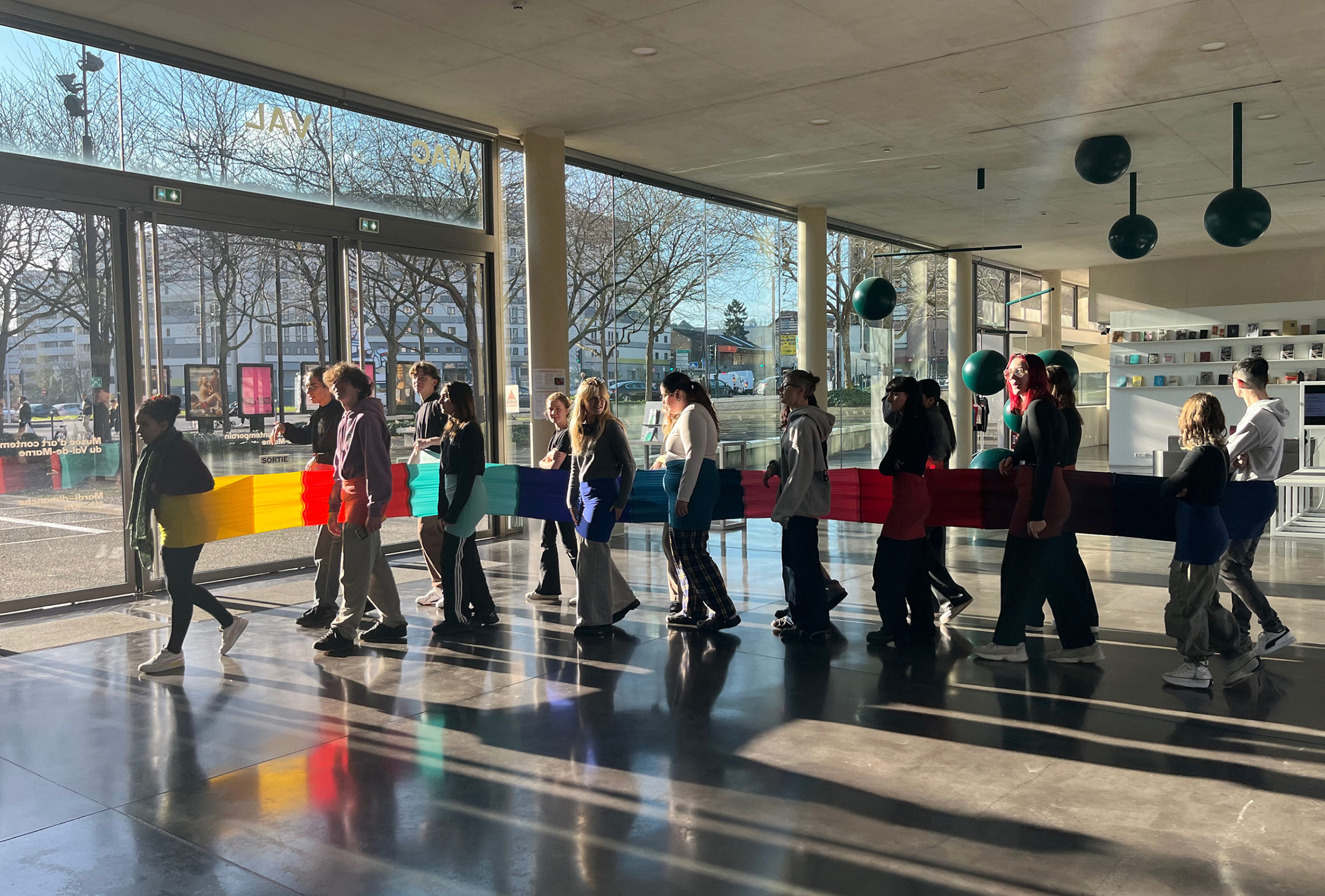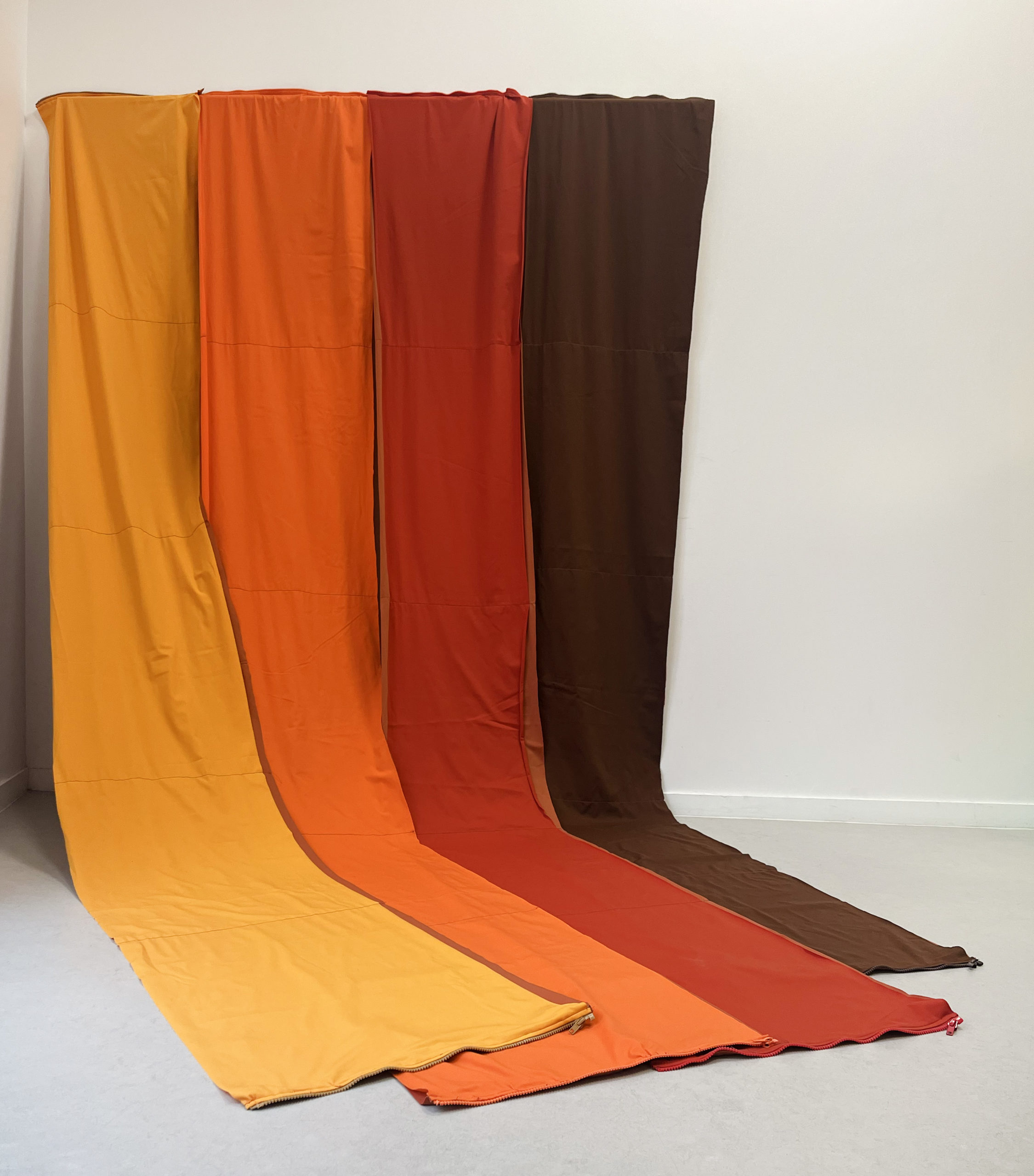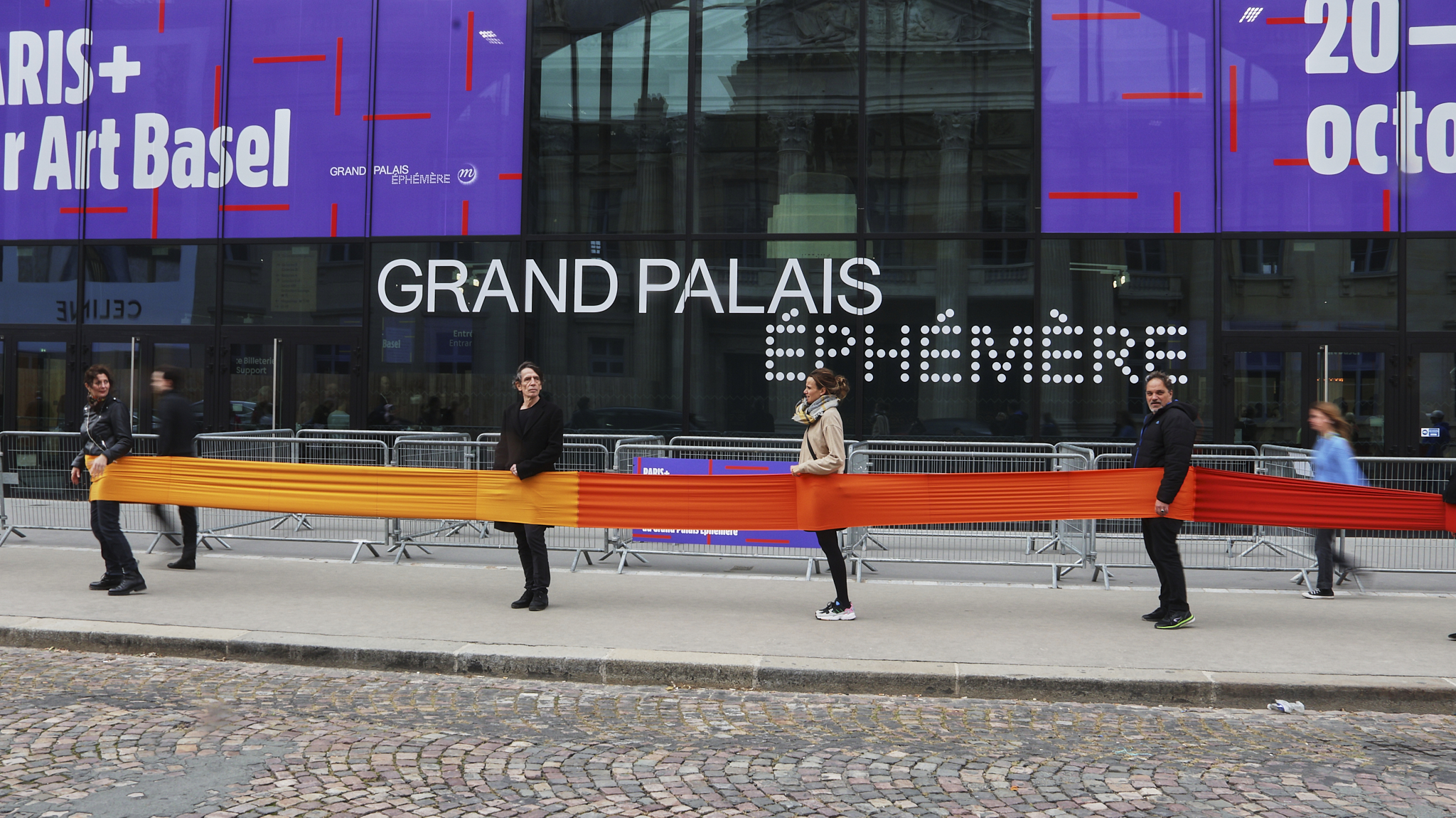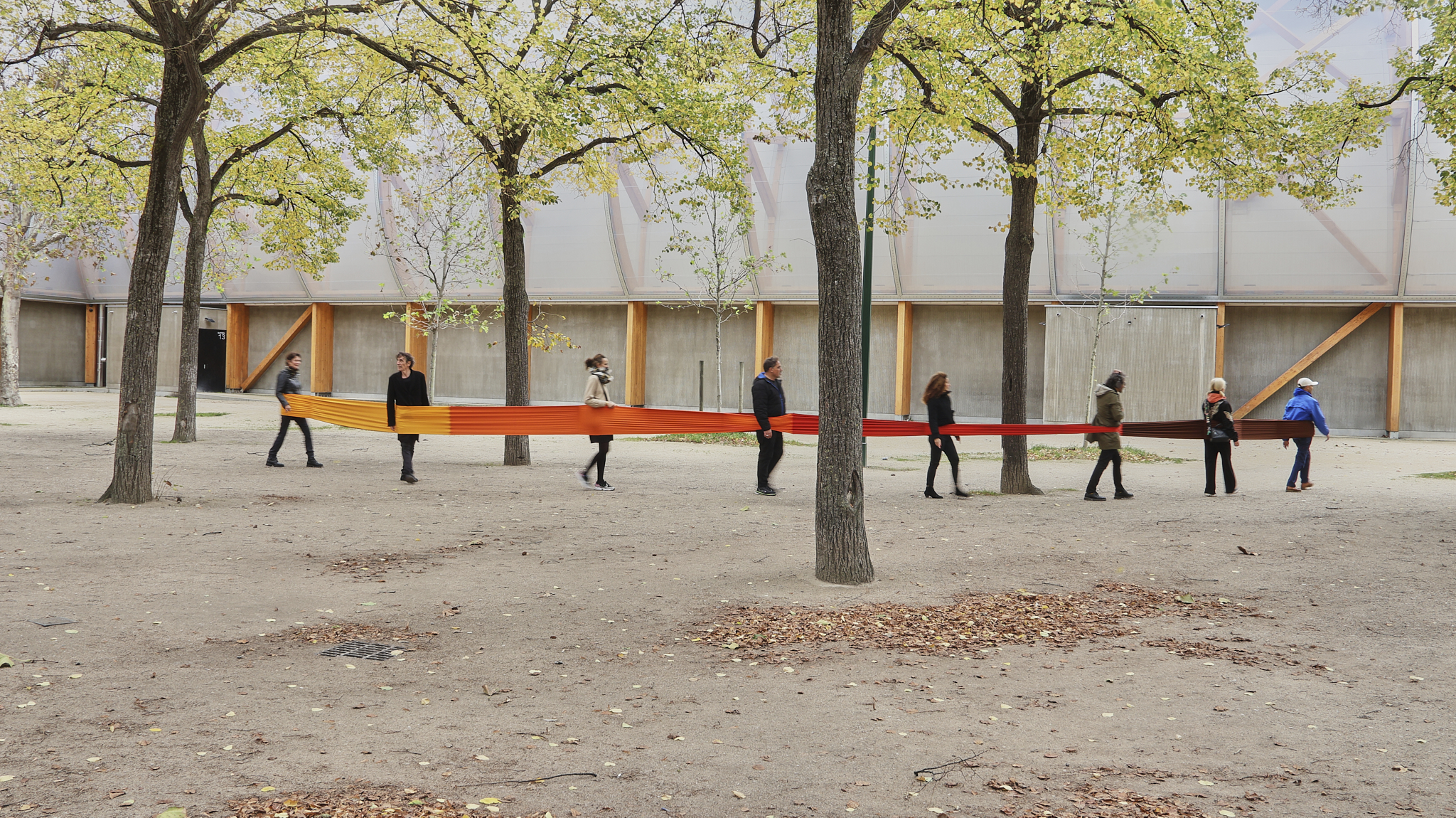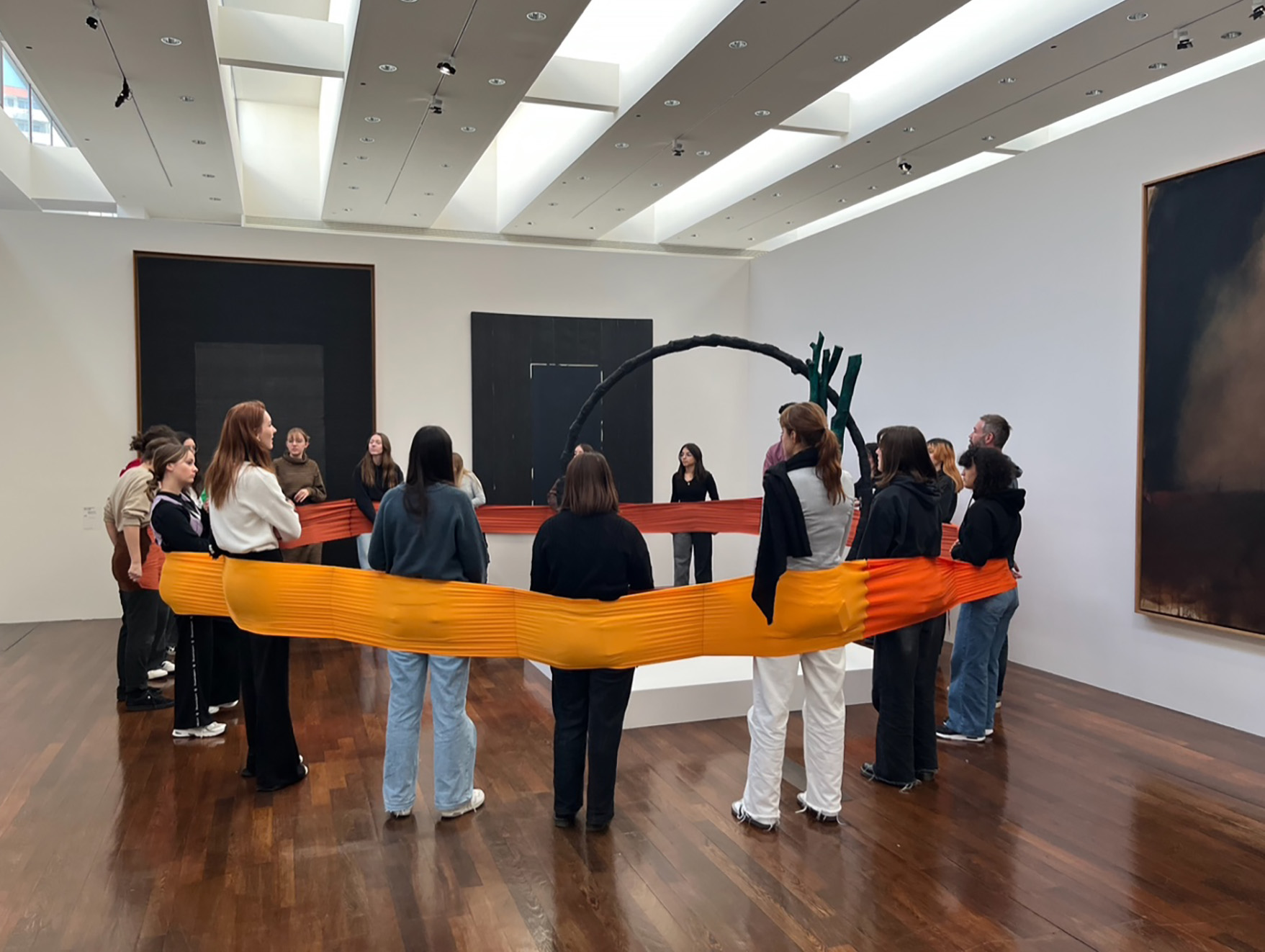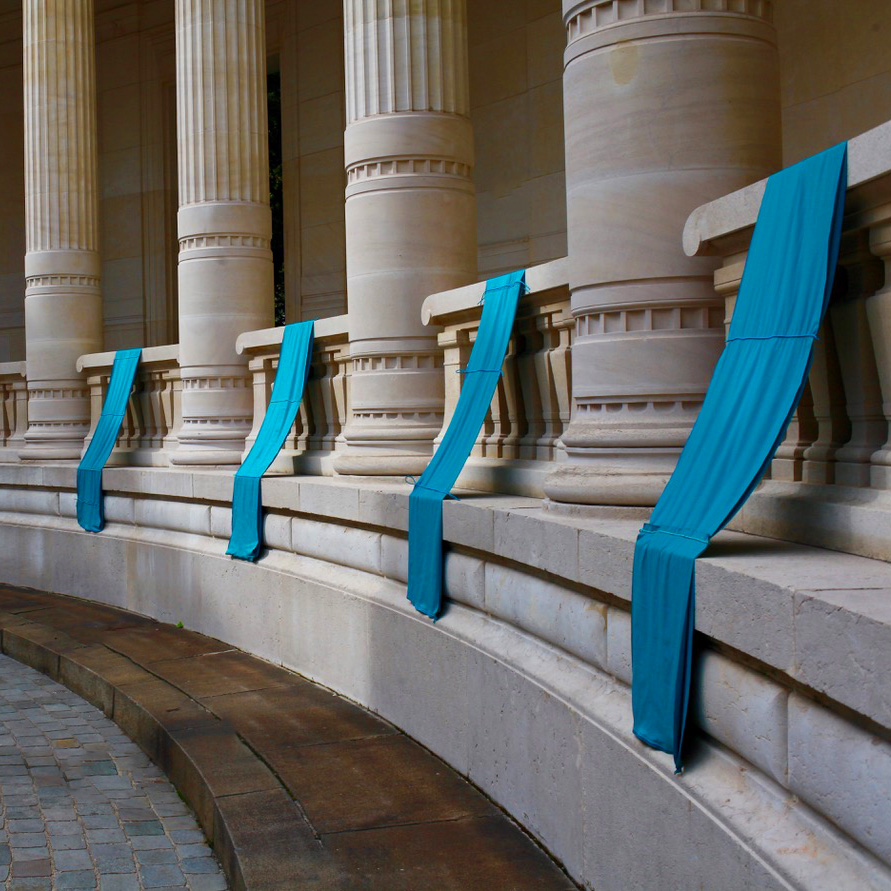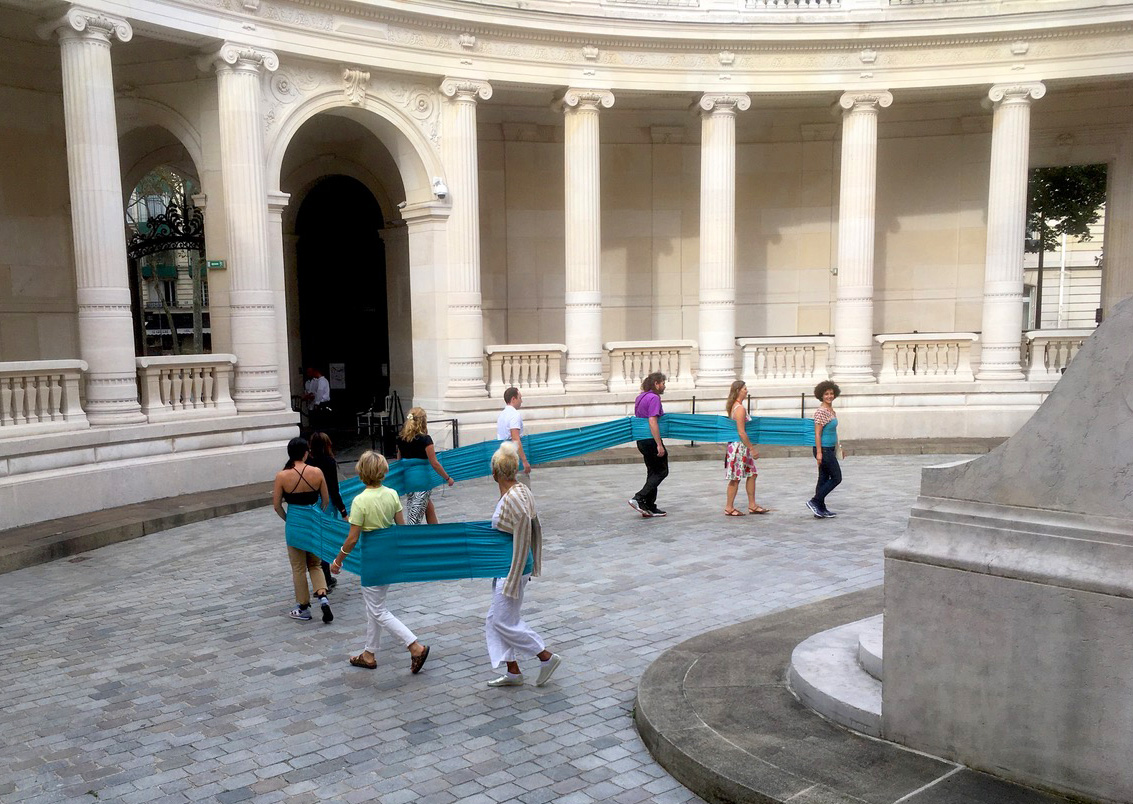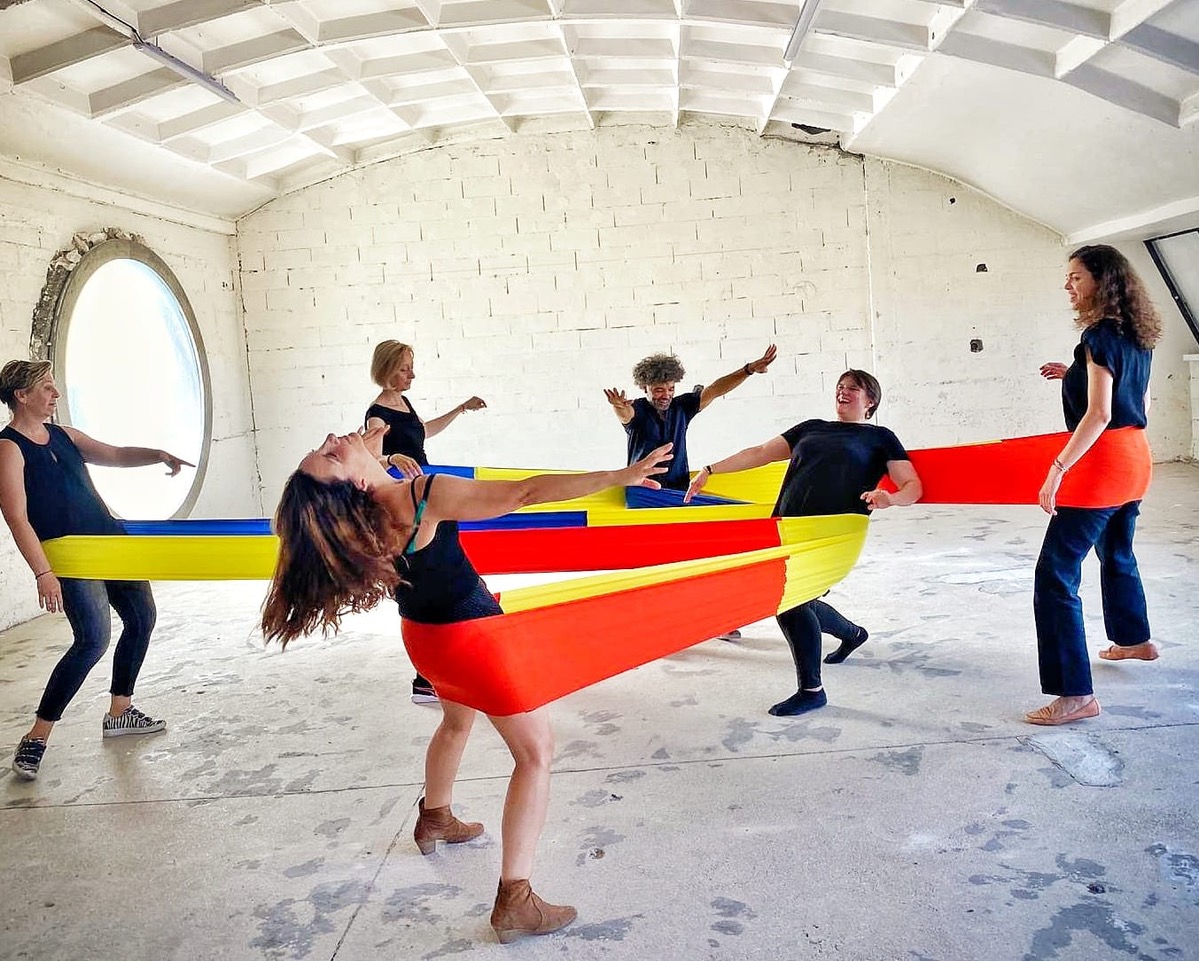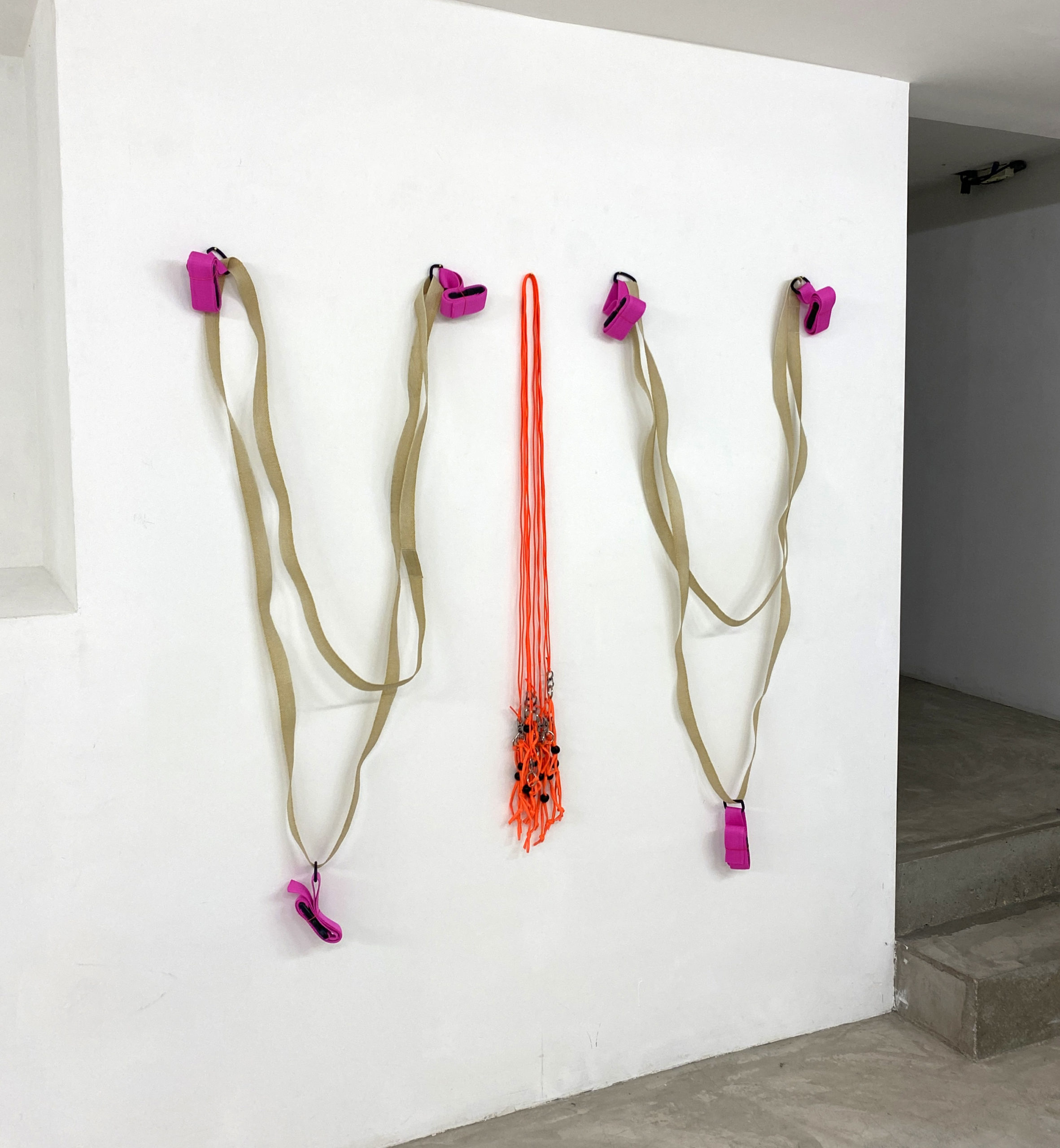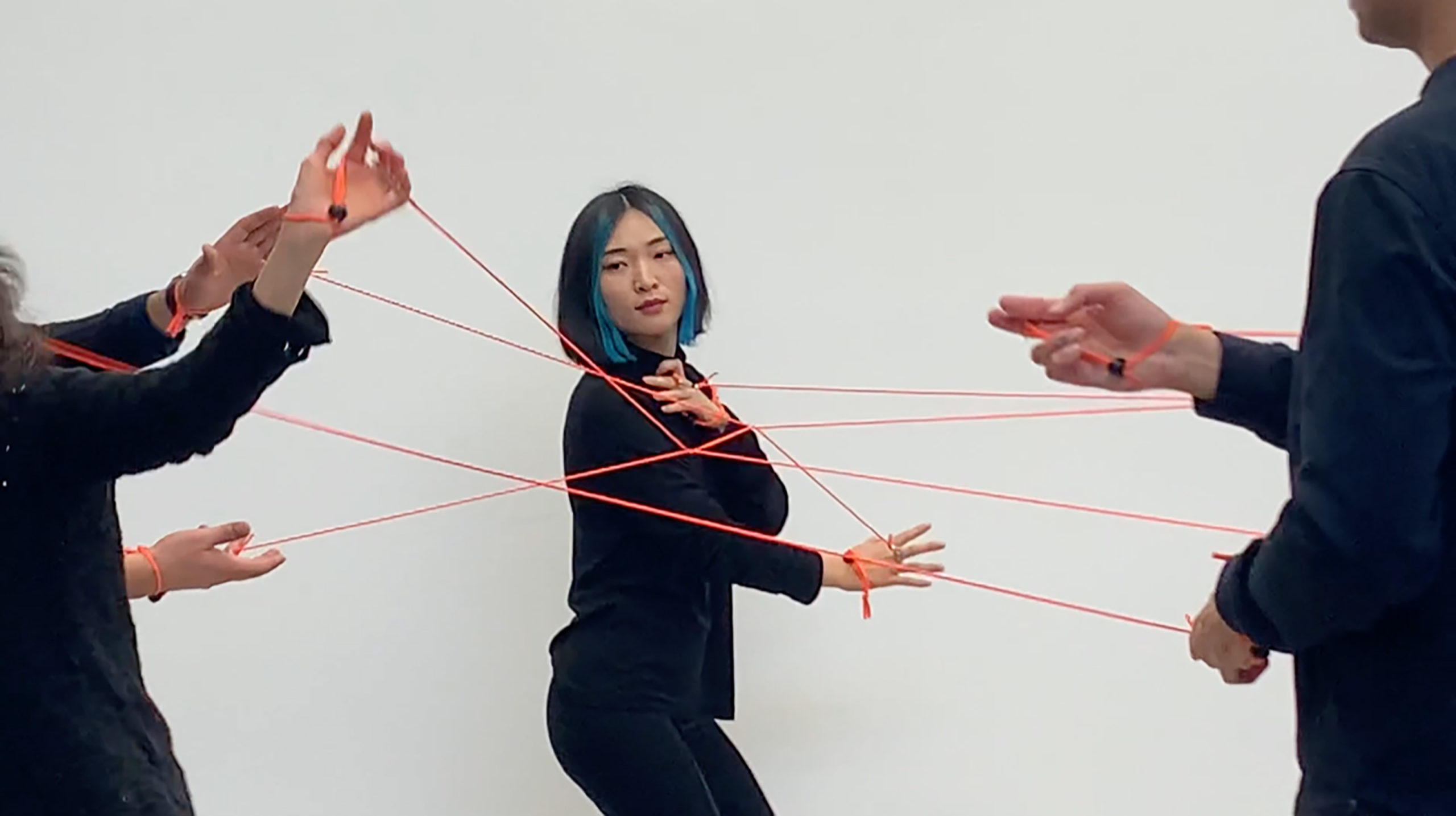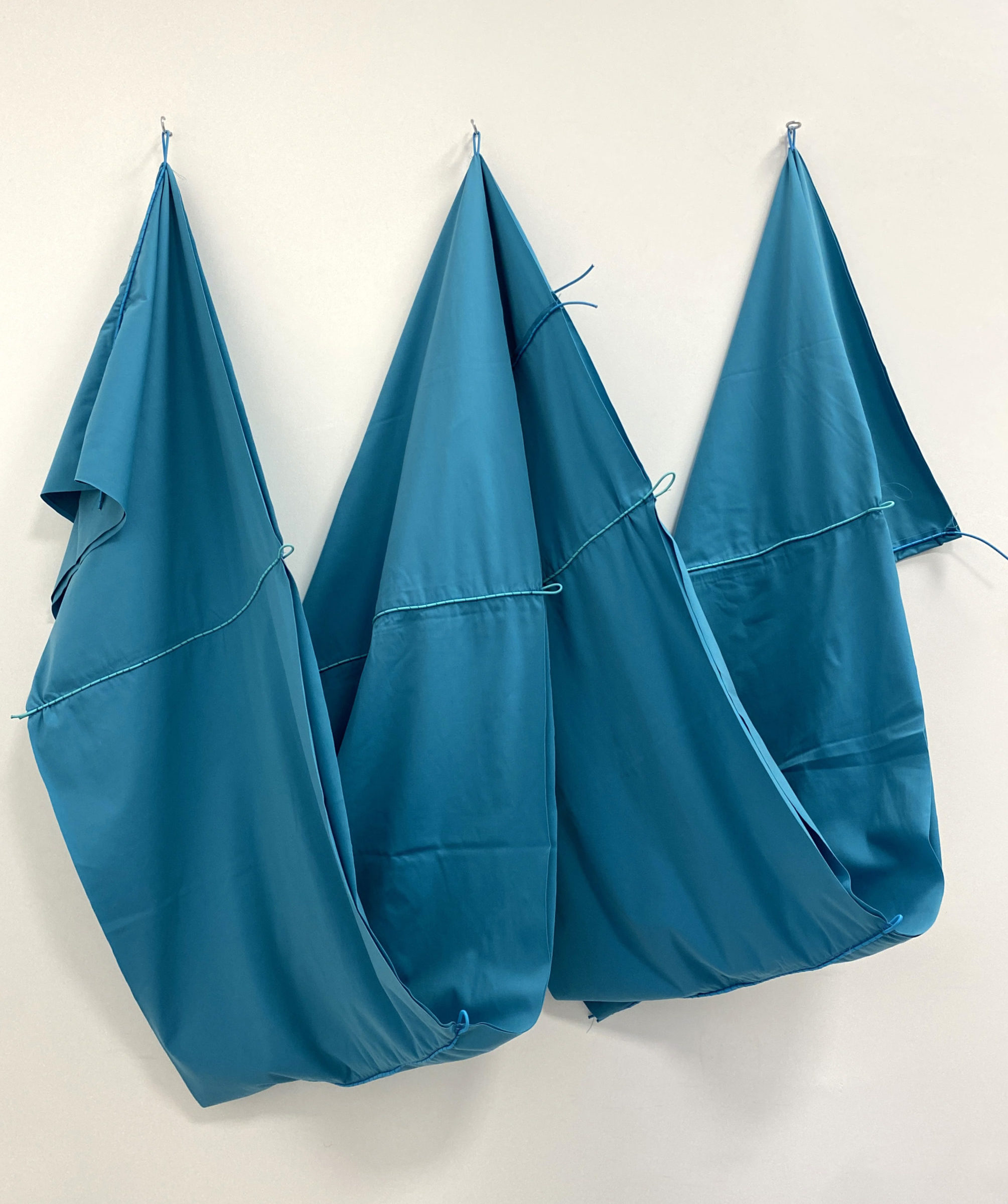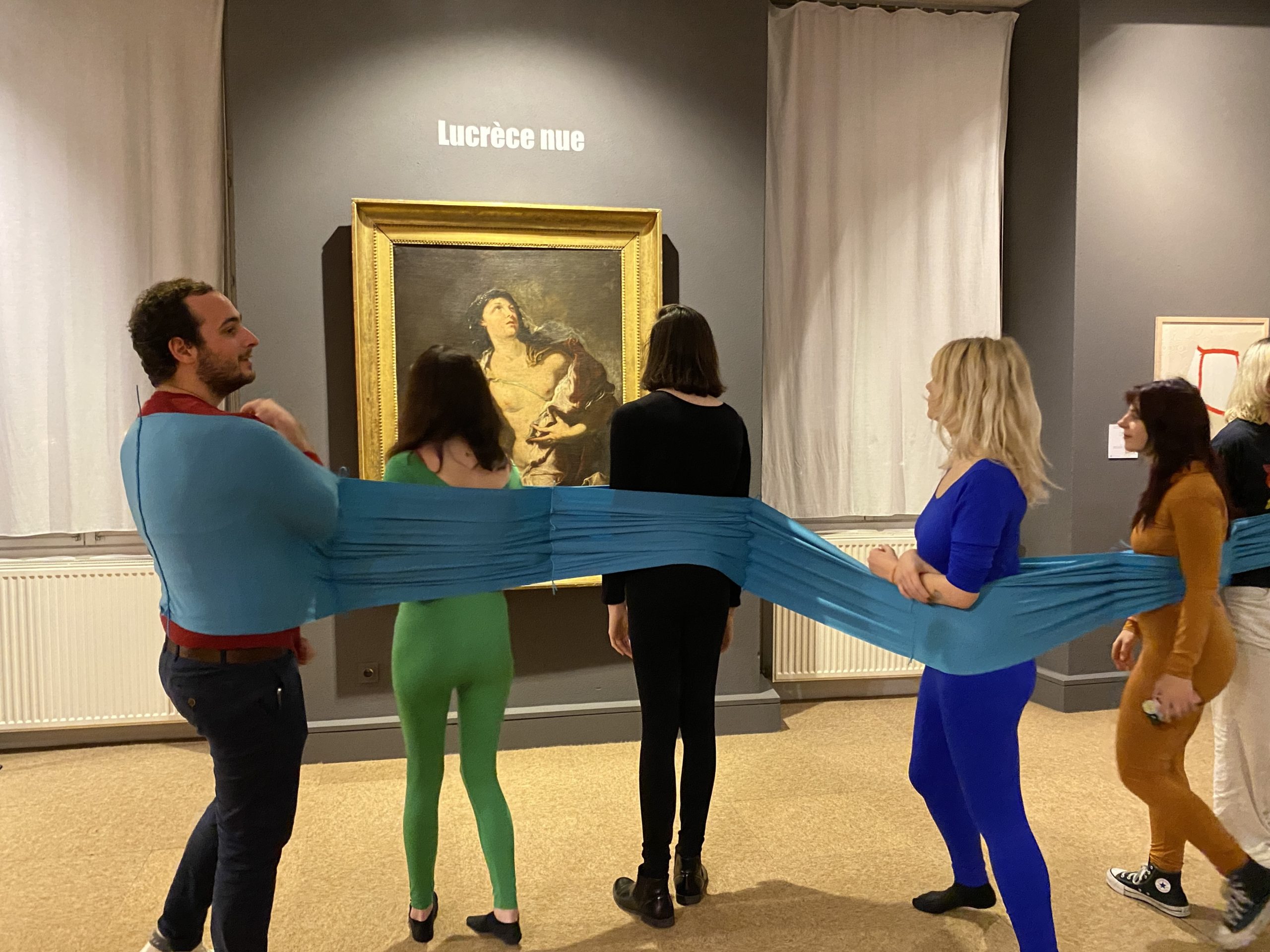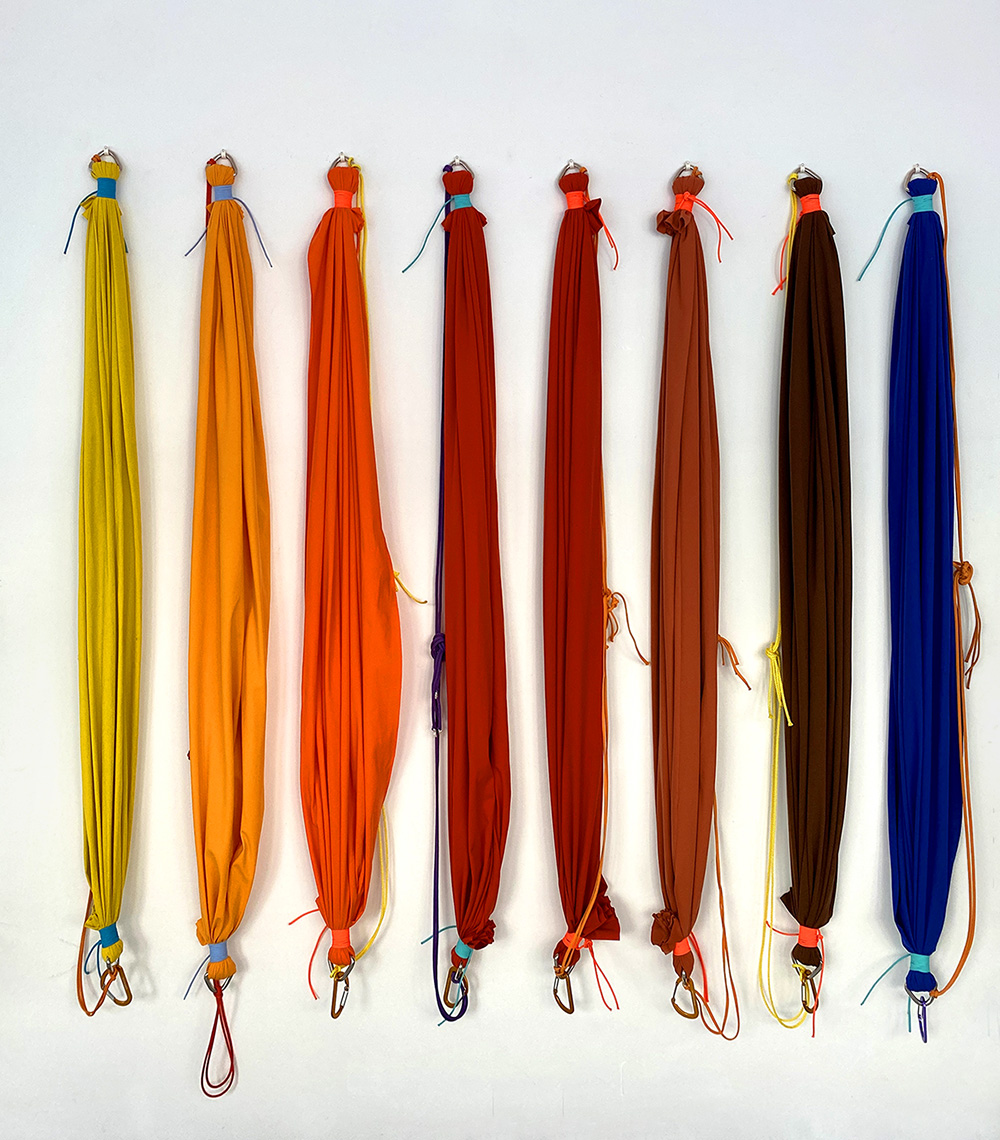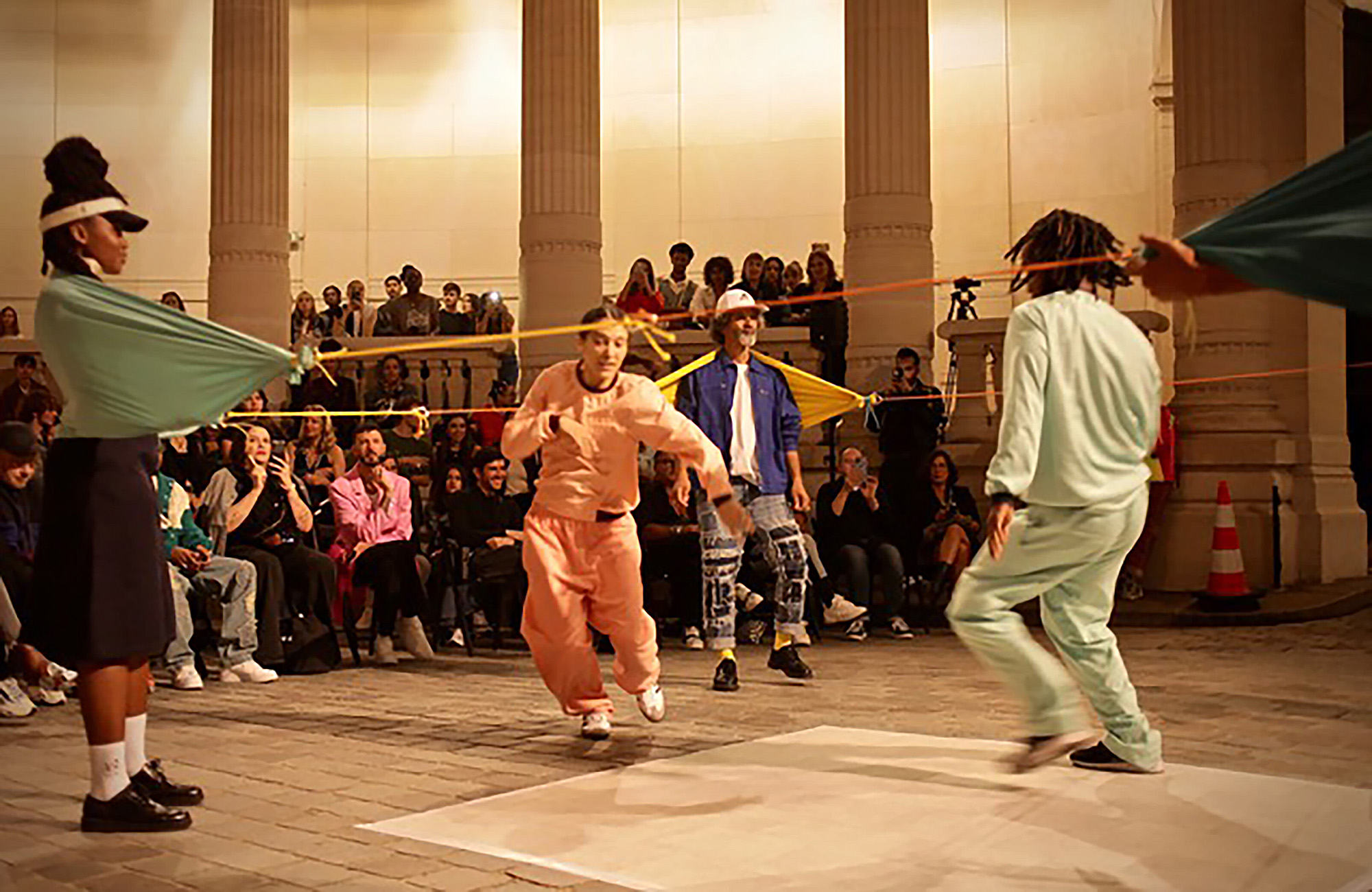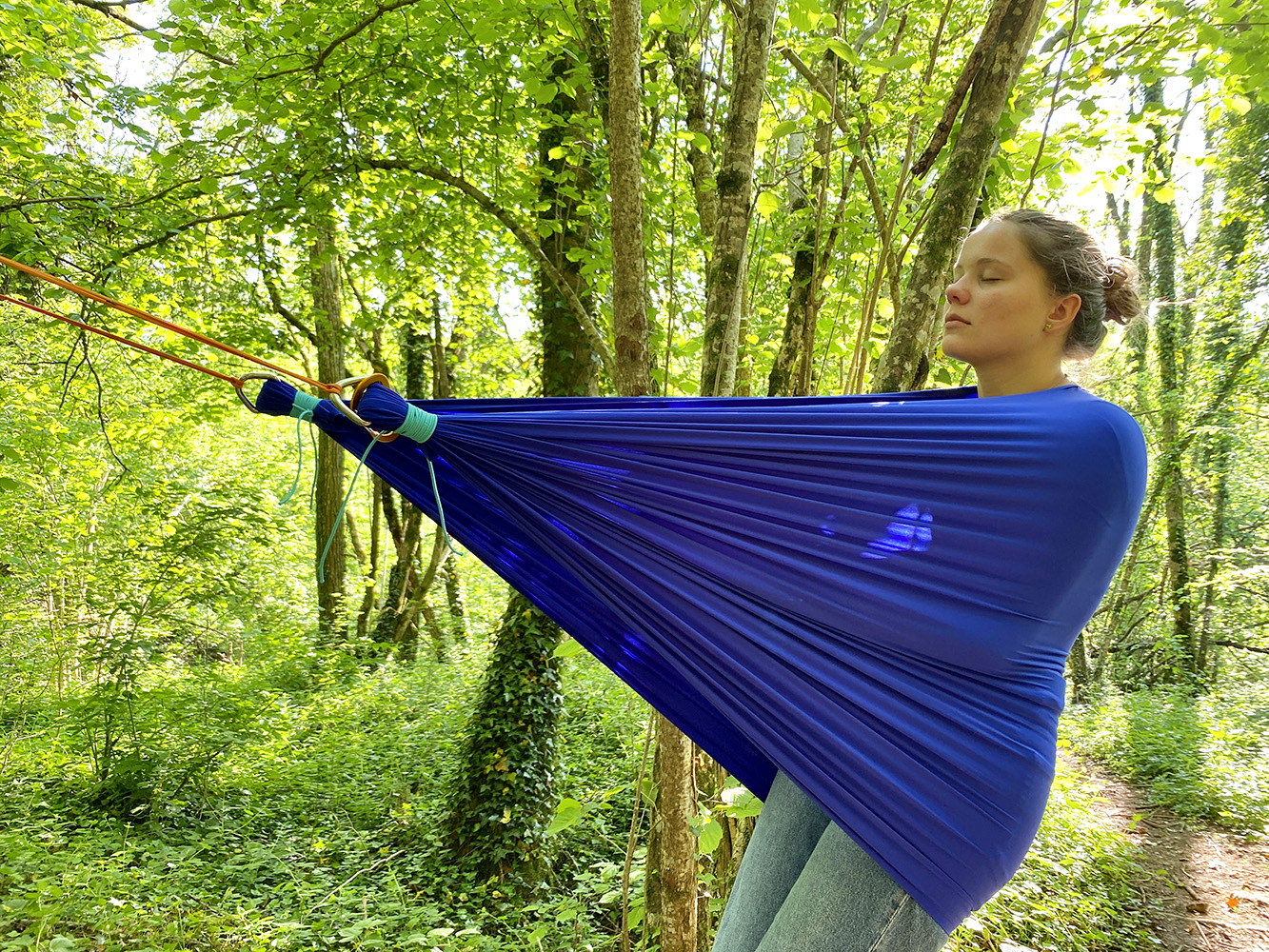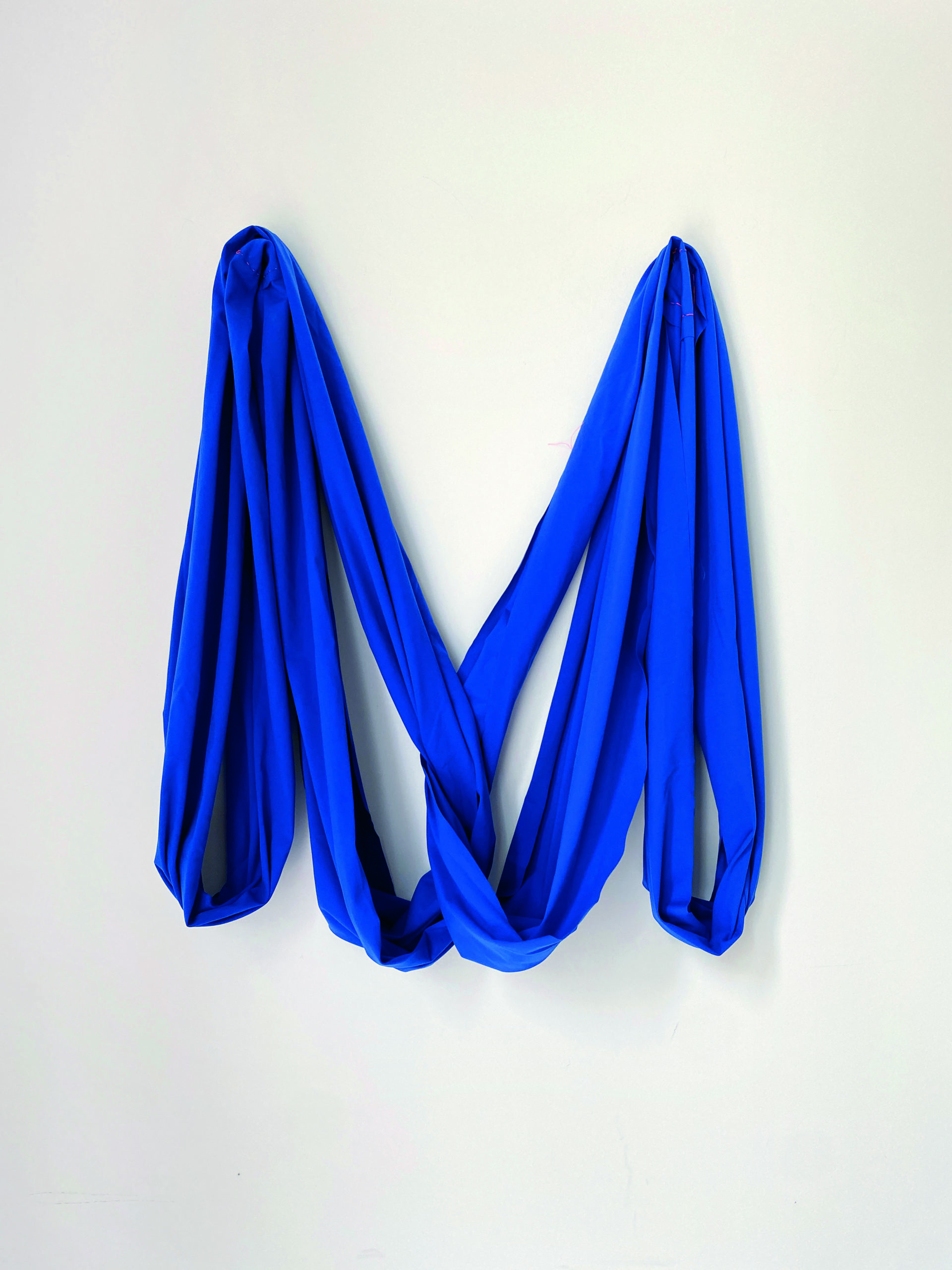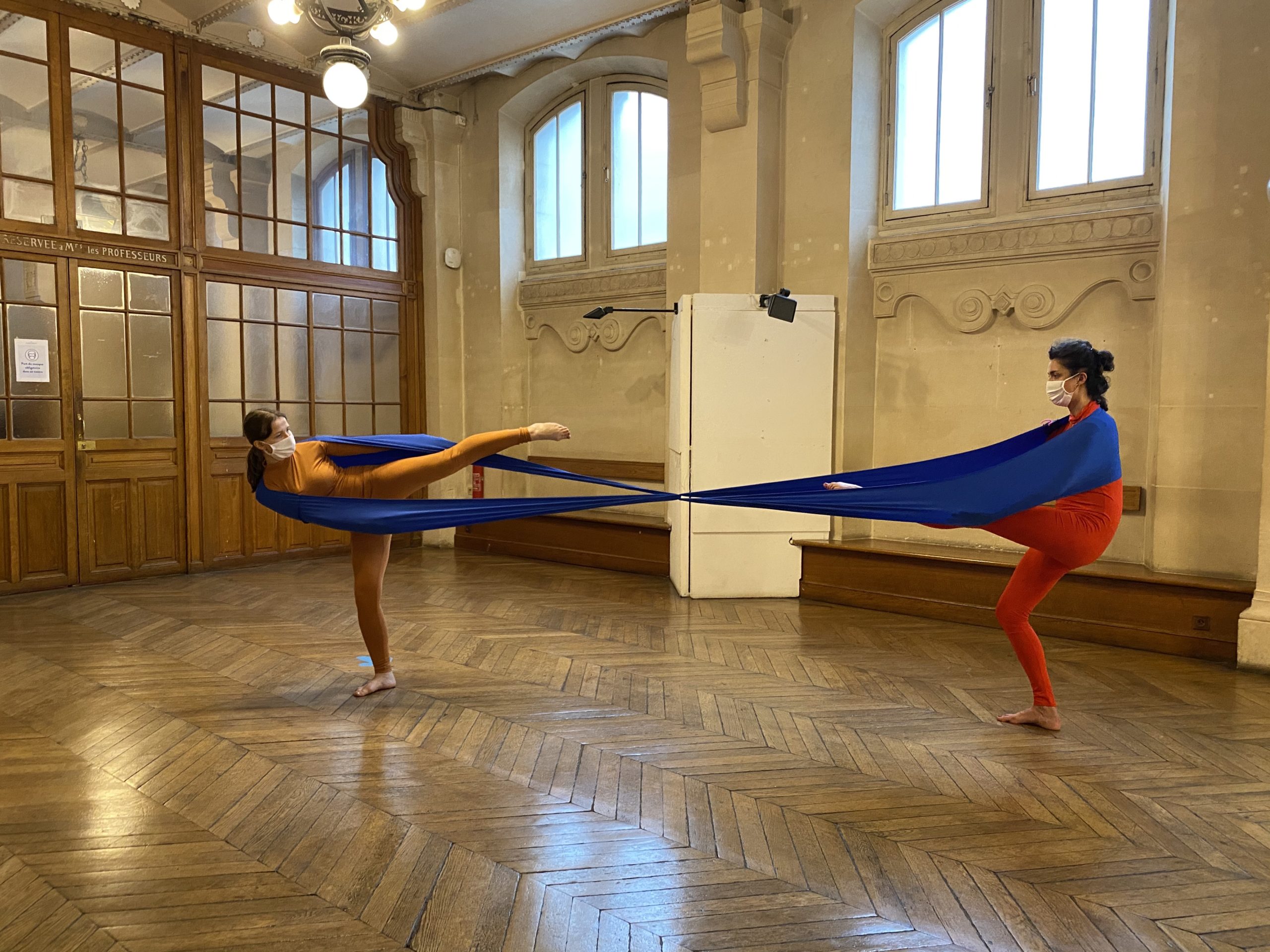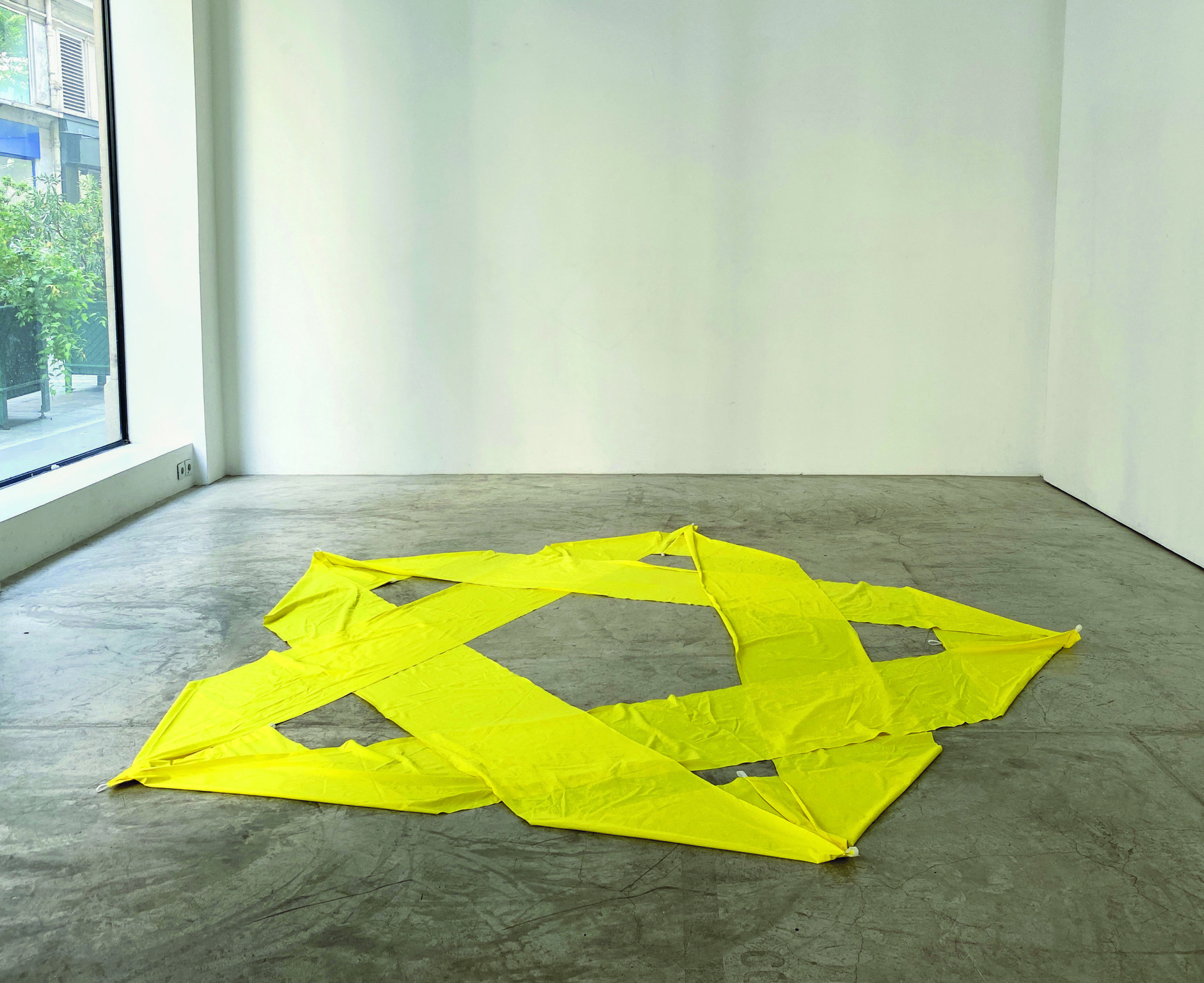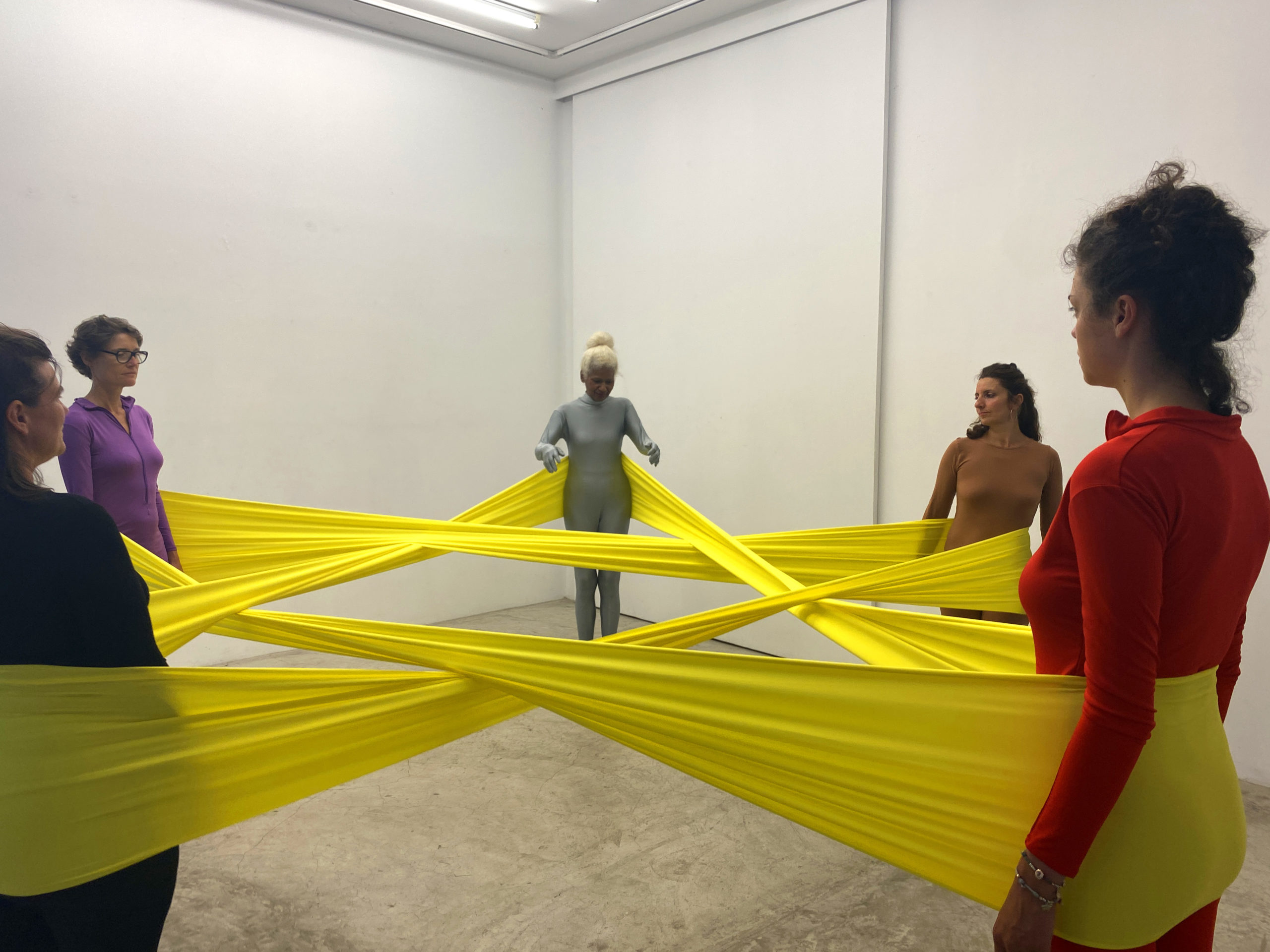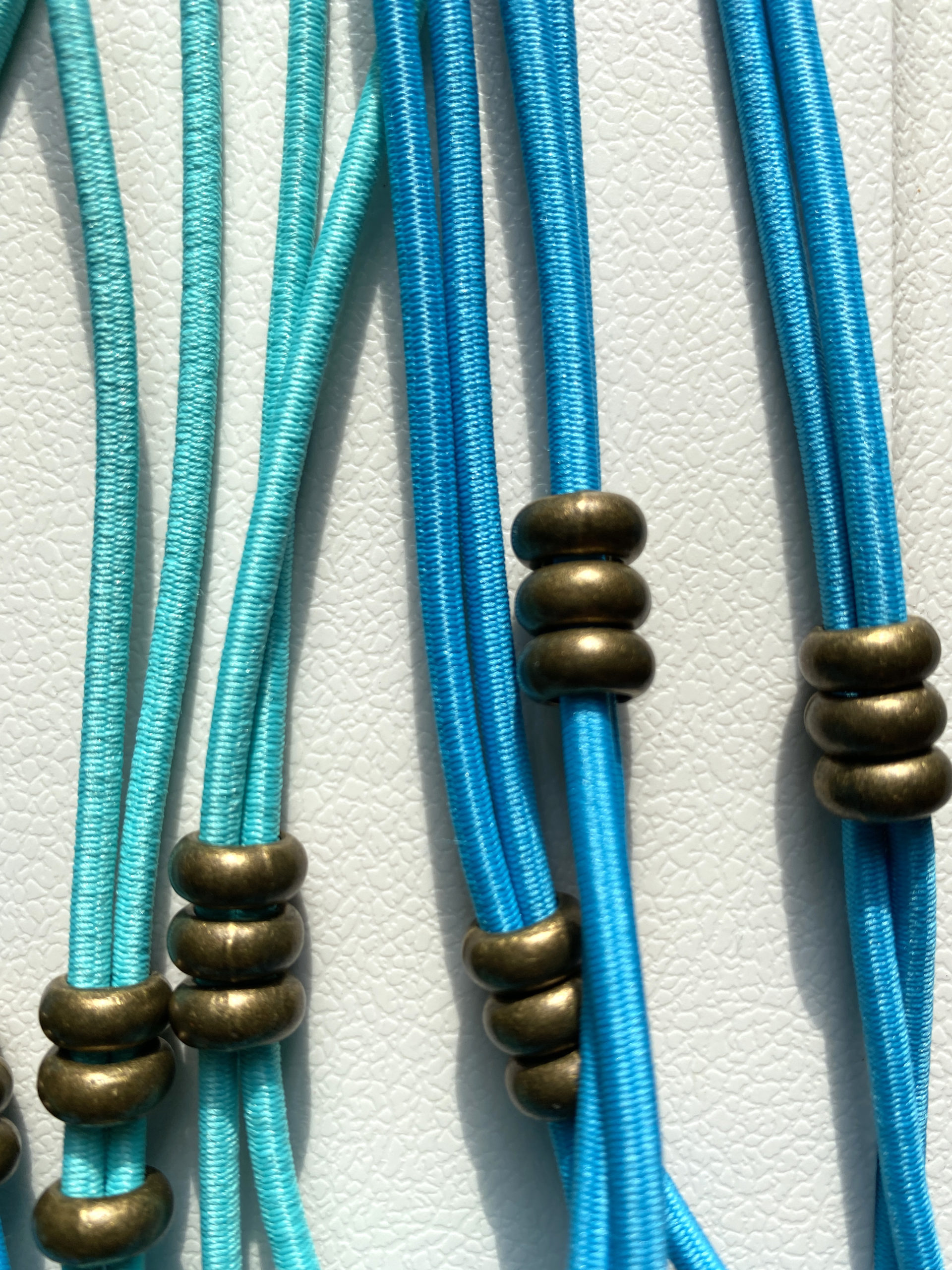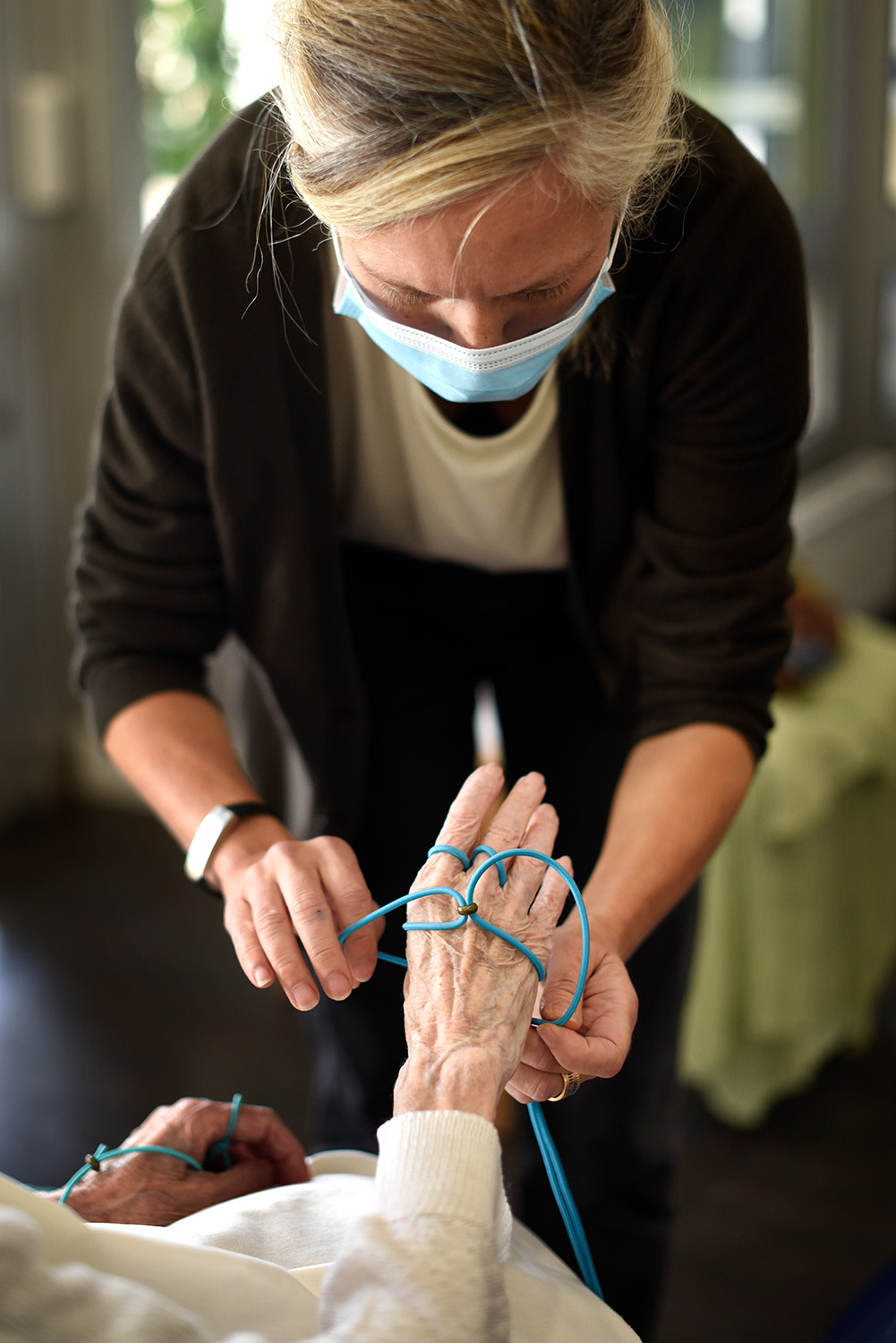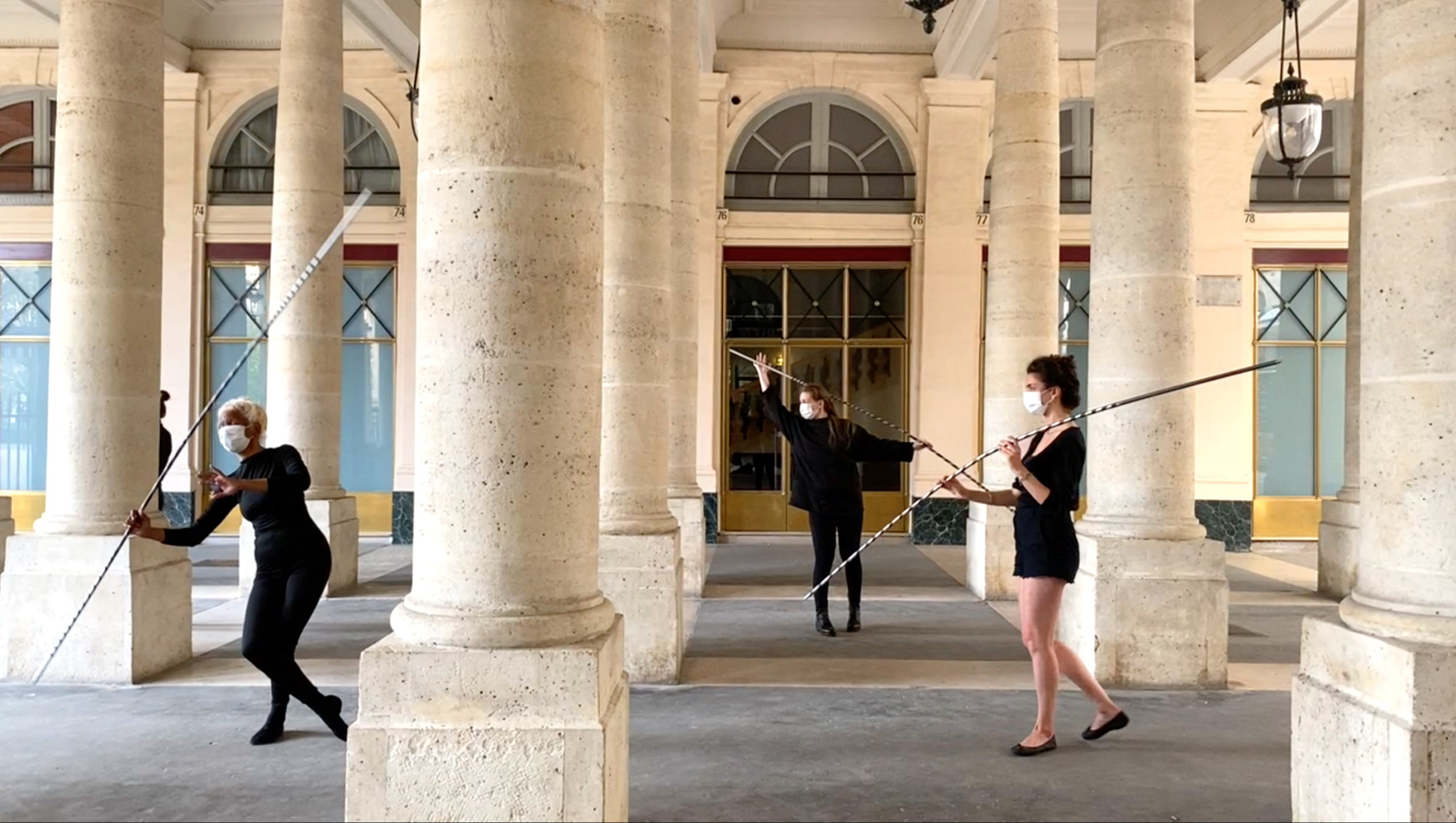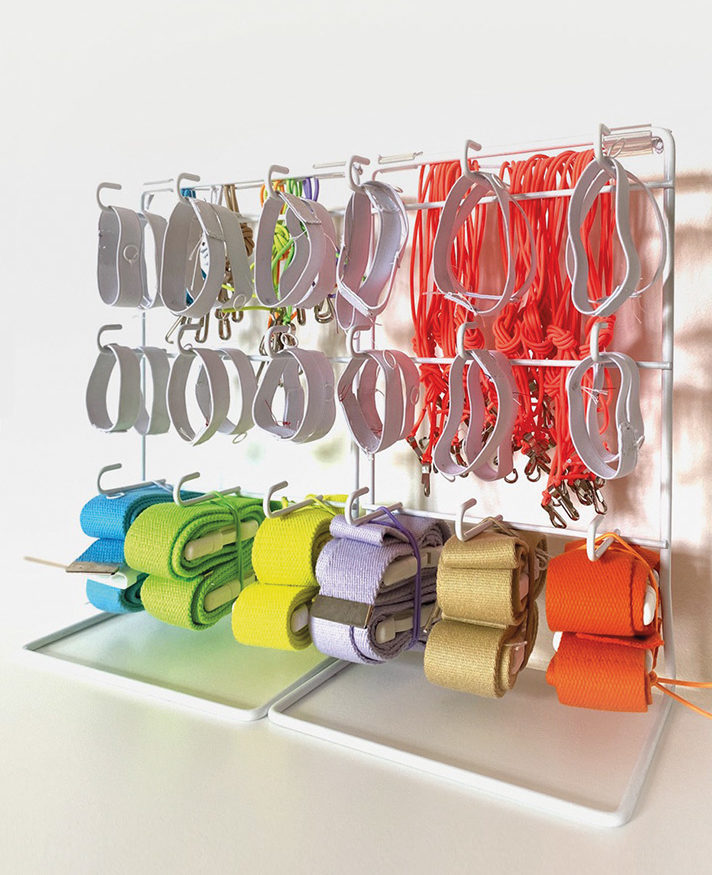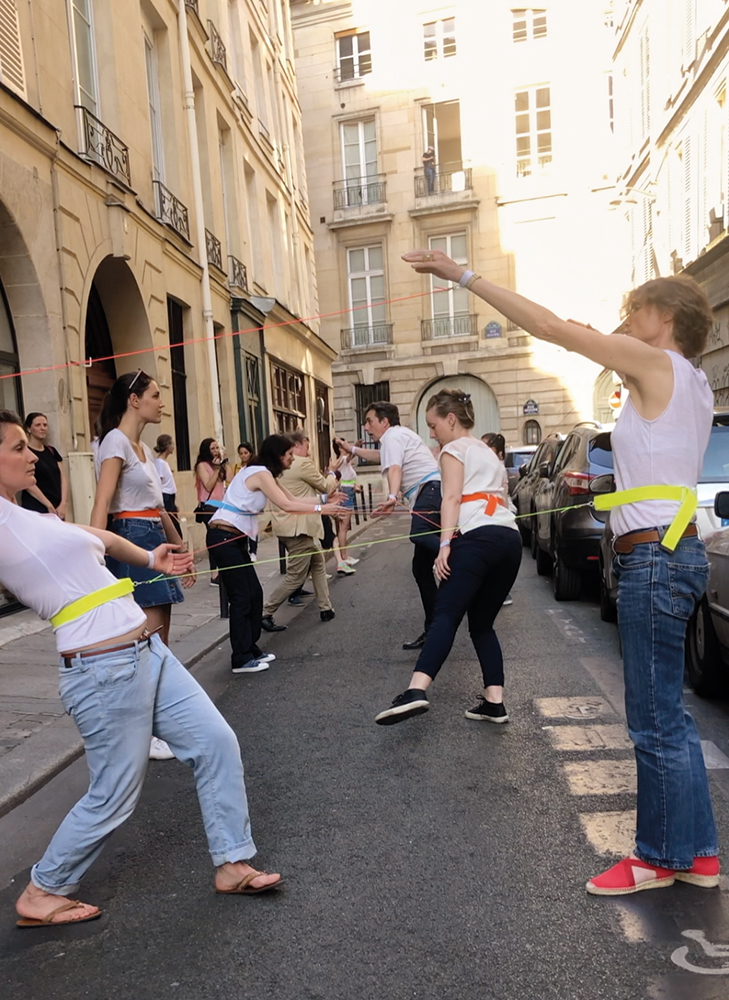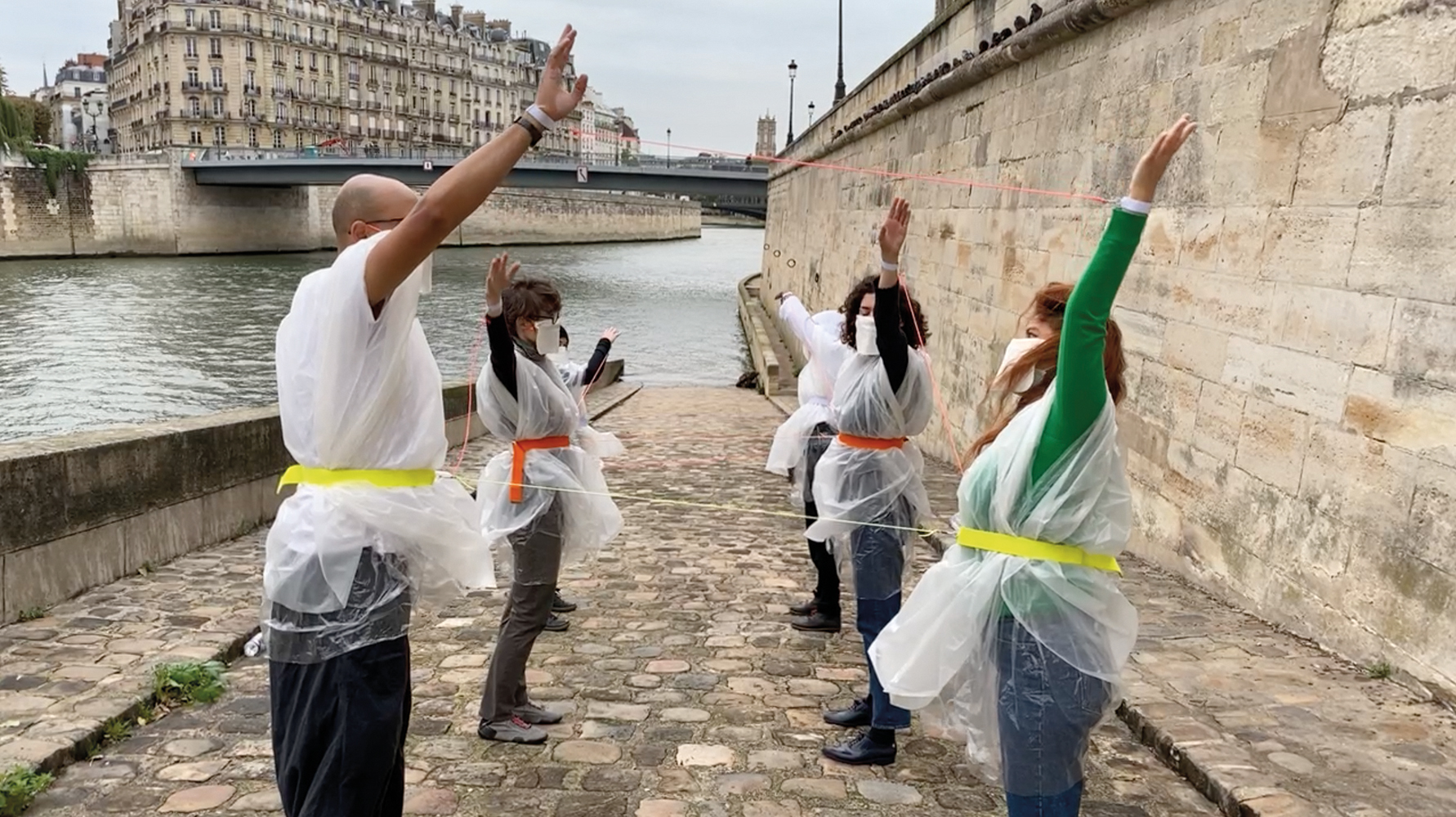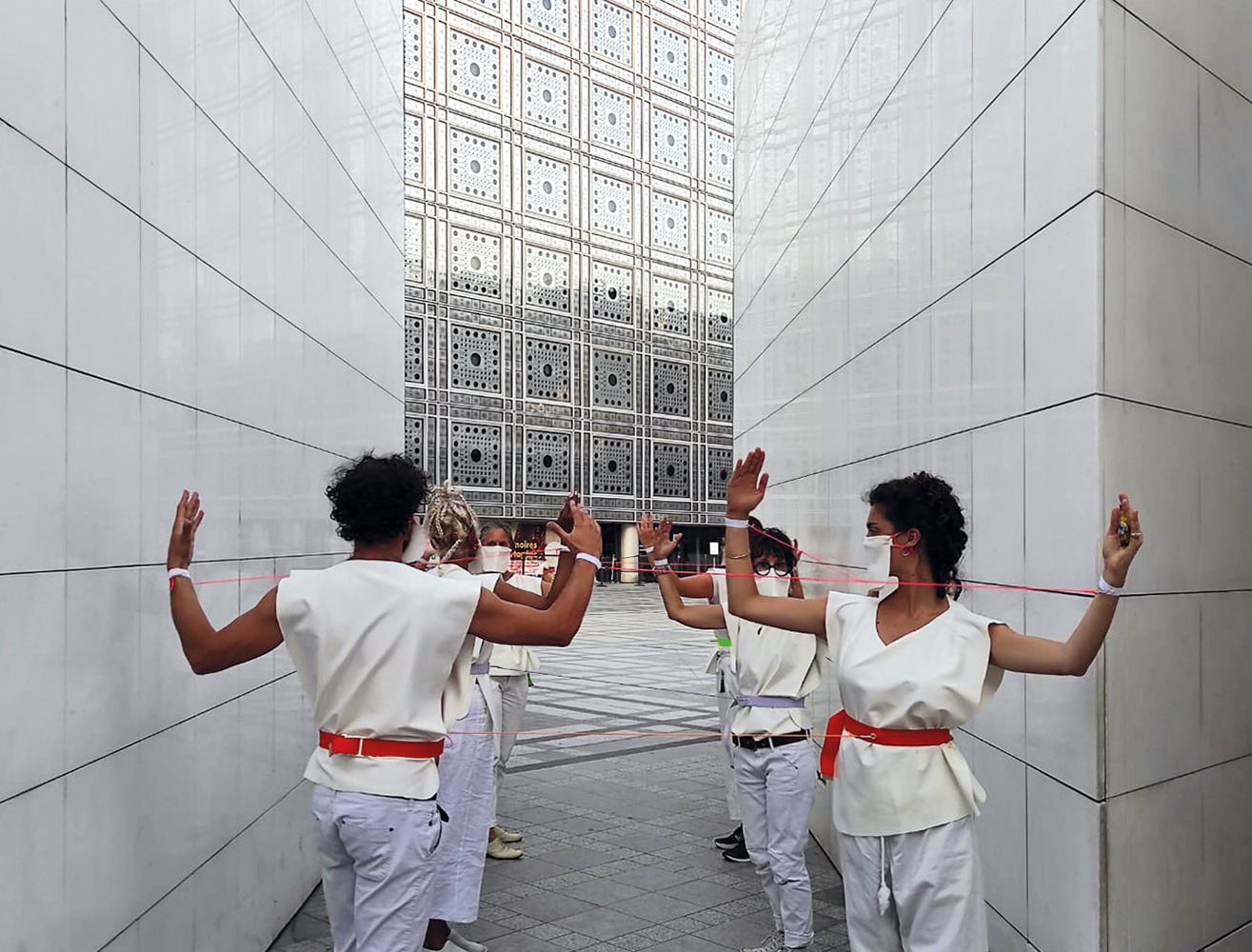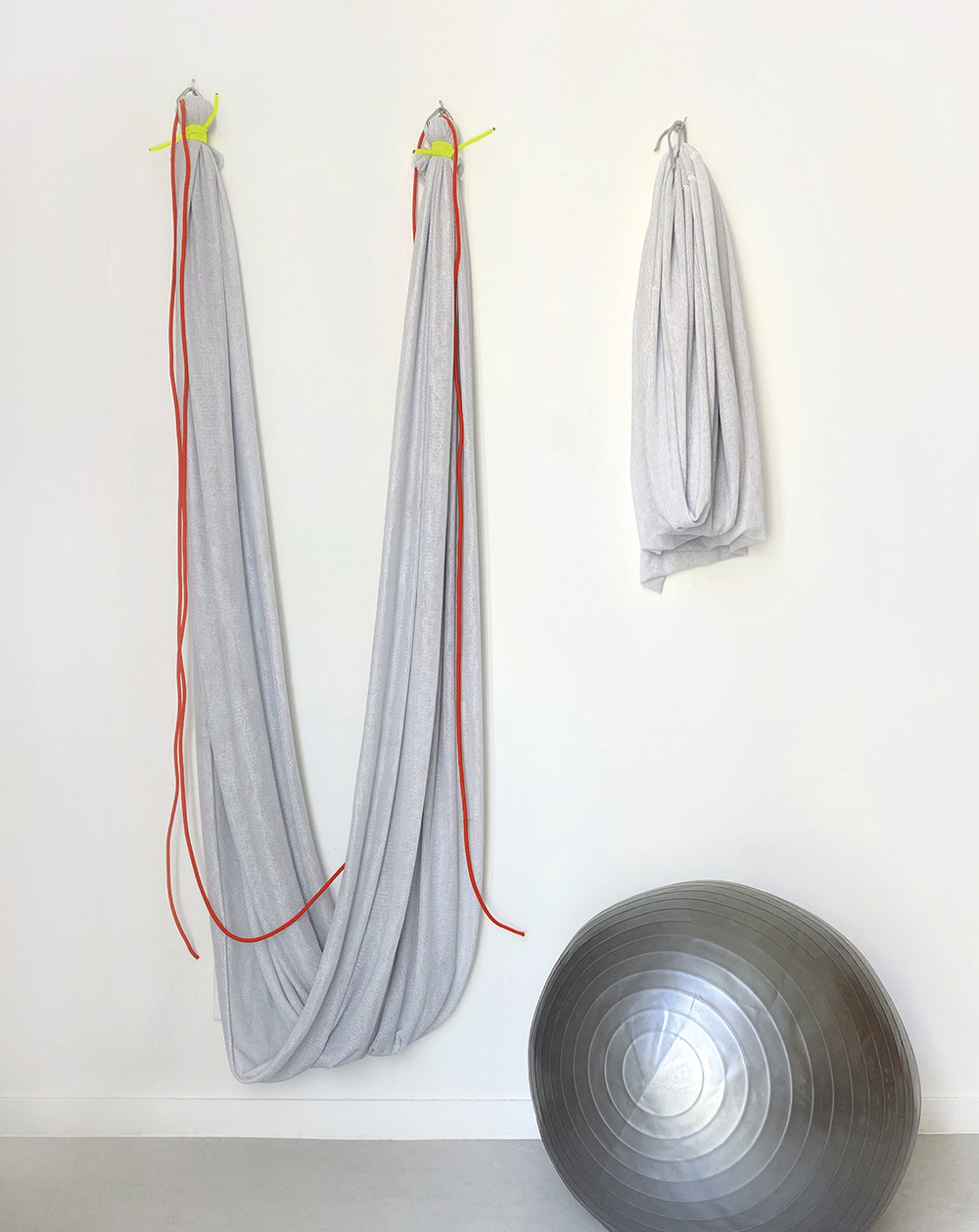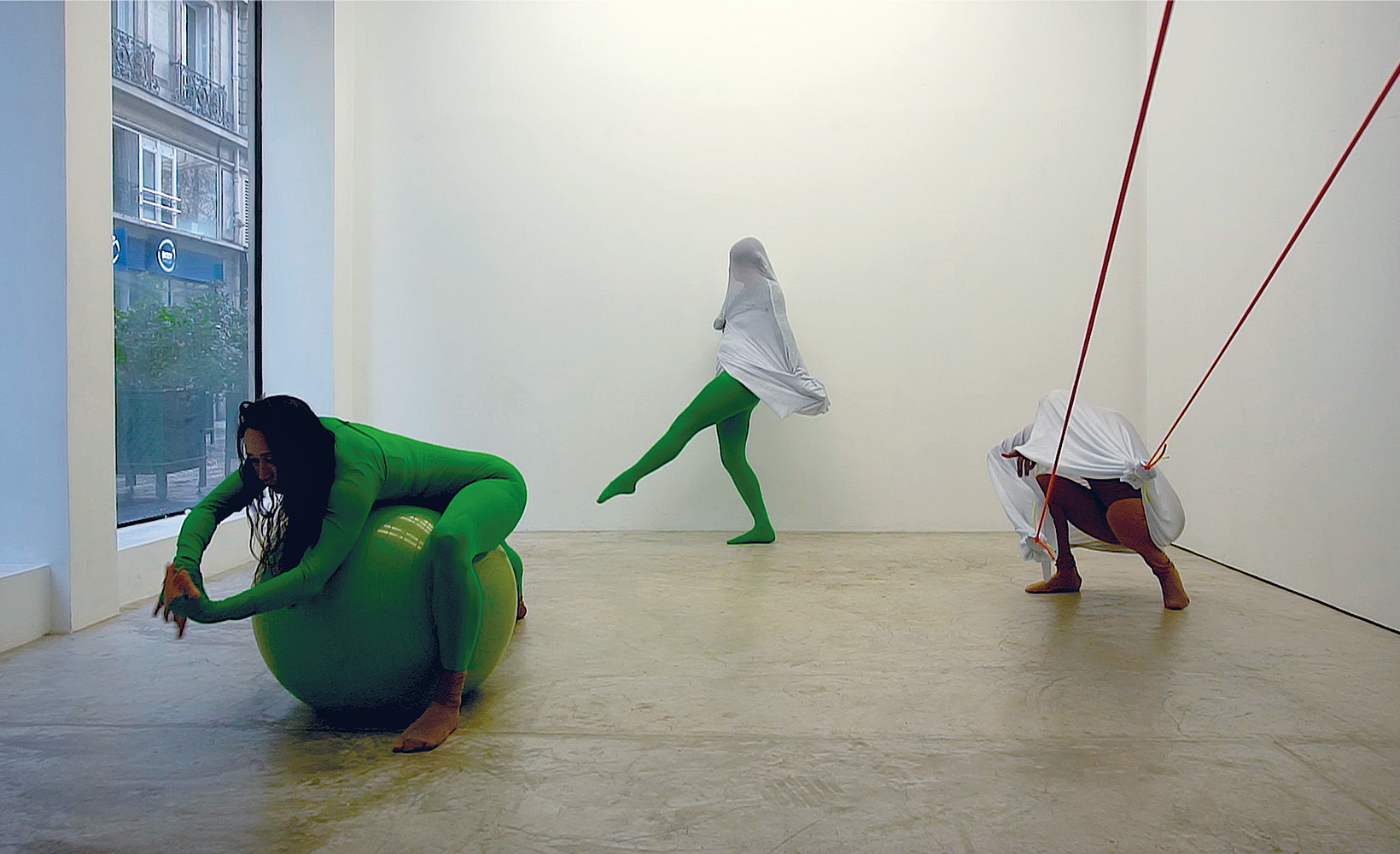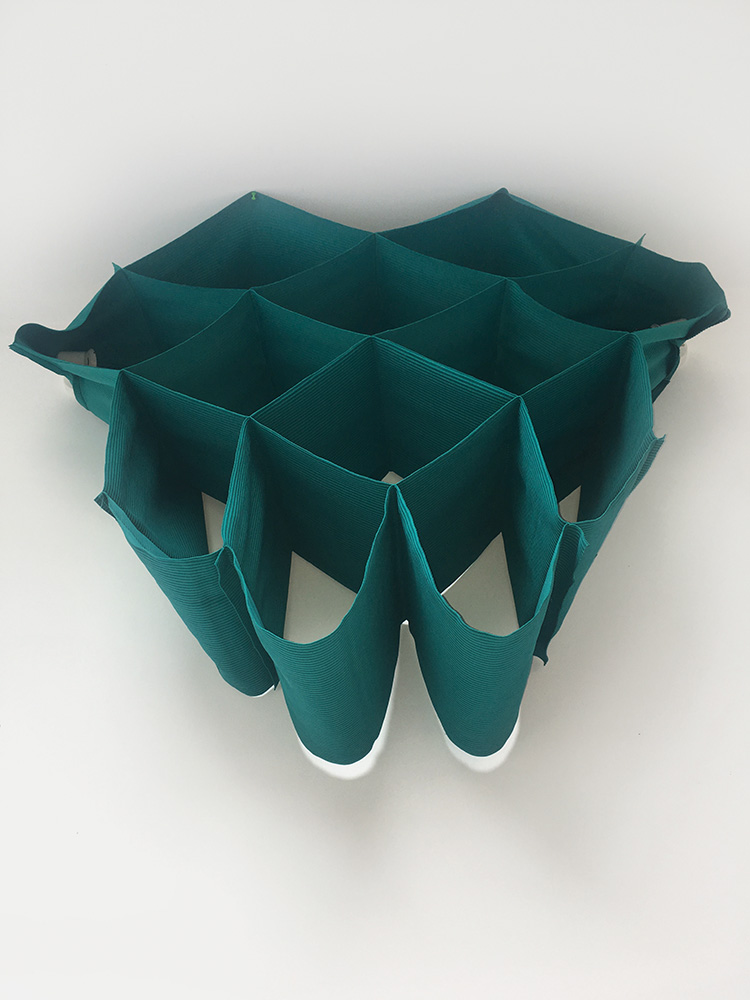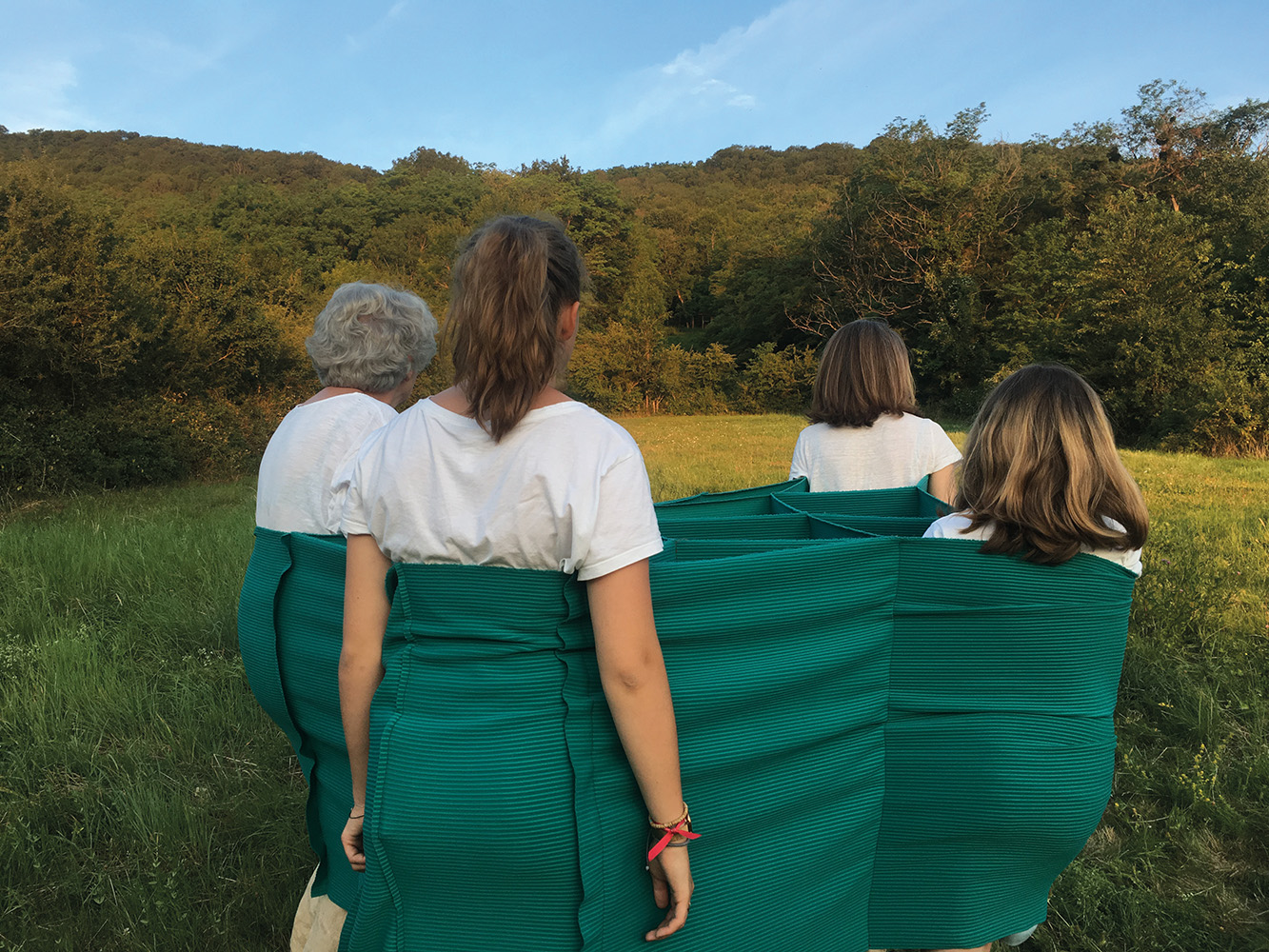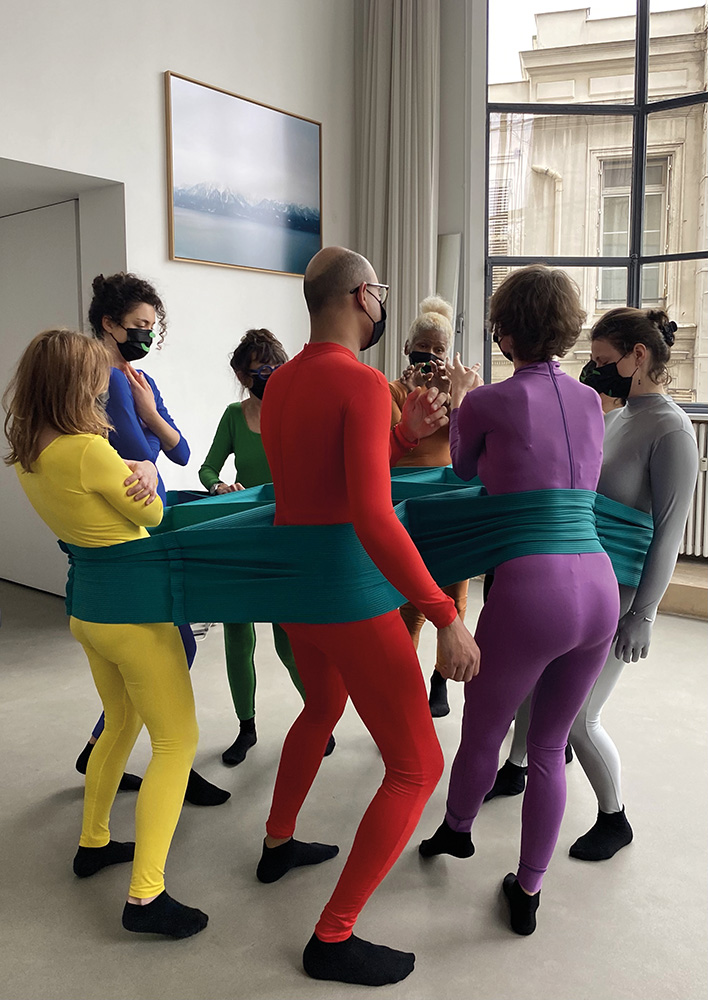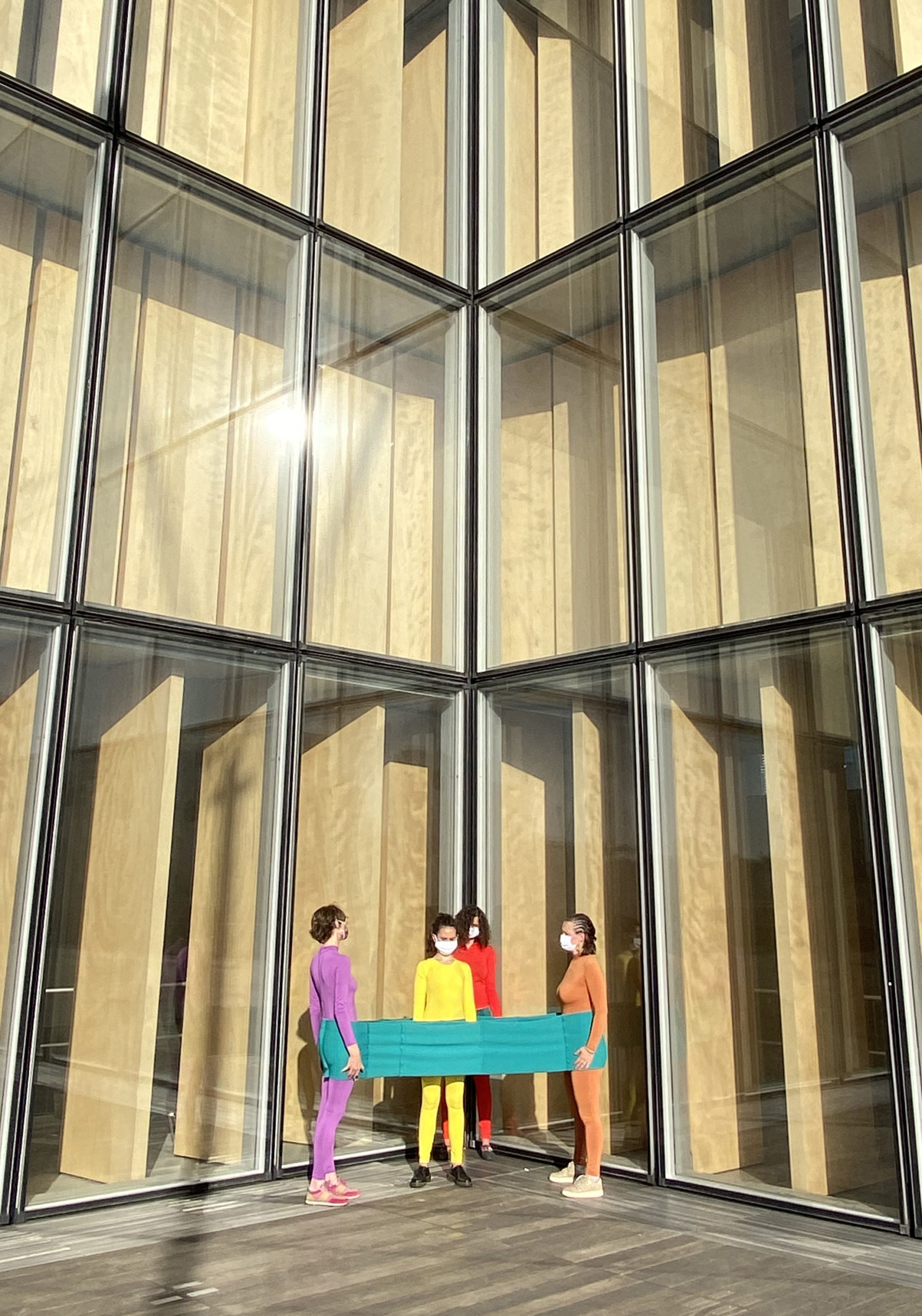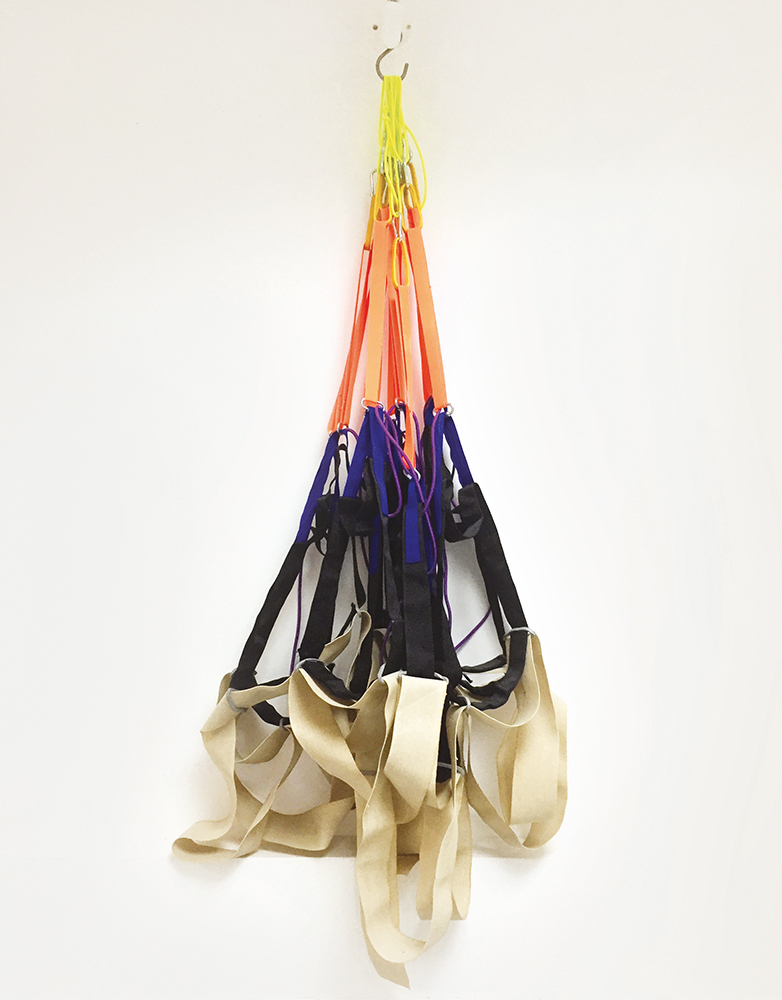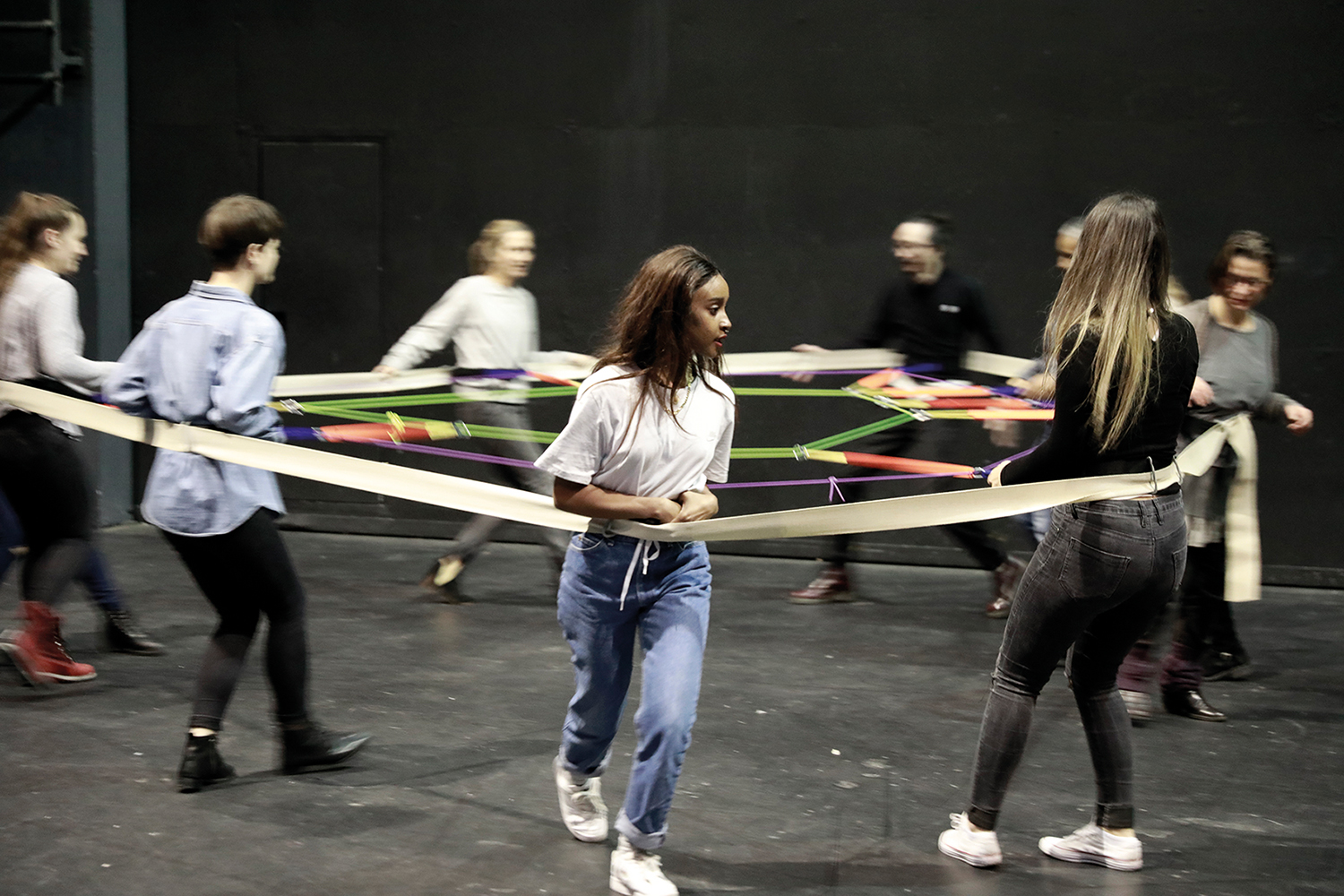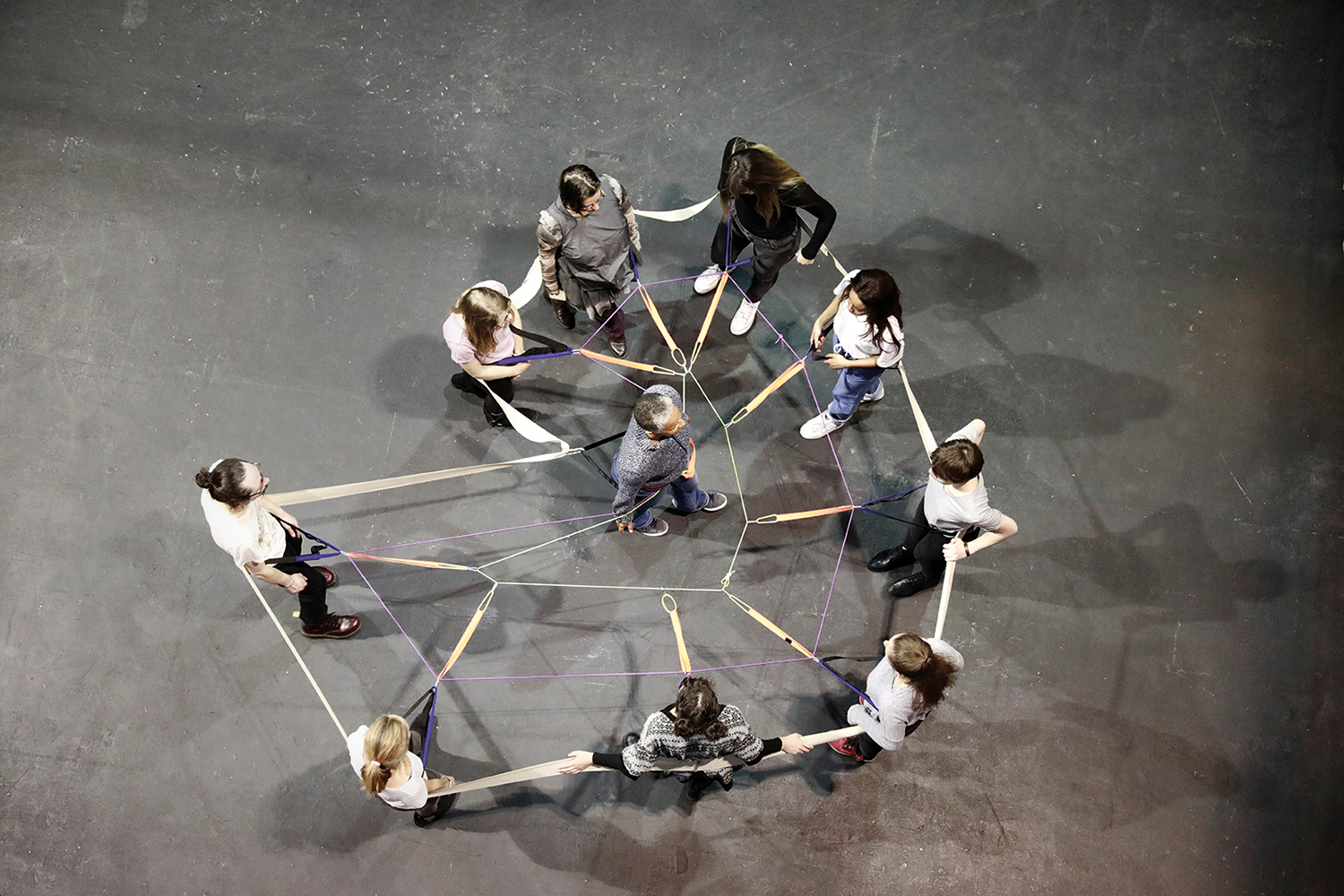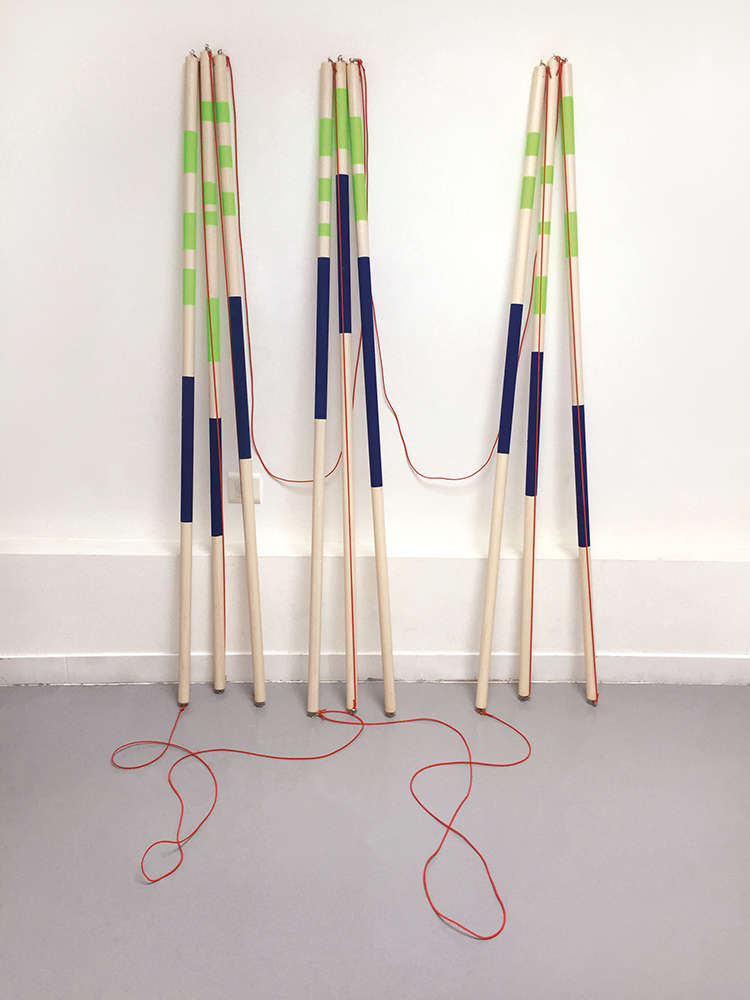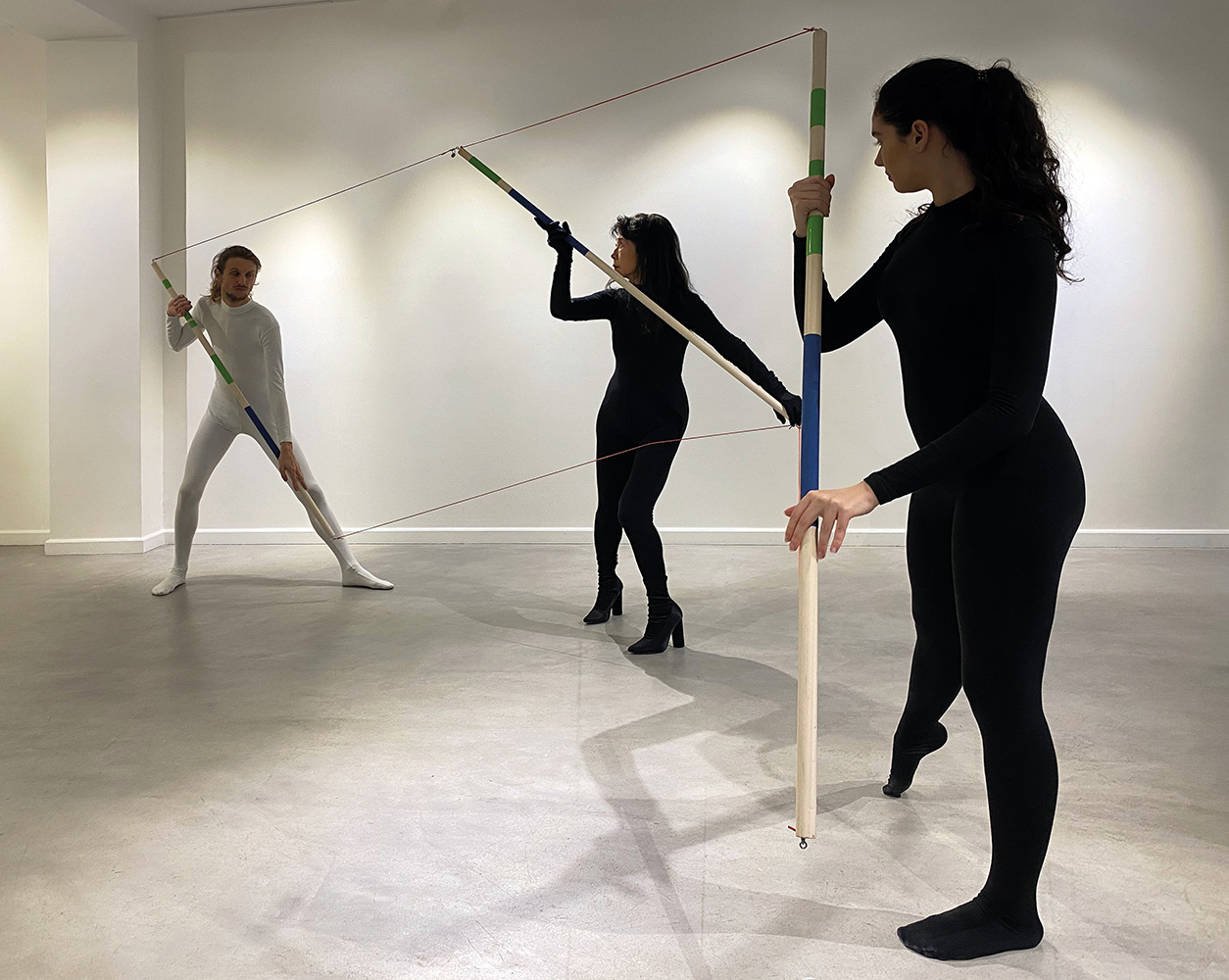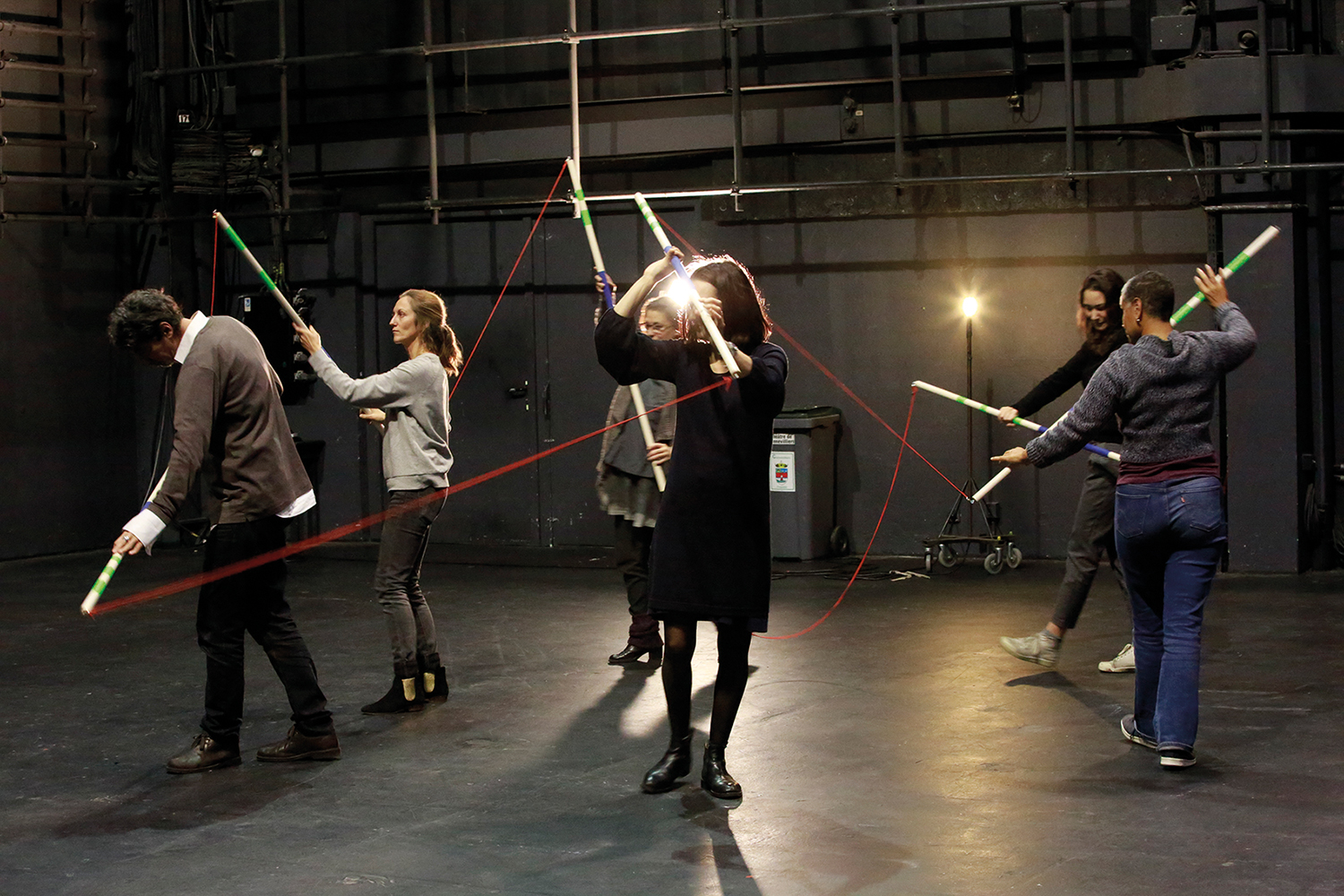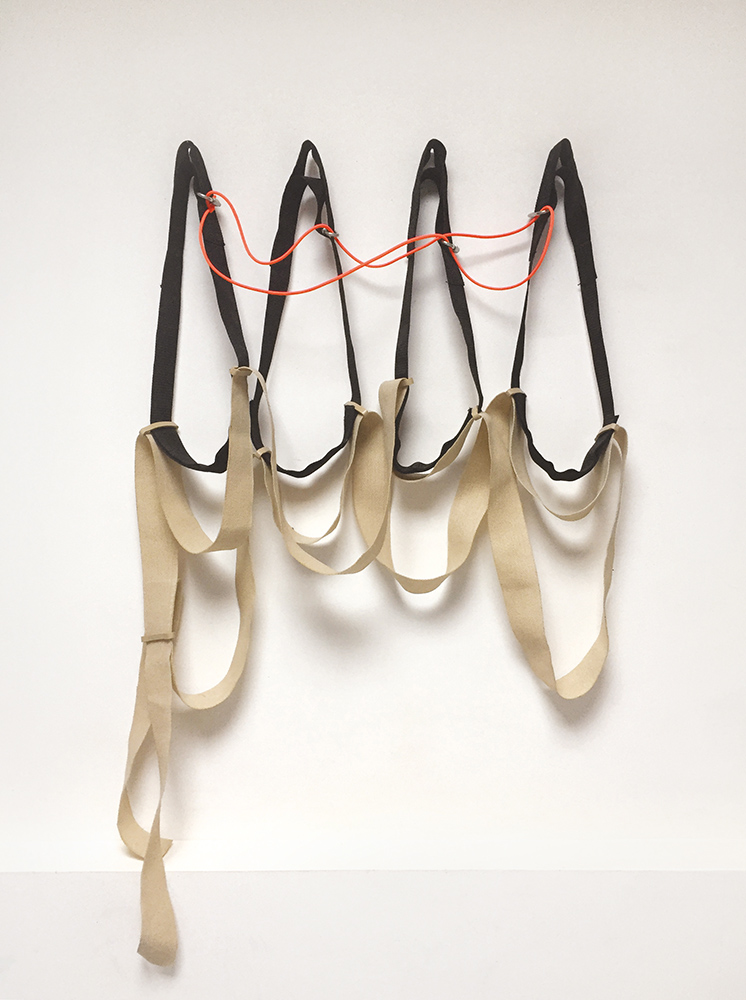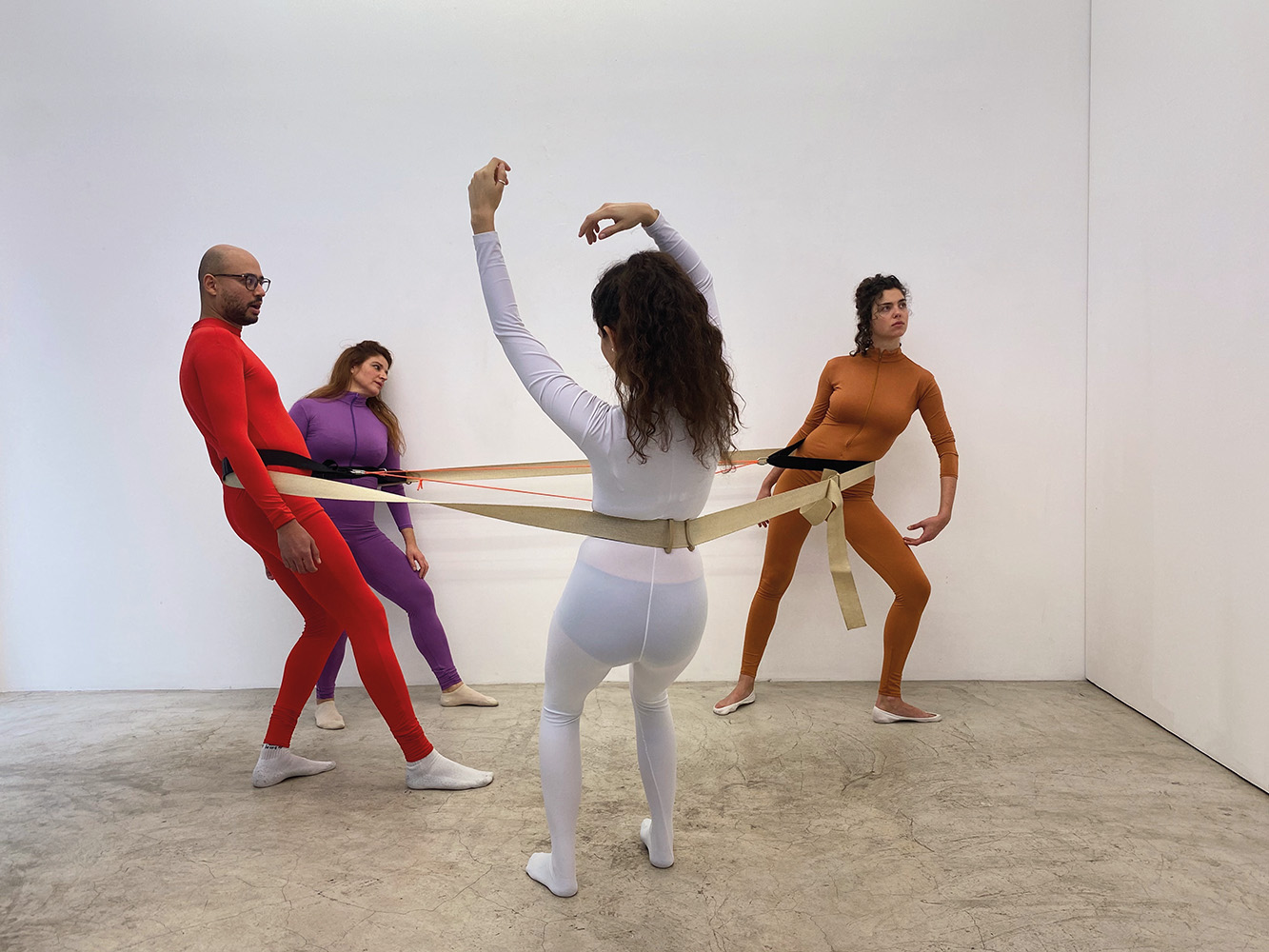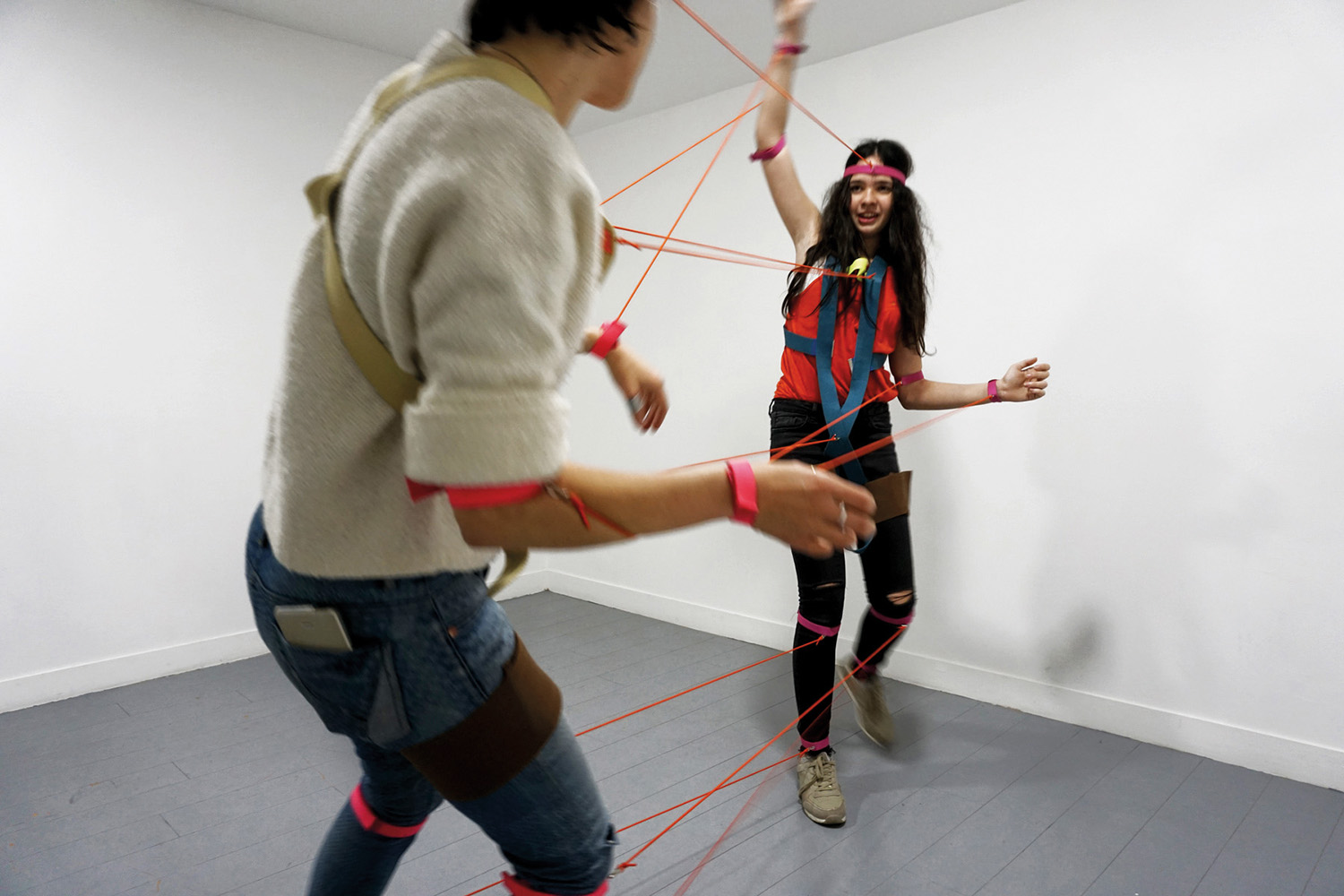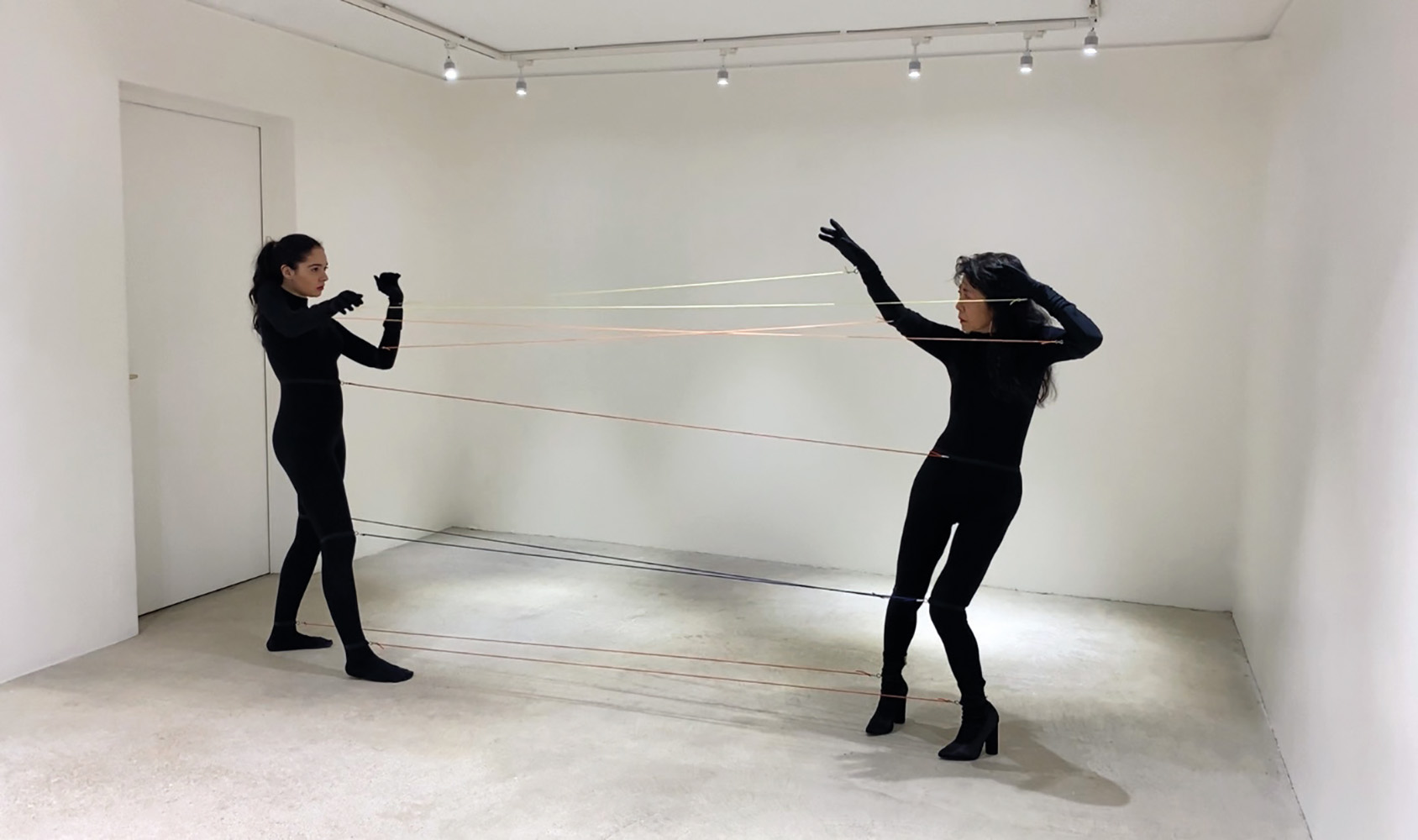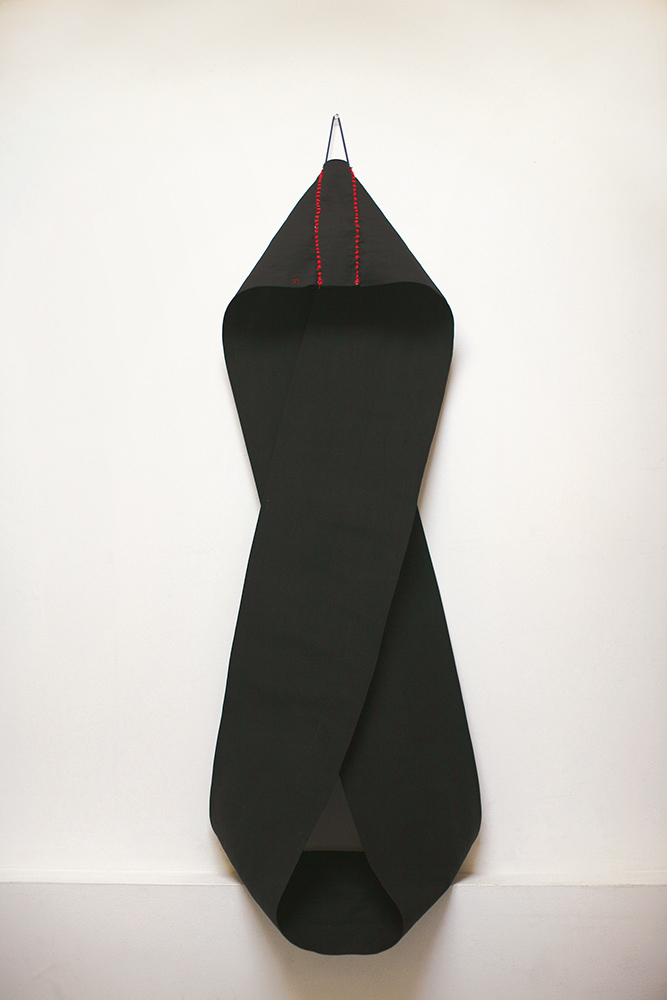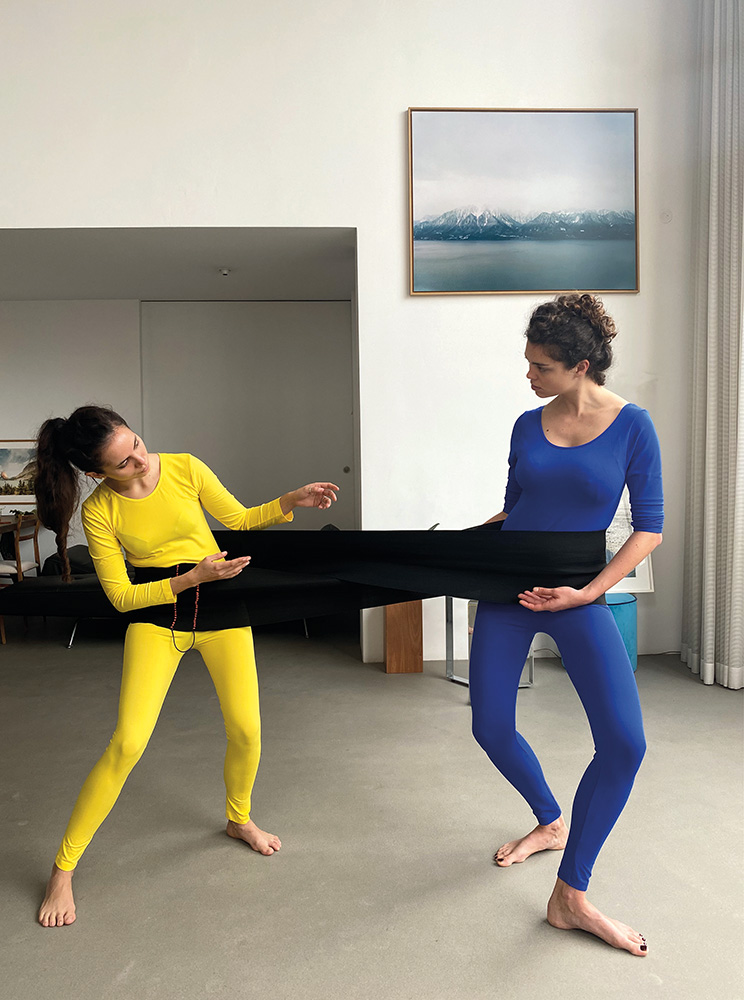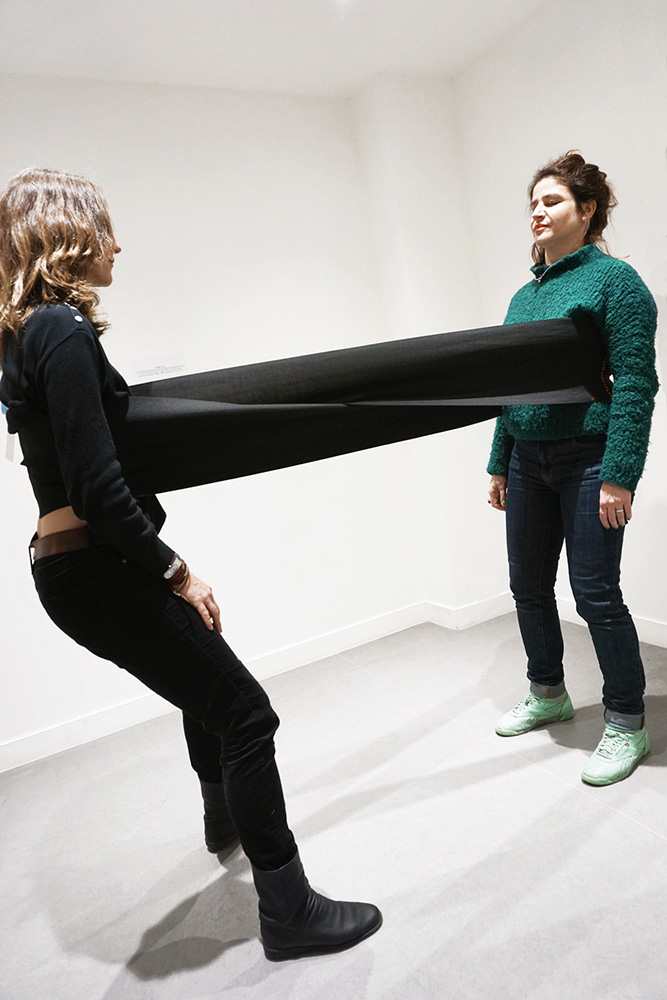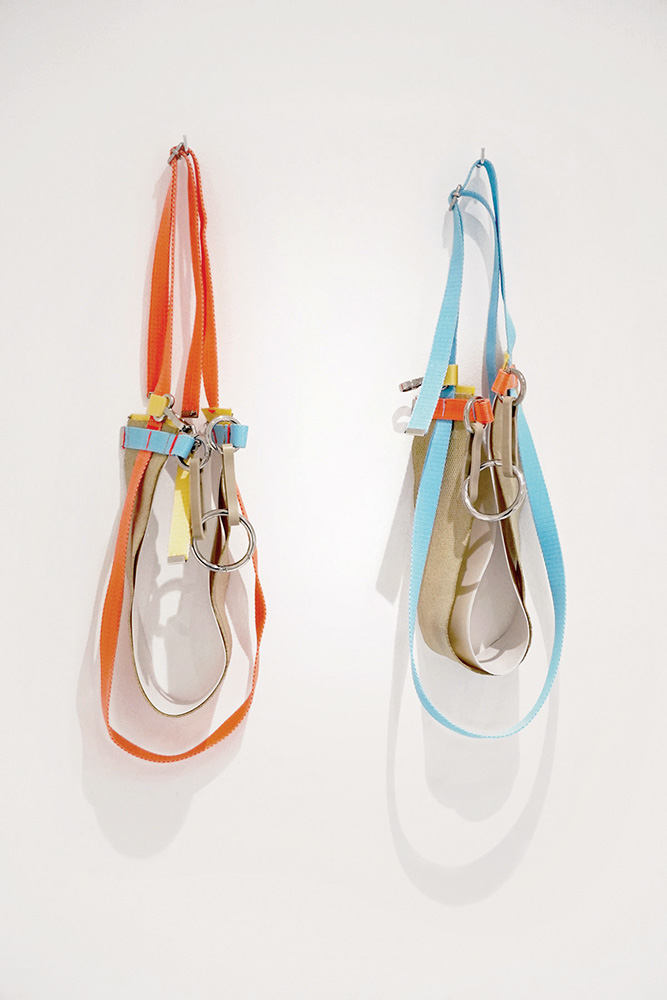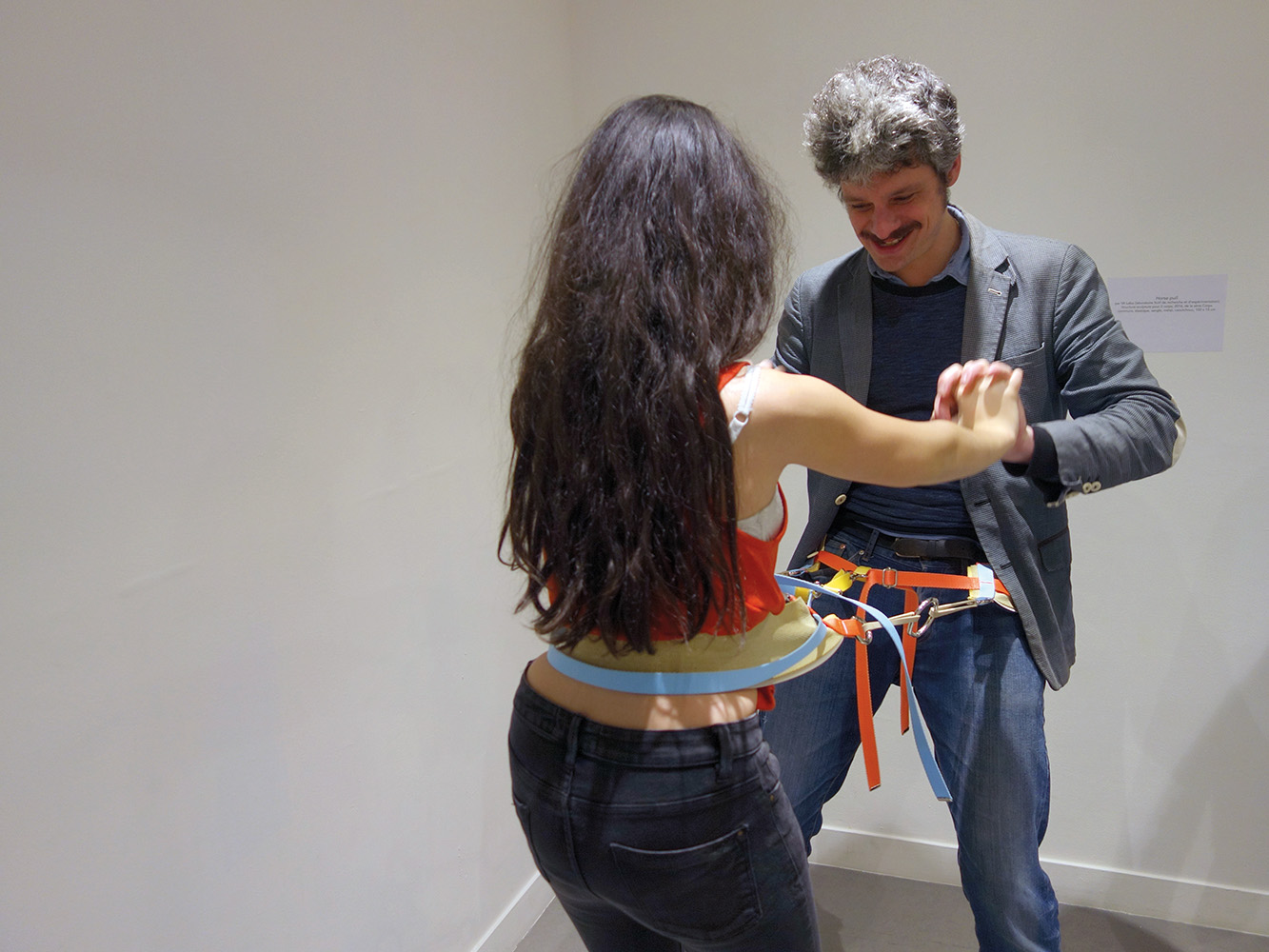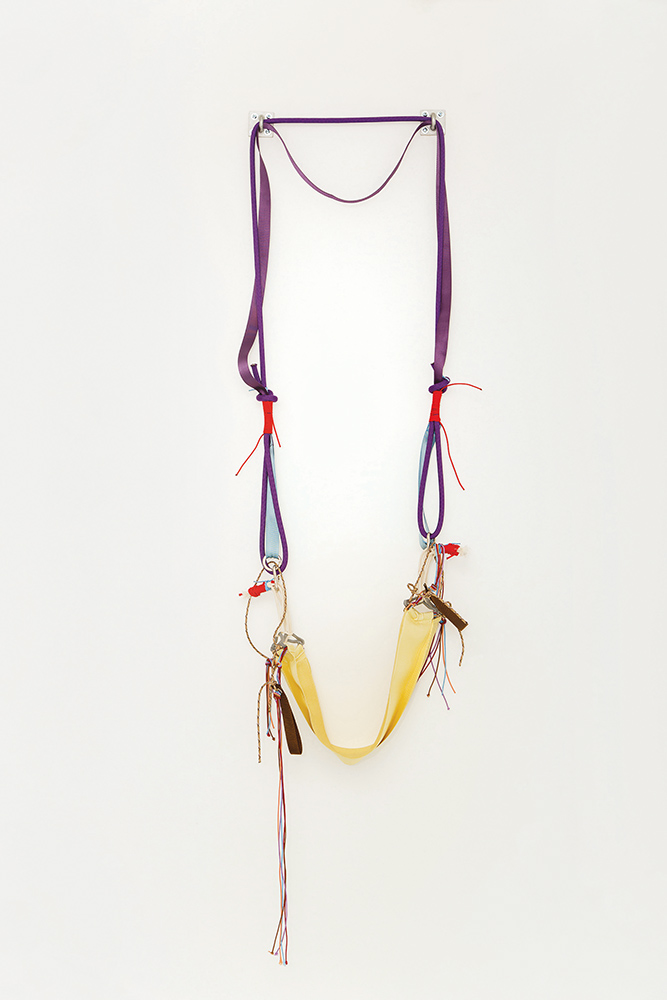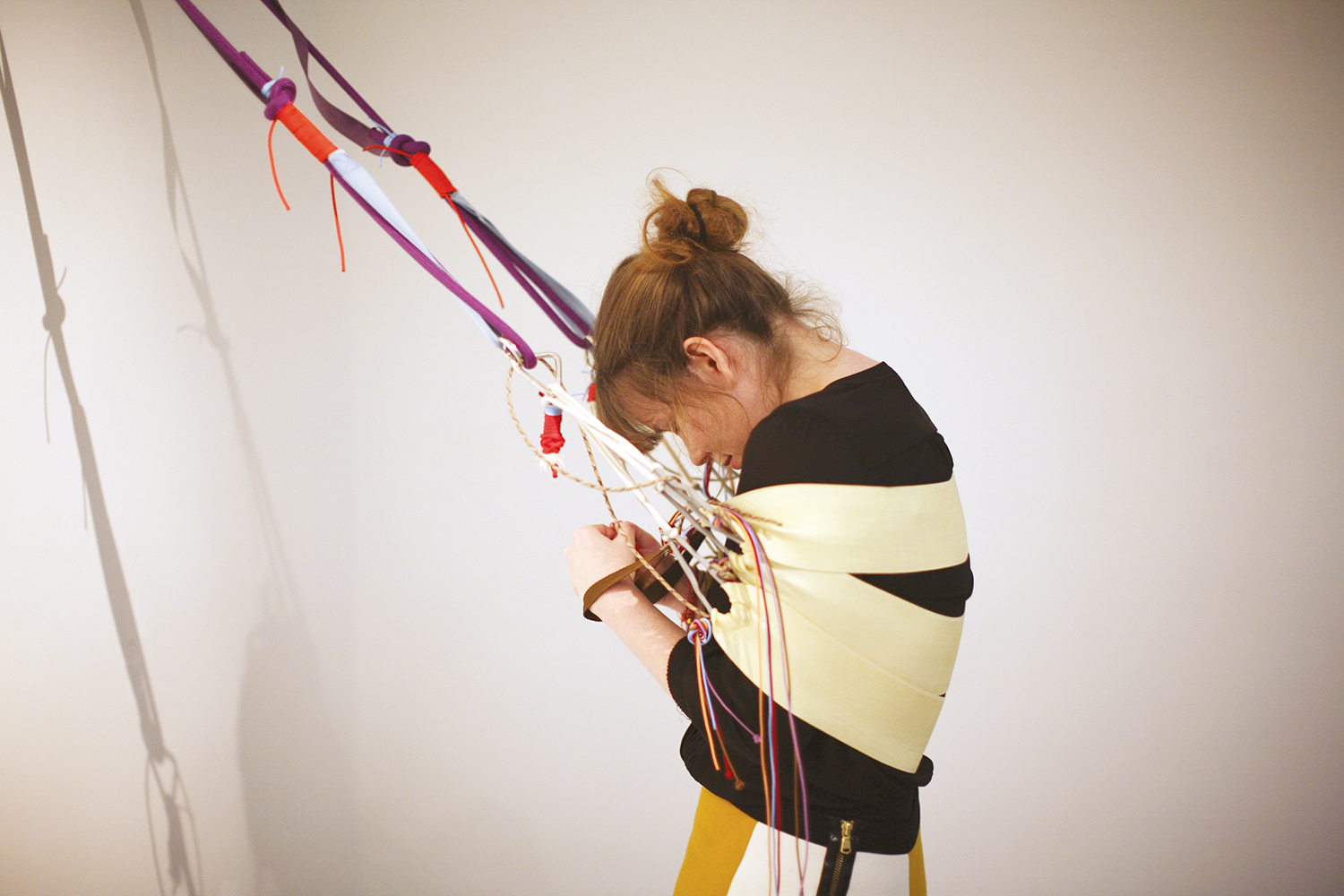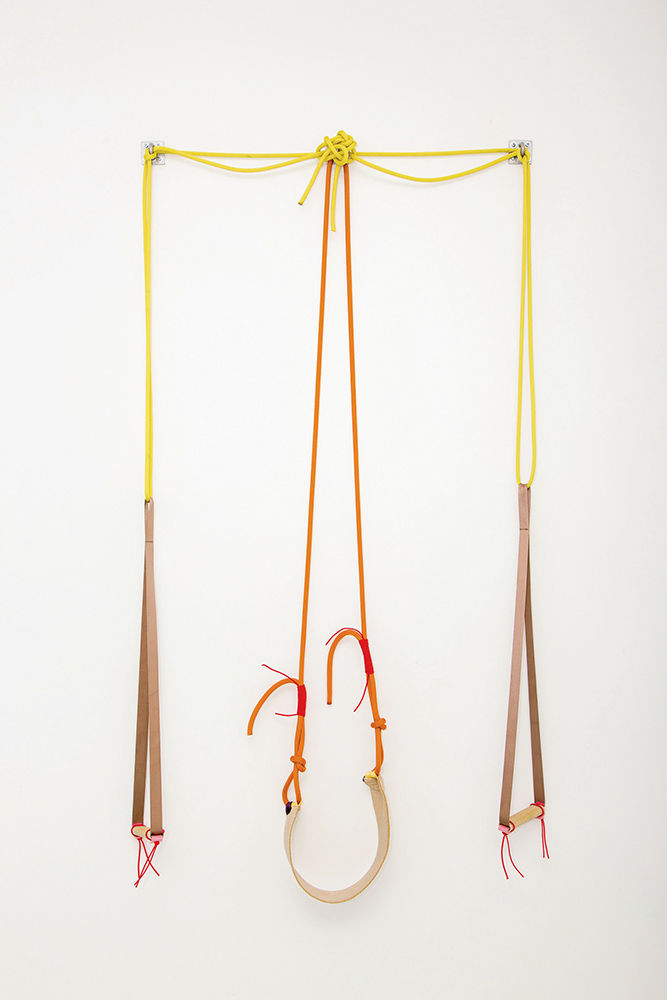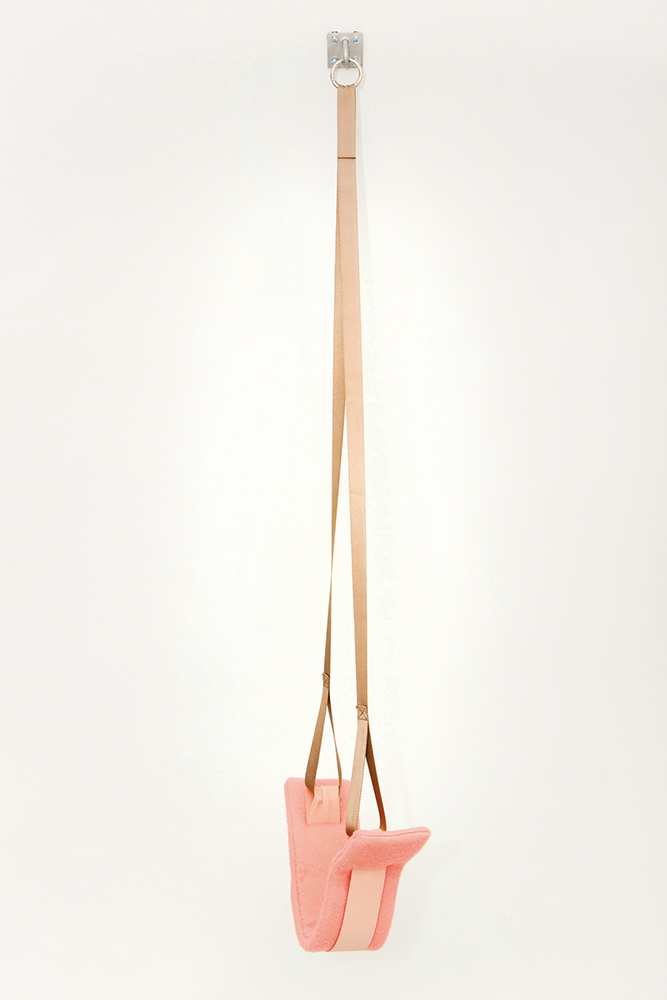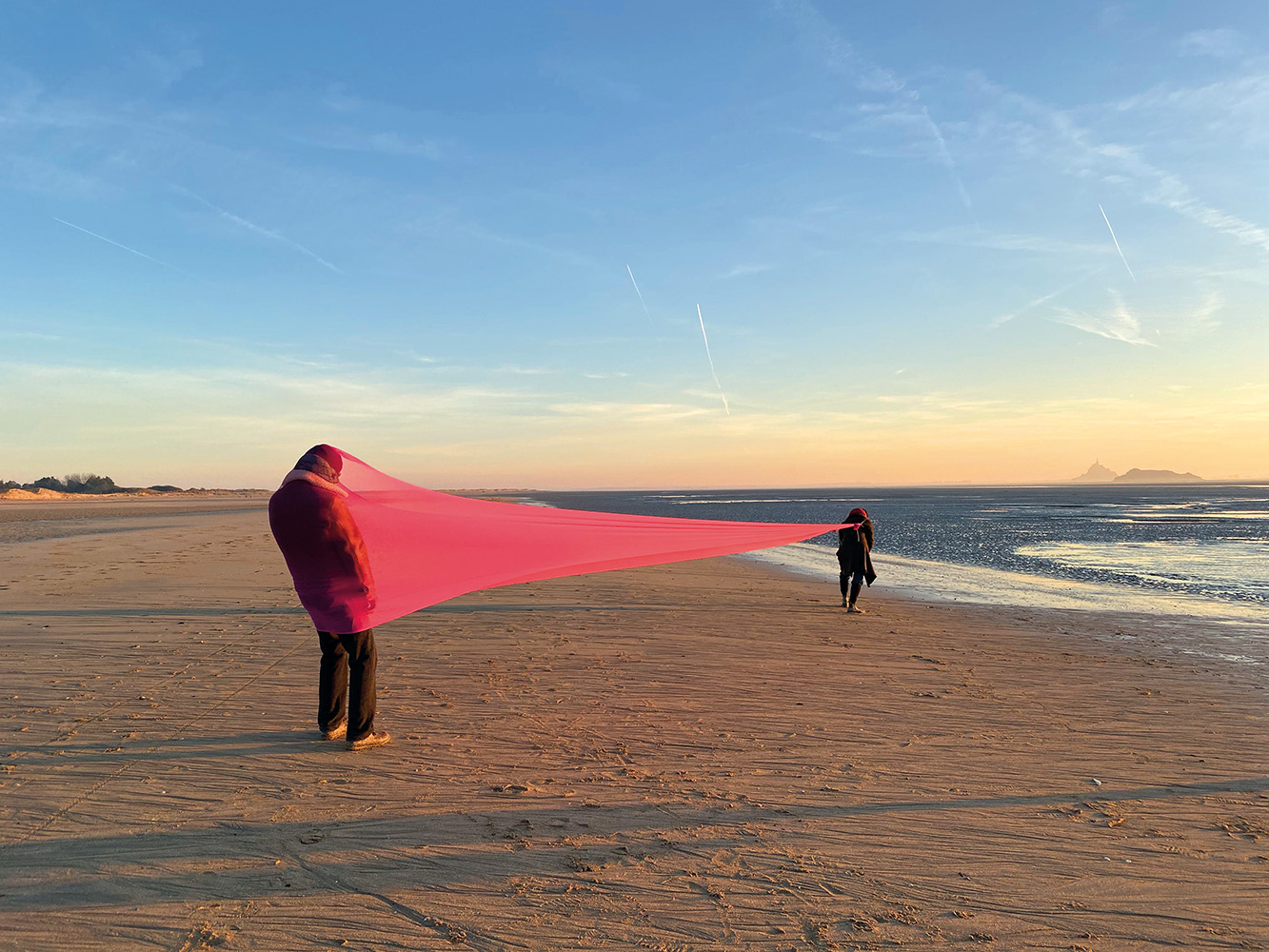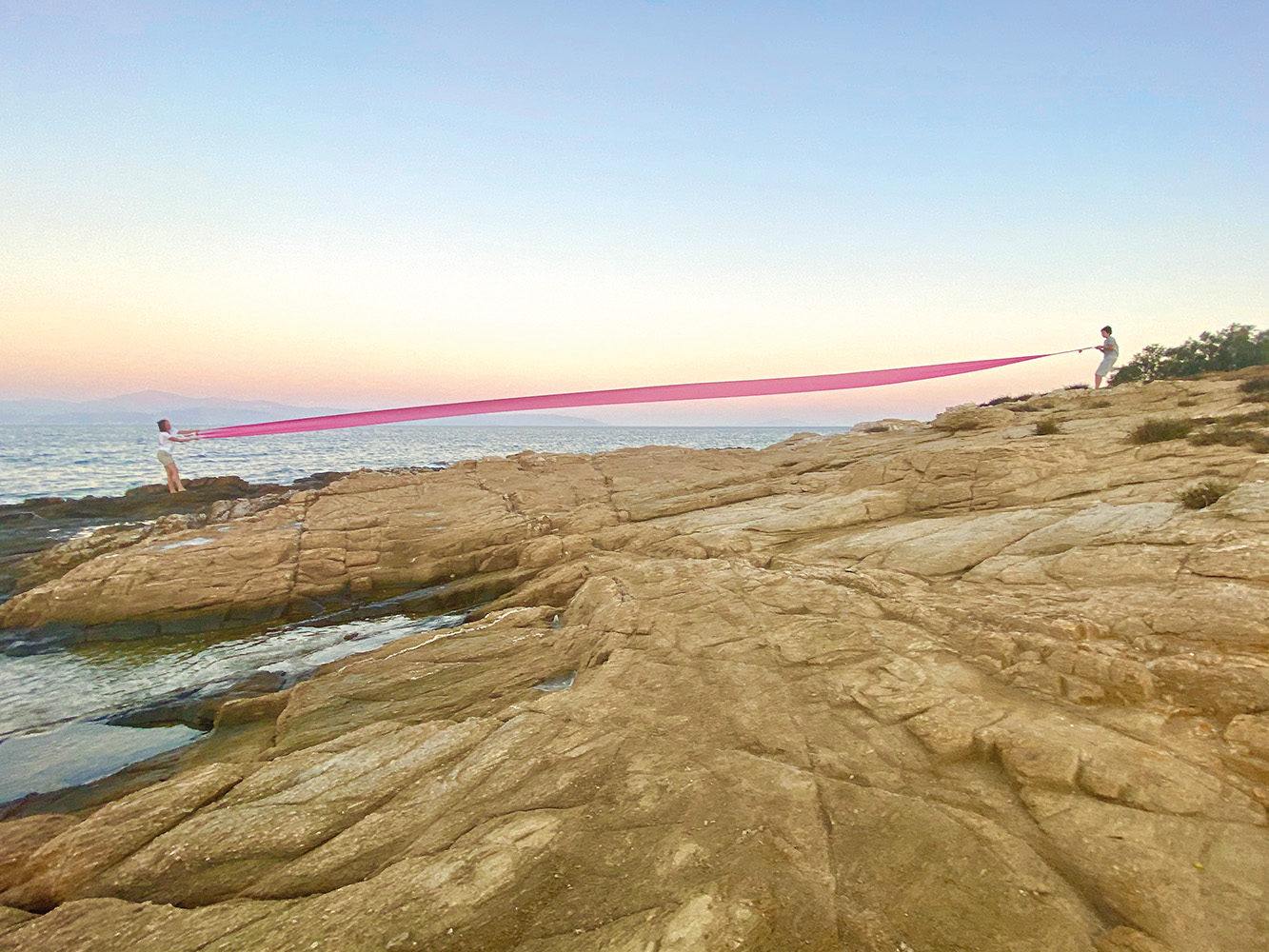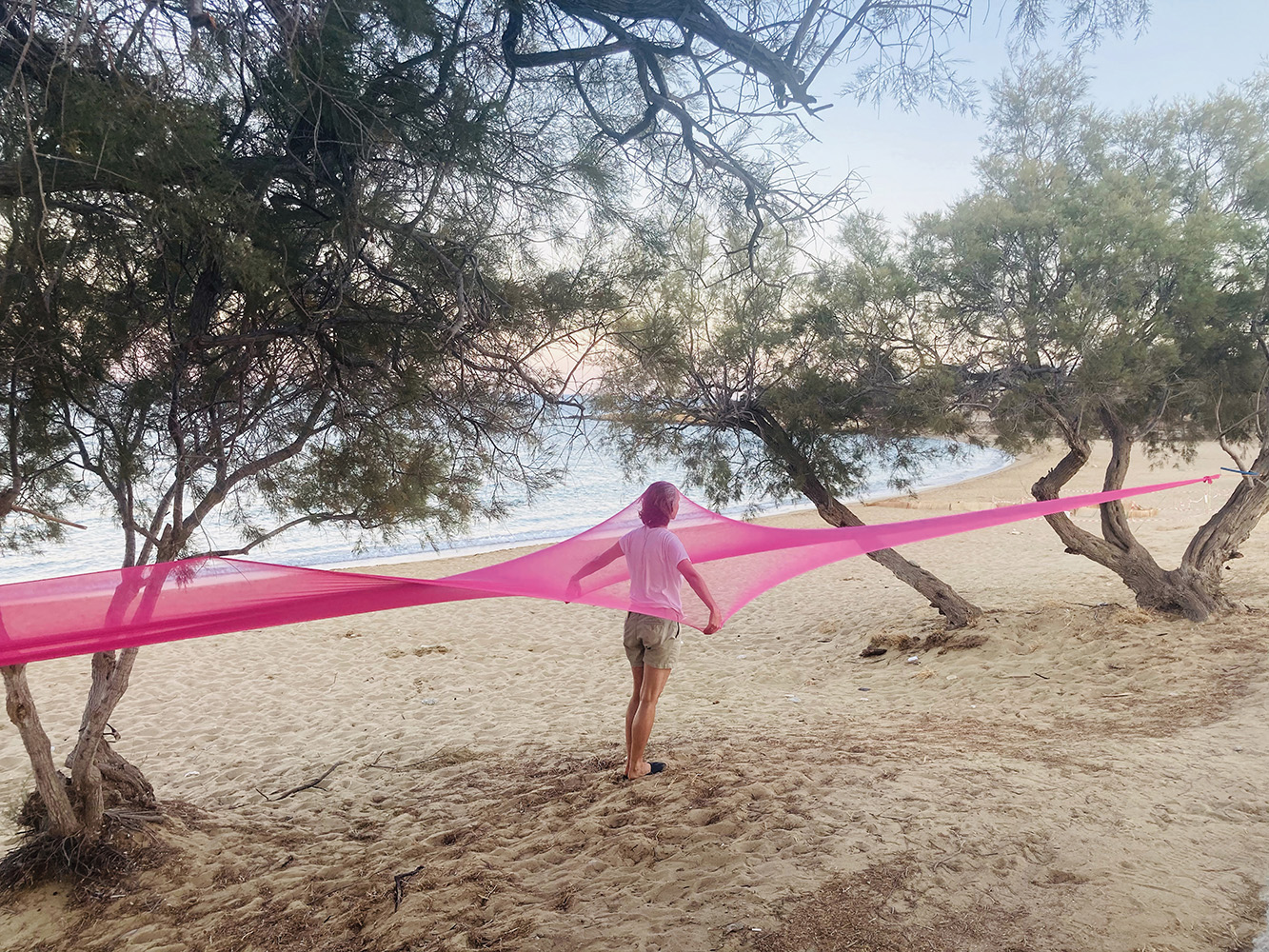
Corps communs is a series of works designed to be installed on a wall and then taken down to become a medium between two, four or even ten bodies. The work connects people to each other through straps and elastics allowing an experience of a connected body as well as a common body. It is a shared body that that does not stop at our own bodily limits and brings our interdependence into play. Paying attention to others as well as listening to sensations, makes it possible to find a rhythm in a circulation of exchanges in which everyone participates toward a common impetus.
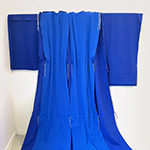
Spin River Deep Blue
Spin River Deep Blue is a Common Body from the Spin series which allows you to synchronize a group walk and develop team spirit. Made up of 3 strips of 5 cells, 2 strips of 3 and 2 strips of one place intended for the two people who guide the direction of the procession. Over a length of 17 meters, participants are installed in the structure to follow the visit, alternating head and tail at the sides of the visit.
Spin River Deep Blue was inaugurated at the Centre Panthéon de la Sorbonne as part of the Share International Congress organized by Barbara Formis with Sorbonne Art Gallery. During the performance evening, the participants and their two guides discover the place by passing through different spaces and periods of construction of the buildings. A live video allowed the public to follow the visit on a smartphone and join the performance in the Main courtyard. A reactivation of the performance was organized during the day with Sorbonne Art Gallery.
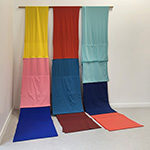
Spin Light Duo
Spin Light Duo is part of a series of 3 pieces designed to collectively synchronize our walking, work on team spirit and our interactions. The Spin Light Duo structure is inspired by a stem with its symmetrical leaves. It can also be reminiscent of the two-by-two row in the schoolyard. The participants thus advance side by side in a colored module connected by a zip to the other modules. A yellow module is associated to take the lead in the procession and guide the walk or the visit when it takes place in an exhibition space. We can imagine that the pairs leave this collective wandering, to continue their discovery at their own pace.
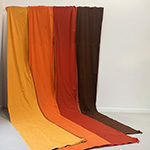
Spin Field
Spin Field is the second piece in a series of 3, designed to collectively synchronize our walking, work on team spirit and our interactions. Spin Field is made up of 4 strips of 3 meters. In autumnal and two-tone colors, each headband is connected by a zip to form a long monochrome earth-colored line on one side and a warm color gradient on the other. You can also form a large circle or let each of the 4 bands move like segments in space. This work was inaugurated at the Champ de Mars, around the Grand Palais Ephémère during Paris+ Art Basel and gave rise to the By Art action: If the artist needs to live financially and be recognized for what he does , his work cannot resolve to be nothing more than a product of the art market, locked in a case. For the artist, the work is above all a burst of life, a freedom of action and a source of sharing; a poetic adventure. [vidéo]
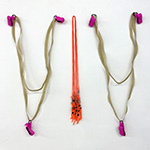
Lev Dance
Created for Valentine’s Day Lev Dance is a piece for 6 people inspired by the contredanse of the 18th century in which the boys and girls connected in a triangle will come together to form a star and interact face to face to then reform a large circle. The sensual and joyful energy that runs through these renewed bonds invites itself between the partners. Lev Dance is built around a choreographic and musical protocol: if the movements of the performers are free, personal and improvised, each participant follows a defined sequence of actions. The musical accompaniment on the guitar is a creation by Kamel Friha for Lev Dance, inspired by the Folia and baroque music: if the theme is precise, it is partly improvised during the performance. [vidéo]
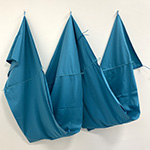
Spin River
Spin River unfolds in space, like a meandering river, a spinal column that articulates. Participants move in a synchronized motion, coordinating their gait to direct the circulation of their common body. I designed Spin River as part of an Art and Sport training organized by the Louvre museum in preparation for the 2024 Olympics to address the collective dimension of sport and allow the public to walk together and reach agreement.
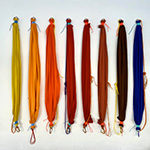
Nappy
Nappy is a vertical hammock designed to relax you. Easily installed on the hook of a wall, on a column or on a tree, Nappy envelops you and helps you to release the body of its tensions in complete safety. Listening to surrounding sounds or music, immerse yourself in relaxation and intimate contemplation. Rehabilitate the nap, take a break, do good, listen to yourself, regenerate to be active again…
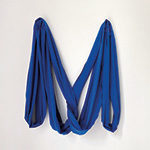
Long Blue
More than an elongated version of Fish Balance, Long Blue is a Moebius ring, cut in the middle, giving two connected Moebius rings. If the bodies are twice as far apart, the effect of connection and containment remains. Made in Lycra, Long Blue can adapt to aquatic incursions and retain all its qualities of elasticity and lightness.
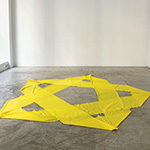
Sun 45
Sun 45 is a five-pointed star drawn with a single line, a looped textile panel. Each body occupyies a corner and circulates the strip continuously communicating the active principle of the form through micro-movements. When the dynamics of the group increase, the star moves, leaving its regular and balanced form to reach other configurations without losing its intrinsic structure. [vidéo]
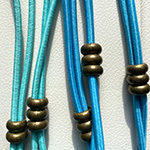
Blue Lime
Produced in partnership with the Louvre Museum and the APHP on the occasion of National Caregivers Day at Sainte-Périne Hospital. The participants, patients and caregivers, are connected in pairs by blue rubber bands at a distance of 2 meters. Held by a bracelet glove system, giving elegance to the hand and the gesture, each participant activates a network of lines that composes a moving net. How to listen to each other, initiate, follow, remain attentive to others, to form a harmonious whole.
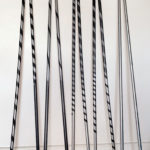
Love Sticks
Love Sticks is a piece made up of thin and flexible metallic and black rods that fit together to form a harmless spear with which the performers come into contact with space and with each other. Its wavy shape reminds the destination of its whirling movement as well as the style of equestrian tournament spears. Improvisation at the Palais Royal gives this performance a majestic dimension in which power and finesse are associated. [vidéo]
 Salmon Ladder
Salmon Ladder
Salmon Ladder is organized like a farandole for 10 to 16 people. A face-to-face encounter occurs in improvised and slow movements, a shared movement follows when it comes to moving forward together. This lively and joyful work is animated by analogies that its structure carries : a ladder, a school of fish, a spinal column, waves that propagate, circuits that connect or even a DNA helix. [vidéo] [vidéo] [vidéo]
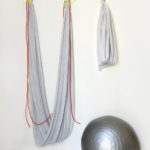 Wet
Wet
Wet is a performance built around three structures, two of which are flexible in mesh and are an extension of the Corps communs. On the same stage, we witness the symbolic representation of the development of a plant around the three characteristic stages of the growth of the plant: the germ, the growth, the flowering. The improvised performance is interpreted here at the Galerie Rue Française by the dancers Clémentine Balair, Isabelle Maurel and Michiko Fou.
 Bee Wave
Bee Wave
Bee Wave is a participatory work designed to generate a collective wandering similar to that of the crowd, the cloud, the wave or even the swarm. Bee Wave is organize with flexible and containing cells. The bodies integrate the structure and together initiate a movement of wandering, it is a question of advancing by adapting over time to the walk of others, to the initiatives of each one, to create together a trajectory in space that we cross. [vidéo] [vidéo]
 CC/4
CC/4
CC/4 is the first of the Corps communs; utopia of a body, made up of several bodies, through which we would move together, would be able to listen, to feel attuned, in harmony. CC/4 makes us experiment and observe how in a figure of four, each body is trained and leads the others, in a feeling of shared movement, slow or fast, according to the dynamics of the improvisation. [vidéo] [vidéo]
 CC/10
CC/10
CC/10 is the continuation of CC/4 on a larger scale and configured in a large circle. Installed in CC/10, it is a question of living with ten people this experience of interdependence in which the Common Body places us. Our desire for movement, our ability to generate action or to confront the inertia of the group. If the experience is human, it is also geometric and variable in size… [vidéo]

Ensemble
Inspired by stick practices (Qi Gong, Akijo, Swedish gymnastic practice, etc.), Ensemble was designed to implement a common, synchronized and complementary movement of the collective body and to find a way to harmonize our movements: to be attentive and to interpret the movements perceived thanks to the elasticity of the links and to adapt to the situations that we go through thanks to our ability to attune. [vidéo]

Tiger Dance
Tiger Dance originates from a representation of a connected body that projects its virtual avatar: the two connected bodies coordinate their gestures in complementarity and in mirror and discover each other by inventing a mimetic and empathetic dance for two. Connected more than a meter away by colored rubber bands fixed to different points of the body (wrists, elbows, ankles, knees, stomach) it is a question of exploring the space of the inciting but always free encounter. [vidéo] [vidéo]
 Fish Balance
Fish Balance
Fish Balance originates in a reminiscence of the representation of matrix linking and cradling. Here the two partners participate in the movement, wave together, trust each other in listening to their micro-movements in a fine attention of soft sensations. The movement can also accelerate when it comes, as with a transmission belt, to lead the other in a common movement. [vidéo]
 Horse Pull
Horse Pull
Horse Pull consists of two individual harnesses in bright and complementary colors. During activation, participants are connected at the waist with belts. This Corps communs is the expression of a balance of power, of a rivalry, which involves physical tension but reversing the values: it is by helping the other in the effort that everyone can achieve their goal. Horse Pull is therefore active in order to make this quality of mutual aid visible through concrete experience.
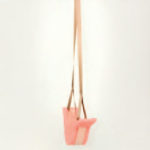 Yllli 1
Yllli 1
At the origin of the Corps communs, there is Yllli (You will like it), a series of three pieces inspired by Yoga, designed to bring physical and mental well-being. With Yllli 1, we are seated and it is a question of concentrating on the alignment of the body, the bottom of the head held by the piece to allow an upright posture as in meditation, which can cause particular sensations of prolongation self.
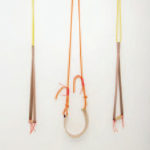 Yllli 2
Yllli 2
At the origin of the Corps communs, there is Yllli (You will like it), a series of three pieces inspired by Yoga, designed to bring physical and mental well-being. Yllli 2 is inspired by Yoga Iyengar. This piece allows you to discover multiple tonic postures with reversal of the body that can provoke new sensations. [vidéo]
Yllli 3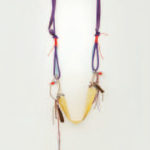
At the origin of the Corps communs, there is Yllli (You will like it), a series of three pieces inspired by Yoga, designed to bring physical and mental well-being. With Yllli 3, the body is held in a miniature hammock, or baby carrier for adults, where it is a question of relaxing and feeling how much this posture invites us to return to intimate states.
 Pyke
Pyke
Pyke is a net seven meters in length, secured to two trees or two bodies. The pink expanse is formed according to the points of attachment and the gentle or powerful wind. An aesthetic and poetic form is traced, flexible or tense, in the visible space of reality. This fishing net in the open air and out of the water is held like a kite and draws lines to the natural space in which it unfolds. [vidéo] — ——- — ——- — ——- — ——-
Paul Ardenne
Art historian, critic and exhibition curator
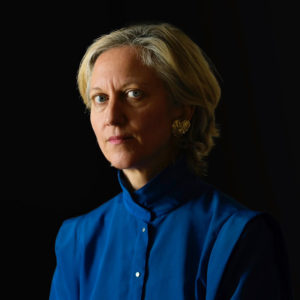
Since 2018, Artist in residence at FAM Sainte-Geneviève, Notre Dame du Bon Secours (Paris) with the Culture & Hôpital association
• Creation of 2 collective and participatory works in situ with residents and staff of the FAM
• Different projects carried out with individual residents
Since 2021, collaboration with the Louvre Museum – Education democratization accessibility program (Sub-directorate of public development and artistic and cultural education)
• Louvre workshops outside the walls, creation of guidance with the work Bee Wave to raise awareness of the Radeau de la Méduse by Théodore de Géricault
• Creation of Blue Lime – a performance between residents and carers as part of National Carers’ Day at Sainte-Perrine hospital (Paris) and in connection with the Louvre museum’s traveling exhibition “Autour du bleu”
• Participation in the Art and Sport training program (2022-2024) with a view to the Olympic Games in Paris. Responsible for the collective dimension and team spirit of sporting activity
2023 Spin Light Duo, à la galerie Xippas pendant l’exposition de Santidio Pereira
2023 Spin Field, autour du Grand Palais Ephémère, pendant Paris+ Art Basel
2023 Fashion Show UAMEP, Palais Galliera, Paris
2023 Journées Européennes du Patrimoine, Palais Galliera, Paris
2023 « Canopées » participatory work at FAM Ste Geneviève, Paris
Le Cœur, Marousia Rebecq, Charlotte Ardon
Galerie du Buisson, Barbara Tannerie
CAC La Traverse, Bettie Nin
Théâtre de Gennevilliers, Adeline Diouf
Cassini, Isabelle Boccon Gibod
Galerie Rue Française, Bonnie Tchien
Université Paris 1, Yann Toma
Mont St-Michel, Isabelle and Marc de Luca
CND et CNSMDP, Magali Brument Charti
Le Salon H, Yael Halbertal, Philippe Zagouri
Galerie 24 Beaubourg, Louis Laurent Bretillard, Mijo Roussel
IMA, José Manlius
–
Paul Ardenne, Ingrid Boccon Gibod
–
Florent Audoye, Clémentine Balair, Vanina Bartoli, Carlos Beltran Gomez, Emilie Benoist, Magali Brument, Maya Coline, Adeline Diouf, Michiko Fou, Jef Gleich, Gaëlle Guillou, Aurélie Herbet, Caroline Ibos, Ivana Adame Makac, Isabelle Maurel, Davide Napoli, Pierre Pays, Nicola Ross, Camilla Santos, Charlotte Tassin, Anaëlle Topin, Elisabeth Vallaud, the dancers, the participants
Photographs
Denis Boussard, Cécile Champy, Guillaume Dimanche, Stas Kalashnikov, Sarah Roshem, Chantapitch Wiwatchaikamol
Design: Alain Choukroun, www.ckn.fr
